
Sign up to RVT’s Insight Weekly Newsletter to get blog posts and more

5 Great Solar-Equipped or Solar-Ready RVs …

5 Great Solar-Equipped or Solar-Ready RVs
If you’re looking for a suitable travel trailer for your trekking and camping adventures, perhaps you might want to consider one that is pre-wired and/or already equipped with solar panels. With a solar system, you are more assured of reliable power while you’re adventuring off-grid — and all you need is daylight.
To make your search for a solar-ready RVs little easier, here is a look at a few interesting RVs which are solar equipped or solar ready as chosen by an Insight RV Blog from RVT.com reader.
2017 Dutchmen Aerolite 2320BHSL

Have you ever dreamed of traveling green? Then, Dutchmen may just be a great travel companion for you.
This particular model is designed to be energy efficient. With its dark-tinted windows, you can keep the summer heat out of your coach which saves on air conditioning power usage. And, with The Aero Tech package, your Dutchmen Aerolite is prepped for solar power as well, so, if you choose to add solar, you can quite comfortably “power up” your family using only natural sunlight.

Attractive exterior graphics package

Spacious kitchen and dining room

Fully equipped kitchen

Great bunk beds feature in the back
Here’s a short video. Beautiful interior of this 2017 Dutchmen-Aerolite 2320BHSL.
See all Brand New Dutchmen-Aerolite 2320BHSLs
Shop all Pre-Owned Dutchmen Aerolites (may or may not be solar-ready or equipped)
Northwood Snow River 234RBS
Northwood RV claims to provide both comfort and luxury with their 2017 Snow River 234RBS trailer. Under its appealing design, these units boast block foam insulation which is vacuum-bonded to ensure campers can enjoy their Travel Trailer throughout the year.
An important feature of this model is that it comes equipped with solar wiring and with a 20 W solar panel. It’s good to know that when you’re camping off-grid in your 2017 Northwood Snow River, you’ll be able to switch on the lights and some other electric features without having to start the generator.

Handy, spacious kitchen and dining room

Entertainment unit, TV

Master bedroom
Shop all 2017 Northwood Snow River 234RBS
Browse all Northwood Snow River RVs (may or may not be solar-ready or equipped)
View all Northwood RVs (may or may not be solar-ready or equipped)
2017 Pleasure-Way Plateau XLMB

Pleasure-way is known for custom Class B motor coaches built on Chevrolet, Ford, and Mercedes chassis.
The company’s standards of quality control are unmatched as they put every single motor home through rigorous test processes. Their test process involves auditing the work of each craftsman involved in building the units. Also, the company prides itself on having a top-notch dealer network so buyers can always get help when needed.
The 2017 design of Pleasure-Way’s Plateau XLMB comes with an interesting addition. It has a 285 Watt Solar package, which is great for lighting, for your electronic gadgets or entertainment system when you take this luxury Class B into more remote areas without access to shore power.
With a sleeping capacity of 2, it makes a perfect bridge between a Class B and Class C motor coaches in terms of size.

A very appealing modern design with comfortable seating and working areas

Fantastic new modern LED lighting

This sitting area converts to sleeping using the handy fold down Murphy bed on the wall

Lots of room for your next road trip
Shop all Pleasure Way Plateaus (may or may not be solar-ready or equipped)
Browse all Used Pleasure Way Plateaus (may or may not be solar-ready or equipped)
See all New 2017 Pleasure Way Plateaus XL MB
2017 Airstream Basecamp

The focus of the Basecamp is to provide the camper with a close-to-home environment while you’re on the road. Its design is dramatic, and it’s certain to trigger adventure.
The Basecamp is sturdy and compact. It is only 16’ 3” long but can easily tote items like bicycles, fishing equipment, and kayaks.

Floor plan layout
The front windows of the 2017 Airstream Basecamp are curved and tinted, small storage compartments are well thought out and conveniently arranged. You’ll also enjoy amenities like a hot shower which can help make life comfortable for you and your crew while venturing.

Kitchen with wide windows to see the gorgeous views
To make sure the fun continues even after electricity supply interruption, this roaming habitat is wired for solar power on the rooftop. It also comes with a 160w solar power package, with an option to upgrade to an AGM battery.

Great appliances to help you in the kitchen

Lots of room for bikes, kayaks, fishing equipment, etc. to make a solar buff’s off-grid adventures memorable.
Shop all AirStream Basecamps
Look up Airstream Dealers here .
2017 Forest River Sonoma Explorer Edition 270BHS

Sonoma travel trailers by Forest River are designed to make camping convenient. Sonoma is known for its “flipped axles” which give you improved ground clearance so you can consider RV’ing into rougher terrains. These trailers are designed, with long-lasting aluminum framing, large tank capacities and fitted with LED lighting which can be powered by a battery.
2017 Forest River Sonoma Explorer Edition 270BHS has full solar installation and a 200W panel to make your stay in remote areas as convenient as possible.

The grand floor plan

A nice slide out to give you extra space

Pleasant kitchen and dining room

Fancy fully equipped kitchen with a modern back splash
Enjoy this quick Video Tour. It gives you a great look inside The Forest River Sonoma Explorer Edition 270BHS
Shop all Forest River Sonoma Explorer Edition 270BHSs
Check out all Forest River Sonomas
Browse all new Forest River Travel Trailers for sale on RVT.com
As consumers continue to opt for more sustainable energy sources, solar power for your RV is increasingly becoming a viable option and something to seriously consider as you shop for your next home-away-from-home.
Author Bio – Adam Hammill – President/CEO of ALIVE SOLAR After 11 years of researching alternative energy, Adam discovered a way of combining existing technologies to create a clean, chemical energy storage system for home use which is reported to be twice as efficient as systems currently available.
Share this article:
I’m looking for a new RV bunk bunkhouse looking to have solar panels fifth wheel sleeps 7
Great question! Lots of Makes and Models of new 5th wheels come standard now-a-days already wired for solar — both roof and ground solar.
One (of many!) ways to find them is to make use of the Search functions on RVT.com to filter down until you find some you like.
First sort your Search by 5th wheels and type “bunk” into the keywords field. You’ll find lots! From there, you can further narrow down your Search by choosing only NEW (under Condition.)
Next, identify a Make and Model you like and run a Search for just that Brand. Then change out the word “bunk” in the keywords field for the word “solar.” Now you can read through those Listings and find out if each unit is solar-ready and / or already solar equipped, depending on your preference.
Hope this helps, Bruce! And, happy RV shopping!
I want to convert my 2009 Keystone Everest 5th wheel 50 amp trailer to solar.
Leave a Comment
Your Comment
XHTML: You can use these tags: <a href="" title=""> <abbr title=""> <acronym title=""> <b> <blockquote cite=""> <cite> <code> <del datetime=""> <em> <i> <q cite=""> <s> <strike> <strong>
Sign me up for the newsletter!
Recently Listed RVs

- Buying & Selling
RVT.com Quick Links
- Sign Up RVT
- Press Releases
Find us on Facebook
Copyright 2024 Insight RV Blog from RVT.com /" title=" Theme by DesignerThemes.com"> Theme by DesignerThemes.com
Rig Roundup: 7 Best RVs for Going Off the Grid
It's worth researching a variety of trailers before choosing your next rig. Here are some of the best off-grid travel trailers on the market right now.
By Roadtrippers
Thanks to their mobility and self-contained nature, RVs are ideal for creating unforgettable adventures, even far from traditional campgrounds. Luckily there are many lightweight travel trailers specifically designed for off-grid RV excursions. And good news for your wallet—many of them can be towed with an SUV, so no truck purchase is required to tow your new trailer.
Important Features to Look for in Off-Grid RVs
If you want to leave the campground in your rearview mirror and head off the grid, it’s important to purchase an RV that’s designed for rugged terrain and boondocking conditions. Here are some features that will keep you safe and comfortable even while camping far from shore power and bathhouses.
12-Volt and Propane Appliances
When you can’t hook up to shore power, you’ll want your refrigerator, cooktop, oven, and TV to work on 12-volt batteries or propane gas. Avoid residential appliances as they will require a more robust energy draw.
Solar Prewiring or Manufacturer Solar Packages
If there is even a small possibility that you will add an aftermarket solar package, make sure you look for an RV that is prewired for solar. Better yet, find one that is prewired for an inverter as well, which will allow you to use 110-volt power even while boondocking. Many of the RV models featured in this roundup offer roof-mounted solar kits as optional upgrades. We highly recommend choosing the manufacturer packages when available.
Large Fresh Water Tanks
The size of your fresh water tank is an important consideration when camping off the grid. These tanks vary greatly in size from trailer to trailer, so make note of this feature when shopping. You’ll see that within this article’s featured RVs, the fresh water tanks are anywhere from eight gallons to 55 gallons, which is a large variance within the same class of travel trailer.
Large Gray Water and Black Water Tanks
The bigger your gray and black water tanks are, the longer you can use your sink, shower, and toilet without needing to dump them. Note that some travel trailers within this category won’t have any gray or black water tanks, some have combo tanks, and others have separate tanks that are up to 30 gallons each. Pick a model that suits your needs.
Robust Frames and Raised Axles
If you want to take your travel trailer down unpaved roads and over rugged terrain, make sure you look for solid framing and raised axles that provide plenty of ground clearance. Many trailers in this class also offer all-terrain tires as either standard or an optional upgrade.
Off-Grid Travel Trailers We Love
Does an off-grid trailer fit your lifestyle? These travel trailers are some of the best on the market and will make your next boondocking or off-roading adventure more comfortable.
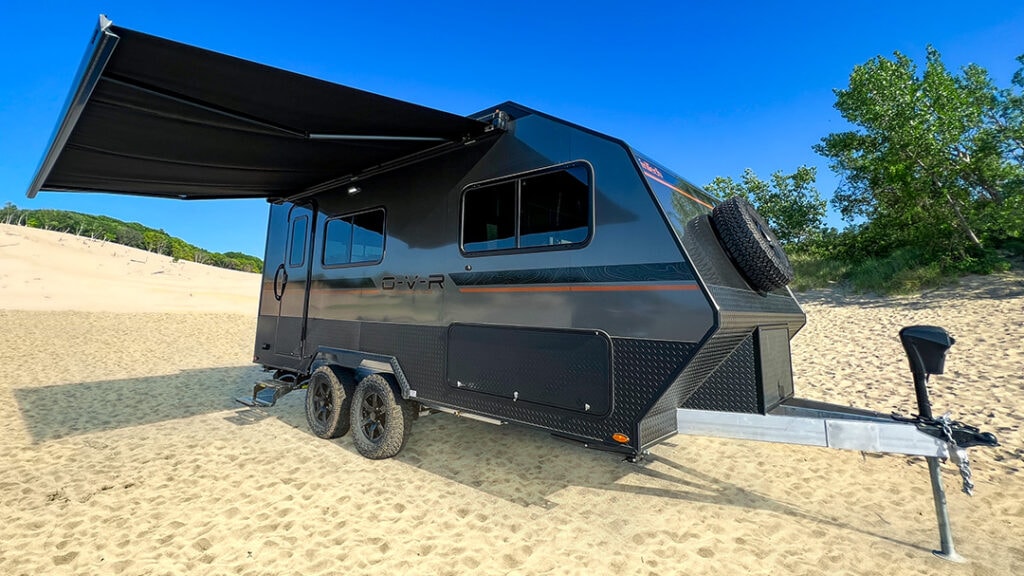
inTech O-V-R Expedition Off-Grid Travel Trailer
The latest off-roading lineup from inTech makes off-grid adventures comfortable and spacious for the whole family. The O-V-R lineup offers three models, ranging from a toy hauler to the smaller, 5,200-pound Expedition travel trailer. When purchased with inTech’s off-grid package, this rig comes with 400 watts of solar power, a 200-amp hour lithium battery, and a 2,000-watt inverter charger.
The interior features a spacious U-shaped dinette, a full-size kitchen with a farmhouse sink, two twin-sized beds, an optional drop-down bunk bed, and a large wet bath. Plus, there’s plenty of storage space throughout, and the dinette can also be used for sleeping space.
Features and options we love for off-grid adventures:
Although this rig is equipped to take you to remote destinations, the interior provides all of the comforts that you’d expect from a travel trailer. Plus, with the optional drop-down bunk, you’ll have plenty of room to bring the kids along for your adventures.
More information on this off-grid travel trailer can be found here .
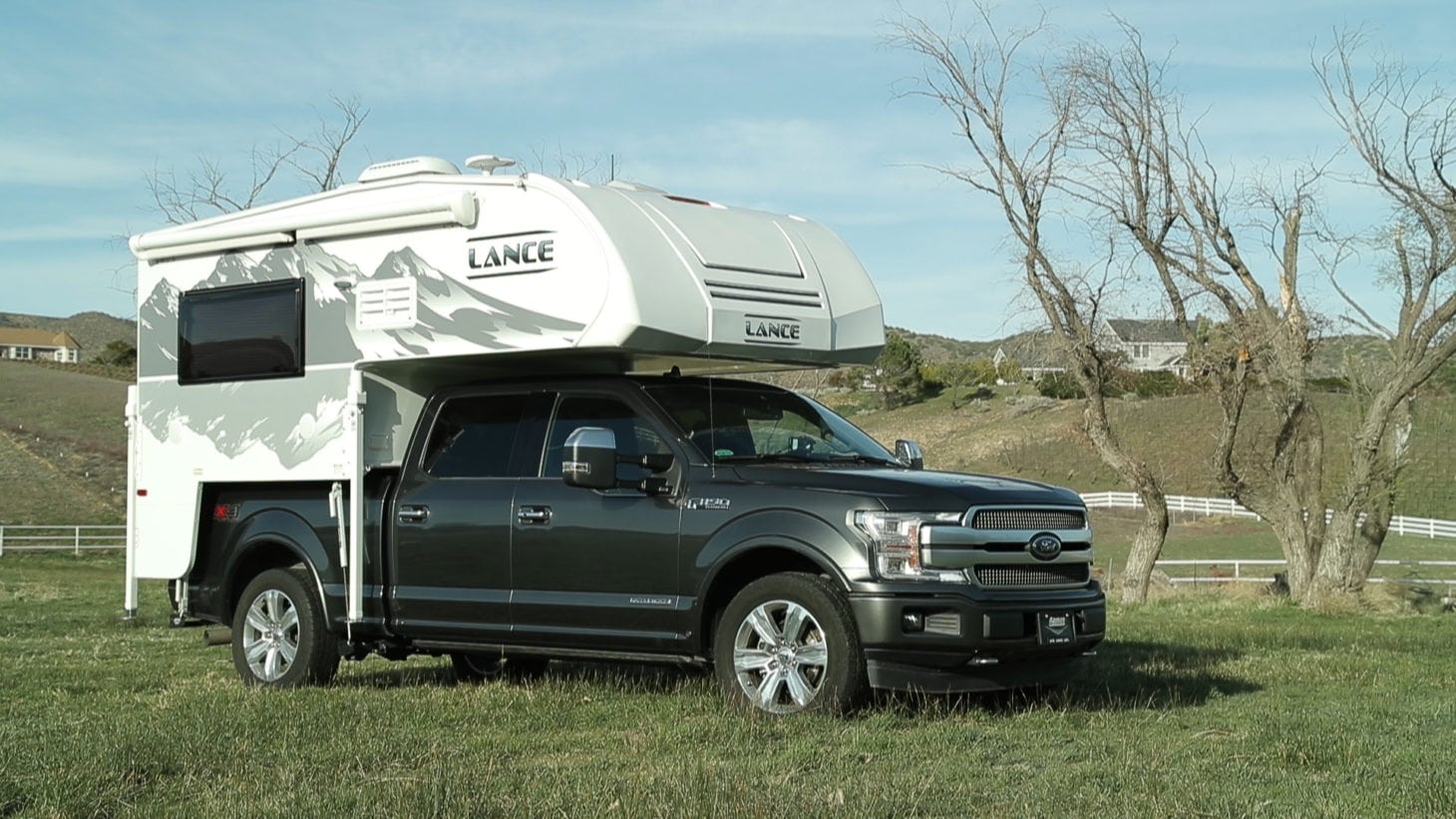
Lance Truck Camper
The 650 Truck Camper was designed by Lance for short-bed, half-ton trucks. The standard package offers ducted heat, a marine toilet, and pre-wiring for a solar panel. The three-way refrigerator and selection of 12-volt, USB, and 110-volt outlets will allow you to keep everything powered whether you’re hooked up at a campground or dry camping. If you’re just beginning your hunt for a truck camper, Lance has a helpful and detailed compatibility guide .
Think about adding the 100-watt solar panel and lithium battery if you plan to boondock, and the 19-inch, 12-volt TV if you still want to enjoy the creature comforts of home.
More information on this off-grid travel trailer can be found here .
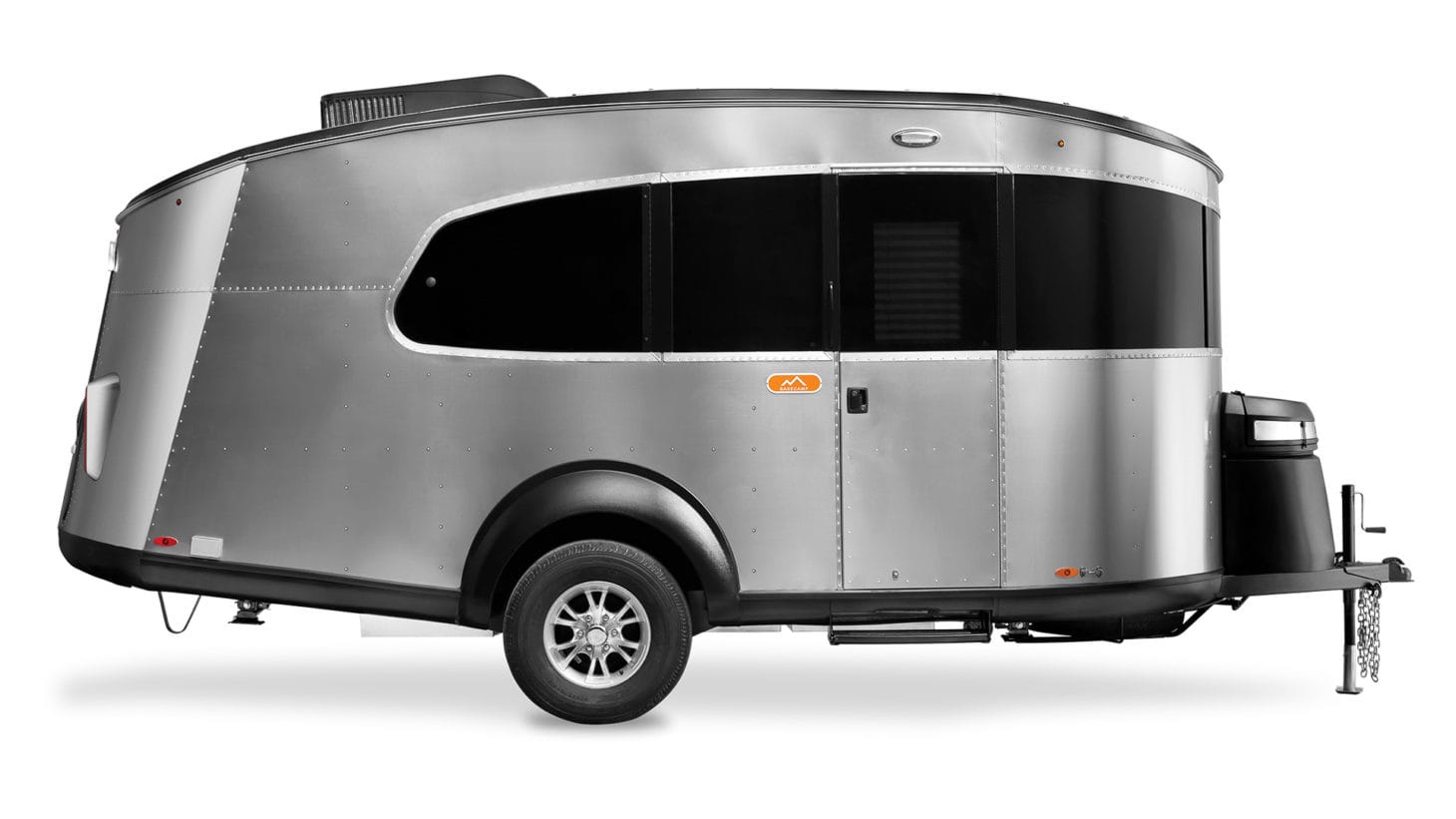
Airstream Basecamp
The Basecamp trailer is designed to pair well with midsize SUVs that many off-road adventurers already own. Large wheels, side skirts, and wheel flares protect the camper from the gravel and debris on unpaved roads. There are four different floor plans available, ranging from 16 to 20 feet in length, and all versions include an onboard restroom with a toilet and shower. Goodyear tires and 12-volt tank heaters also come standard.
Buyers can upgrade to a 200-watt solar package. Get extra ground clearance with the Basecamp X-Package, which features a 3-inch lift, Goodyear Wrangler tires, and a raised hitch jack pad.
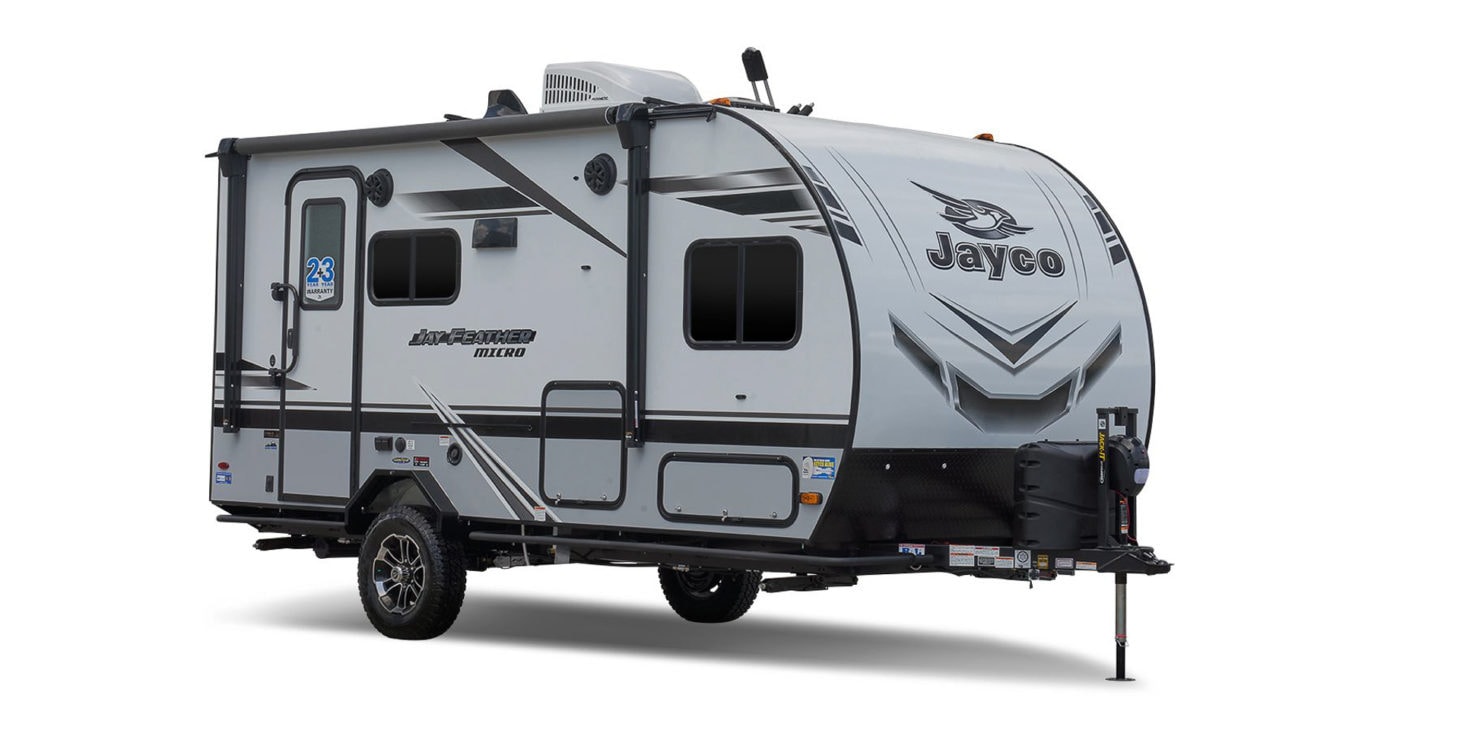
Jayco Jay Feather Micro
Introduced in 2021, the Jayco Jay Feather Micro lineup features four different floor plans designed to take you off the beaten path, while still providing a high level of comfort. The 166FBS has 16-inch diameter Goodyear tires with reinforced wheel wells and is prepped for roof-mounted solar power and prewired for an inverter. It also contains a 55-gallon fresh water tank. The JayPort external propane connection makes it easy to hook up the included 17-inch grill.
Features and options we love for off-grid adventures :
One optional solar power package includes a 200-watt solar panel and a 30-amp controller, and another adds the 1,800-watt inverter. Add a Thule roof rack system or bike storage rack if you like to travel with your toys.
Winnebago Micro Minnie FLX
The Winnebago Micro Minnie FLX trailer lineup consists of four different floor plans that range from 22 to 22.5 feet in length. The H172BH is particularly attractive to adventurous couples or small families, offering bunk beds and a large dinette with bed conversion.
At less than 22 feet long and less than 4,200 pounds in dry weight, the Micro Minnie FLX is easy to tow for most SUVs and Trucks.
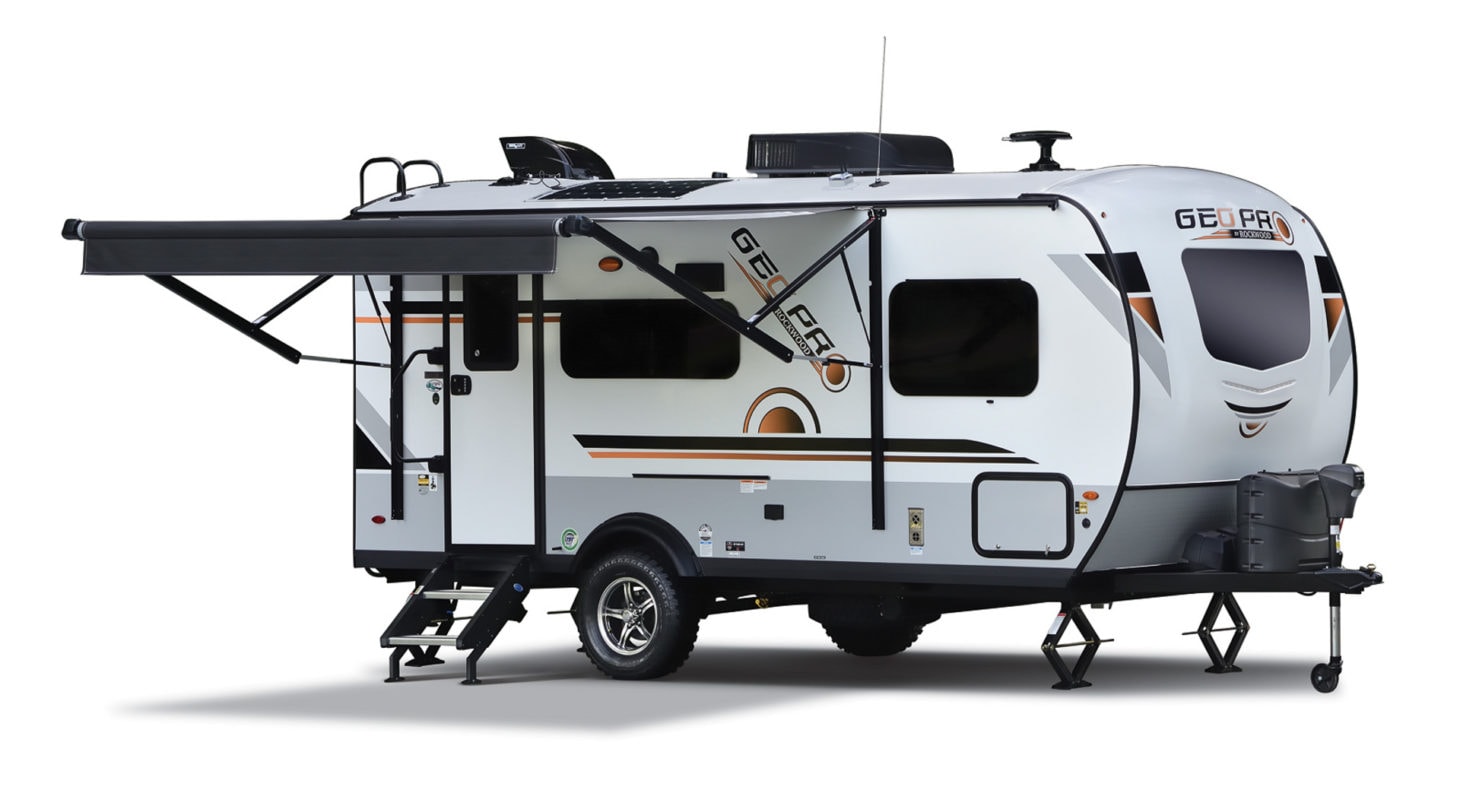
Rockwood Geo Pro
The Rockwood Geo Pro offers a wide range of floor plans, from a 15-foot travel trailer to a 20-foot toy hauler. The entire series comes equipped with 200-watt, roof-mounted solar panels and a 1,000-watt inverter. Most models offer a 12-volt TV, Teton All In One Wi-Fi Booster with LTE Prep and Antenna, and Showermiser water conservation system. The G15TB floor plan has rear twin-sized beds that can convert into a king-sized bed depending on what layout you need.
Buyers can add on Pro Rac mounting bars, a removable ladder, a second 200-watt solar panel, and a tongue-mount bike rack.
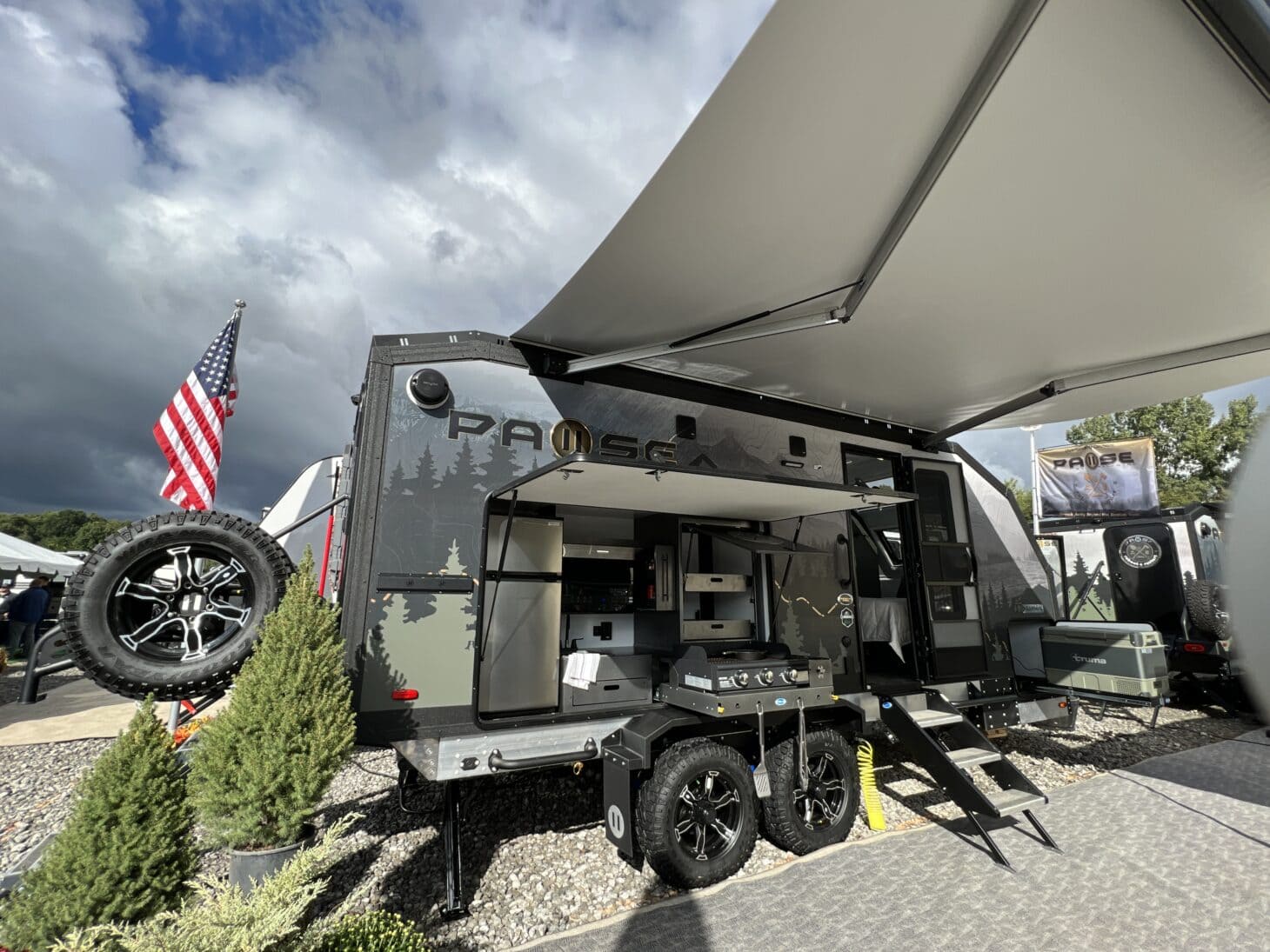
Palomino Pause Travel Trailer 20.3
While some details are yet to be released, this off-roading rig is already causing a stir. The Pause is perfect for solo travelers or couples looking to go off the beaten path. Ruggedly constructed with an aluminum frame; composite walls, flooring, and roofing; and independent suspension, this towable is built to handle all of the bumps and turns of an off-road adventure. The cozy, stylish interior comes with a spacious dry bath, a full-sized kitchen with bar seating, and a foldable queen-sized bed that’s perfectly placed under a large dual-pane window for stargazing. An integrated Garmin navigation system comes standard on all models, as does 200 watts of solar power, a 400-amp hour Lithium battery, and a 3,000-watt inverter charger.
The dry weight of this rig is expected to be nearly 7,000 pounds, and the anticipated MSRP is projected to be more than $100,000.
FEATURES AND OPTIONS WE LOVE FOR OFF-GRID ADVENTURES:
The Pause comes with an offboard air compressor for easy tire inflation and deflation, and the outdoor kitchen comes fully equipped with cooking space, storage, a sink, and a fridge. You can also upgrade your solar package to 1,000 watts.
A Note on Rig Specs
It’s important to pay close attention to specs when shopping for a travel trailer. Use the VIN (vehicle identification number) to find the towing capacity and payload capacity for your specific tow vehicle.
GVWR (Gross Vehicle Weight Rating)
The maximum loaded weight of your trailer as determined by the manufacturer. You should never exceed this weight rating when your RV is stocked with all of your gear, propane, and fresh water.
UVR (Unloaded Vehicle Rating)
The weight of your trailer as manufactured with no cargo, propane, or water.
CCC (Cargo Carrying Capacity)
This is the difference between your UVR and your GVWR, telling you how much weight you can safely add to your trailer. Pay close attention to the cargo carrying capacity if you intend to travel with a lot of gear.
Tongue Weight
This is the amount of weight pressing down on the hitch ball that is attached to your tow vehicle. It is extremely important to make sure that the tongue weight of a travel trailer does not exceed your tow vehicle’s payload capacity.
Disclaimer: Roadtrippers is part of a joint venture, partially owned by Thor Industries, Inc., of which Airstream and Jayco are subsidiaries.
Meet the Author

Roadtrippers
Roadtrippers helps you find the most epic destinations and detours—from roadside attractions to natural wonders and beyond.
Get the most inspiring stories from the road sent directly to your inbox.

- Sign up Log in Sign out
- Log in Sign out
Plan your journey, find amazing places, and take fascinating detours with our app.
If you used to sign in with Roadpass, you should now use the same username and password to log in directly with Roadtrippers above.
We couldn't find an existing Roadtrippers account using that service. Please try signing in with another option.
We need your email address to send you trip itineraries and other updates.
How do you want to plan your trip?
With just a few questions, our newest Premium feature, Autopilot, will plan your next adventure.


You are here: Home // RVs With Built-In Solar: A Guide To The Best Models For 2024
This post may contain affiliate links or mention our own products, please check out our disclosure policy .
RVs With Built-In Solar: A Guide To The Best Models For 2024
Published on October 26th, 2023 by Emily Lawrence
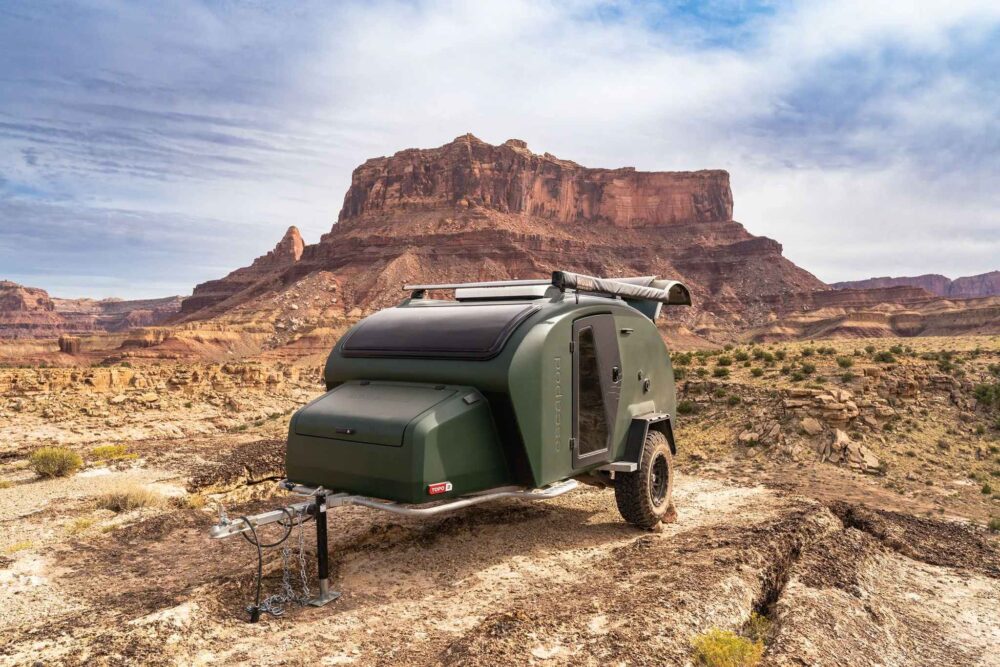
Travel Trailers With Built-In Solar Power Systems: A Guide To 2024 Models
Solar power’s rise in popularity spans various industries, and the RV sector is no exception. Just a few years ago, incorporating solar technology in RVs was either an elusive luxury or an expensive upgrade. Yet, as 2024 beckons, an array of brands are unveiling models decked with built-in solar panels, inverters, and more, broadening the horizon for enthusiasts.
If you’re scouring the market for a travel trailer that self-generates energy, there’s an expansive selection of solar-powered options awaiting discovery. These models span diverse sizes and price brackets, ensuring there’s a fit tailored for every budget.
Why consider solar-powered RVs?
Opting for an RV with an integrated solar setup can significantly transform your travel experiences. Whether you harbor aspirations of untethered off-grid escapades or simply seek that supplementary power reservoir during trips, solar-equipped RVs are a boon.
DON’T MISS OUT ON DO IT YOURSELF UPDATES
Sign up for the newsletter today.
Please enter a valid email address.
An error occurred. Please try again later.

Thank you for subscribing to the Do It Yourself RV newsletter, keep your eye on your inbox for updates.
To aid your quest, we’ve sifted through the multitude to curate a list of standout solar-powered RVs slated for the upcoming year. From household names to hidden treasures, there’s a world of choices. Let’s delve in!
Travel Trailers with Built-in Solar Power
Escapod topo2.
- Solar power: 140 watts
- Exterior length: 12 feet, 3 inches
- Unladen vehicle weight: 2,000 lbs.
- Hitch weight: 200 lbs.
- MSRP: $43,990
The Escapod TOPO2 is a compact teardrop trailer that’s brimming with potential. Effortlessly towable behind various vehicles, this model is tailored for off-road adventures. While its solar panels cap at 140 watts, it’s aptly sufficient for a trailer of this stature.
Inside, you’re treated to a cozy sleeping area, complemented by a strategically designed heated mudroom at the entrance. This ensures you don’t drag in muck or wet footwear. To top it off, the trailer’s rear unveils a nifty kitchenette primed for outdoor culinary adventures. Dive deeper at escapod.us .
Winnebago HIKE 100 H1316SB
- Solar power: 200 watts
- Exterior length: 15 feet, 11 inches
- Unladen vehicle weight: 3,122 lbs.
- Hitch weight: 576 lbs.
- MSRP: $49,125
Several Winnebago trailers now come equipped with built-in solar panels, including the HIKE 100 H1316SB. The 200-watt solar panel delivers reliable power, with an option for customers to have an additional panel installed.
Despite its size, the interior doesn’t compromise on space. Features include bunk beds, a rollover sofa, a folding table, a wet bath, an interior kitchen, and ample storage space. It’s ideal for small families venturing into off-grid camping. Discover more in the Winnebago HIKE series at winnebago.com .
BRS Offroad Pursuit
- Solar power: 300 watts
- Exterior length: 19 feet
- Unladen vehicle weight: 3,527 lbs.
- Hitch weight: 350 lbs.
- MSRP: $110,000
The BRS Offroad Pursuit is an Australian-crafted camper embodying the spirit of wilderness adventures. The creators affirm that “…nobody heads into the wilderness to sit in a 5-star hotel.” Crafted for the avid adventurer, its 300-watt solar panels and substantial water tanks keep you outdoors longer.
Yet, the interior is comfortably appointed. Every model boasts a queen-size mattress, a complete shower, and a kitchen equipped with a four-burner cooktop, among other amenities. Numerous external features further enhance the camping experience. Discover more at brsoffroad.com .
TAXA Mantis
- Solar power: 150 watts
- Unladen vehicle weight: 3,115 lbs.
- Hitch weight: 435 lbs.
- MSRP: $40,116
The TAXA Mantis may be compact, but it’s brimming with features. Alongside its 150-watt solar capability, it offers sleeping quarters for over four adults, a multipurpose desk for remote tasks, and a versatile floor plan.
Unique to the Mantis is a pop-out roof, affording extra headroom upon settling into a campsite. It’s the perfect fit for adventurous groups or families. Dive deeper at taxaoutdoors.com .
Rockwood Geo Pro G20FKS
- Exterior length: 21 feet, 2 inches
- Unladen vehicle weight: 3,971 lbs.
- Hitch weight: 573 lbs.
- MSRP: $31,997
The Rockwood Geo Pro is compact yet features an expansive floor plan, thanks to a slideout and added external features.
Inside, the trailers come with a queen-size bed with an overhead bunk. Other highlights include a dry bath, a spacious sofa, an L-shaped kitchen, and abundant storage. Explore the Rockwood G20FKS and its variants at forestriverinc.com .
Living Vehicle HD24
- Solar power: 600 watts
- Exterior length: 24 feet
- Unladen vehicle weight: 11,000 lbs.
- Hitch weight: 1,100 lbs.
- MSRP: $299,995
The Living Vehicle HD24 is a cut above the rest, tailored for prolonged off-grid travels. Its 600-watt solar panels can sustain up to a week of energy, with specific trims extending this to a month or longer.
Its interiors are just as captivating—with a foldable patio deck, a luxurious bathroom, and a versatile rear room serving as a secondary bedroom, laundry, or workspace. While this trailer is a premium offering, the quality is unparalleled. Explore more at livingvehicle.com .
Palomino Pause 20.3
- Exterior length: 25 feet, 2 inches
- Unladen vehicle weight: 7,859 lbs.
- Hitch weight: 840 lbs.
- MSRP: $119,995
The Palomino Pause 20.3, with its formidable solar setup, stands out for its unique features. Internal and external drop-down bars with stools and a full-width rear bathroom are just the start. Storage solutions are plentiful, with an enclosed rear space and front pass-through sections. Find out more at palominorv.com .
Black Series HQ21
- Exterior length: 27 feet
- Unladen vehicle weight: 6,742 lbs.
- Hitch weight: 670 lbs.
- MSRP: $59,899
Concluding the list is the expansive Black Series HQ21. Its 600-watt solar panels are perfect for extended trips. Interiors feature a full-size bed, a snug couch, and a partitioned bathroom. Notably, its design facilitates off-road ventures—a remarkable feat for its size. Discover more at blackseries.net .
Related articles:
- What Is The Best Boondocking RV For 2021?
- What You Need To Know About RV Solar Power
- What Are The Advantages Of A Lithium RV Battery?
Share this post:
Related posts:.

Stuck with an Old Travel Trailer? Here’s How To Make It Work

Road Trip Ready: How To Choose the Best RV for Your Lifestyle
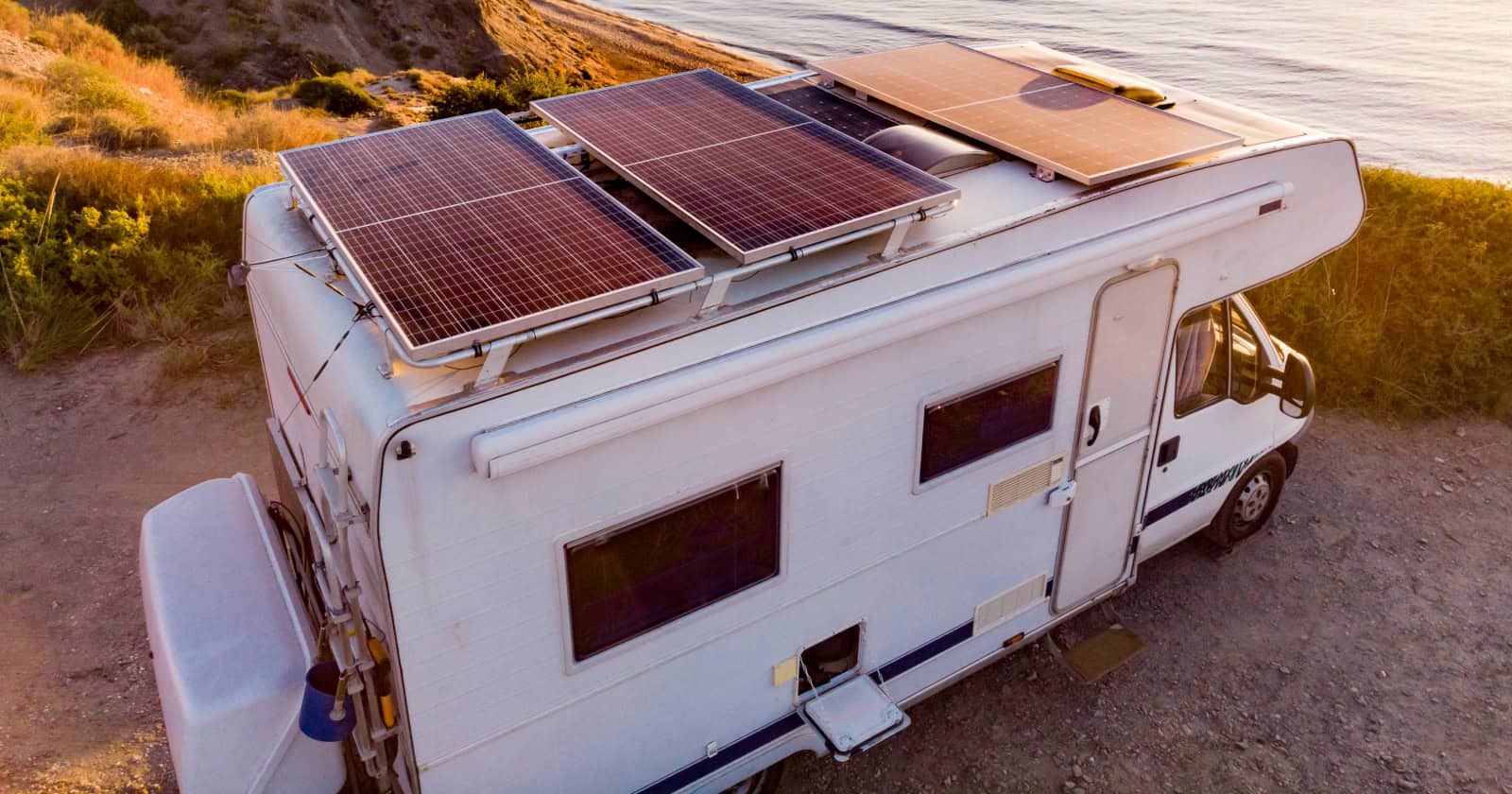
10 Things That Can Ruin Your RV Solar System
Your cart is empty
Have an account?
Log in to check out faster.
Estimated total
Free Shipping + Money Back Warranty
Country/region
- Australia USD $
- Canada CAD $
- France USD $
- United States USD $
- Afghanistan USD $
- Åland Islands USD $
- Albania USD $
- Algeria USD $
- Andorra USD $
- Angola USD $
- Anguilla USD $
- Antigua & Barbuda USD $
- Argentina USD $
- Armenia USD $
- Aruba USD $
- Ascension Island USD $
- Austria USD $
- Azerbaijan USD $
- Bahamas USD $
- Bahrain USD $
- Bangladesh USD $
- Barbados USD $
- Belarus USD $
- Belgium USD $
- Belize USD $
- Benin USD $
- Bermuda USD $
- Bhutan USD $
- Bolivia USD $
- Bosnia & Herzegovina USD $
- Botswana USD $
- Brazil USD $
- British Indian Ocean Territory USD $
- British Virgin Islands USD $
- Brunei USD $
- Bulgaria USD $
- Burkina Faso USD $
- Burundi USD $
- Cambodia USD $
- Cameroon USD $
- Cape Verde USD $
- Caribbean Netherlands USD $
- Cayman Islands USD $
- Central African Republic USD $
- Chile USD $
- China USD $
- Christmas Island USD $
- Cocos (Keeling) Islands USD $
- Colombia USD $
- Comoros USD $
- Congo - Brazzaville USD $
- Congo - Kinshasa USD $
- Cook Islands USD $
- Costa Rica USD $
- Côte d’Ivoire USD $
- Croatia USD $
- Curaçao USD $
- Cyprus USD $
- Czechia USD $
- Denmark USD $
- Djibouti USD $
- Dominica USD $
- Dominican Republic USD $
- Ecuador USD $
- Egypt USD $
- El Salvador USD $
- Equatorial Guinea USD $
- Eritrea USD $
- Estonia USD $
- Eswatini USD $
- Ethiopia USD $
- Falkland Islands USD $
- Faroe Islands USD $
- Finland USD $
- French Guiana USD $
- French Polynesia USD $
- French Southern Territories USD $
- Gabon USD $
- Gambia USD $
- Georgia USD $
- Germany USD $
- Ghana USD $
- Gibraltar USD $
- Greece USD $
- Greenland USD $
- Grenada USD $
- Guadeloupe USD $
- Guatemala USD $
- Guernsey USD $
- Guinea USD $
- Guinea-Bissau USD $
- Guyana USD $
- Haiti USD $
- Honduras USD $
- Hong Kong SAR USD $
- Hungary USD $
- Iceland USD $
- India USD $
- Indonesia USD $
- Ireland USD $
- Isle of Man USD $
- Israel USD $
- Italy USD $
- Jamaica USD $
- Japan USD $
- Jersey USD $
- Jordan USD $
- Kazakhstan USD $
- Kenya USD $
- Kiribati USD $
- Kosovo USD $
- Kuwait USD $
- Kyrgyzstan USD $
- Latvia USD $
- Lebanon USD $
- Lesotho USD $
- Liberia USD $
- Libya USD $
- Liechtenstein USD $
- Lithuania USD $
- Luxembourg USD $
- Macao SAR USD $
- Madagascar USD $
- Malawi USD $
- Malaysia USD $
- Maldives USD $
- Malta USD $
- Martinique USD $
- Mauritania USD $
- Mauritius USD $
- Mayotte USD $
- Mexico USD $
- Moldova USD $
- Monaco USD $
- Mongolia USD $
- Montenegro USD $
- Montserrat USD $
- Morocco USD $
- Mozambique USD $
- Myanmar (Burma) USD $
- Namibia USD $
- Nauru USD $
- Nepal USD $
- Netherlands USD $
- New Caledonia USD $
- New Zealand USD $
- Nicaragua USD $
- Niger USD $
- Nigeria USD $
- Norfolk Island USD $
- North Macedonia USD $
- Norway USD $
- Pakistan USD $
- Palestinian Territories USD $
- Panama USD $
- Papua New Guinea USD $
- Paraguay USD $
- Philippines USD $
- Pitcairn Islands USD $
- Poland USD $
- Portugal USD $
- Qatar USD $
- Réunion USD $
- Romania USD $
- Russia USD $
- Rwanda USD $
- Samoa USD $
- San Marino USD $
- São Tomé & Príncipe USD $
- Saudi Arabia USD $
- Senegal USD $
- Serbia USD $
- Seychelles USD $
- Sierra Leone USD $
- Singapore USD $
- Sint Maarten USD $
- Slovakia USD $
- Slovenia USD $
- Solomon Islands USD $
- Somalia USD $
- South Africa USD $
- South Georgia & South Sandwich Islands USD $
- South Korea USD $
- South Sudan USD $
- Spain USD $
- Sri Lanka USD $
- St. Barthélemy USD $
- St. Helena USD $
- St. Kitts & Nevis USD $
- St. Lucia USD $
- St. Martin USD $
- St. Pierre & Miquelon USD $
- St. Vincent & Grenadines USD $
- Sudan USD $
- Suriname USD $
- Svalbard & Jan Mayen USD $
- Sweden USD $
- Switzerland USD $
- Taiwan USD $
- Tajikistan USD $
- Tanzania USD $
- Thailand USD $
- Timor-Leste USD $
- Tokelau USD $
- Tonga USD $
- Trinidad & Tobago USD $
- Tristan da Cunha USD $
- Tunisia USD $
- Türkiye USD $
- Turkmenistan USD $
- Turks & Caicos Islands USD $
- Tuvalu USD $
- U.S. Outlying Islands USD $
- Uganda USD $
- Ukraine USD $
- United Arab Emirates USD $
- United Kingdom USD $
- Uruguay USD $
- Uzbekistan USD $
- Vanuatu USD $
- Vatican City USD $
- Venezuela USD $
- Vietnam USD $
- Wallis & Futuna USD $
- Western Sahara USD $
- Yemen USD $
- Zambia USD $
- Zimbabwe USD $
- X (Twitter)

Off-Grid Camper
Couldn't load pickup availability
Off-Grid Solar Trailer that is ultralight and easy to tow. The ultimate solar powered off-grid camper for adventurers seeking the roads less traveled. GoSun Camp365 is fully equipped with essential solar appliances for cooking, refrigerating, showering, climate control (optional) and sleeping at remote locations or campsites. USA Manufactured.
Custom Edition Production Models. Estimated Available approximately 90 days after full payment is received. No coupons apply.
After $500 order fee is paid, contact [email protected] for questions, delivery updates, optional accessories, shipping options, and balance payment schedule.
Weight & Dimensions
Cabin interior max length: 8' 5" Cabin interior max width: 11' 8" Cabin Interior max height: 7' 6" Cabin Interior living space: 700 cubic ft. Exterior max width: 71.5" Exterior max height: 10' Exterior road and trail height 6' 8" Ground clearance: 11.25" Road mode length: 15' 6" Unloaded base trailer weight: 1,495 pounds Gross vehicle weight rating: 2,200 pounds
Towing Capabilities: Independent torsion axle suspension 12" wheels with high speed tires for highway travel Powder coated aluminum chassis, steel axle and tongue 11.25" standard ground clearance Swing away trailer jack with 12 height adjustment Electric: Tow vehicle connection recharges battery while hauling 8,000 BTU air conditioner 580W fast heating ceramic electric heater with thermostat 30Amp city or campground electric hook up GoSun Power1100 powerbank - lithium ion Solar ready up to 30Amps Main cabin interior LED and storage lighting(x2) SolarPanel 100Watt Solar Table 120Watt 12VDC - 5 outlets; 110VAC 2 outlets; USB-C PD, and USB - 6 connections Insulation, Ventilation, & Shade: Hard wall composite insulation on end side walls and doors (Approximate R value of 7) Puncture resistant, translucent, waterproof marine grade roof Dual layer insulation system for hot or cold weather Five tinted glass and screened windows Dual 38" x 26" mesh windows with sun shades Two 58 x 95 extendable side awnings Setup, Cleanup, & Takedown: Seven Point Leveling System on dirt, mud, snow, and sand Connects to a standard 2" ball hitch Marine grade composite flooring Gas shock assisted exterior side wall lift system Rear hatch transforms into interior & exterior table Folding Beds: queen bed 60" x 80" or two twins 30" x 60"
What's included
GoSun Chill GoSun Power 1100 GoSun Solar Panel 100 (x2) GoSun SolarTable 120 GoSun Fusion GoSun Brew (x2) GoSun Heated Blanket (x2) GoSun Breeze (x2) GoSun Flow & Flow Pro Cassette Toilet Air Conditioner Inflatable Bed Frame (x2) Inflatable Sleeping Pads (x2) Air Pump 12V Propane Water Heater Shower Curtain Large Storage Duffel Bags (x2) Ceramic Space Heater - 1500W
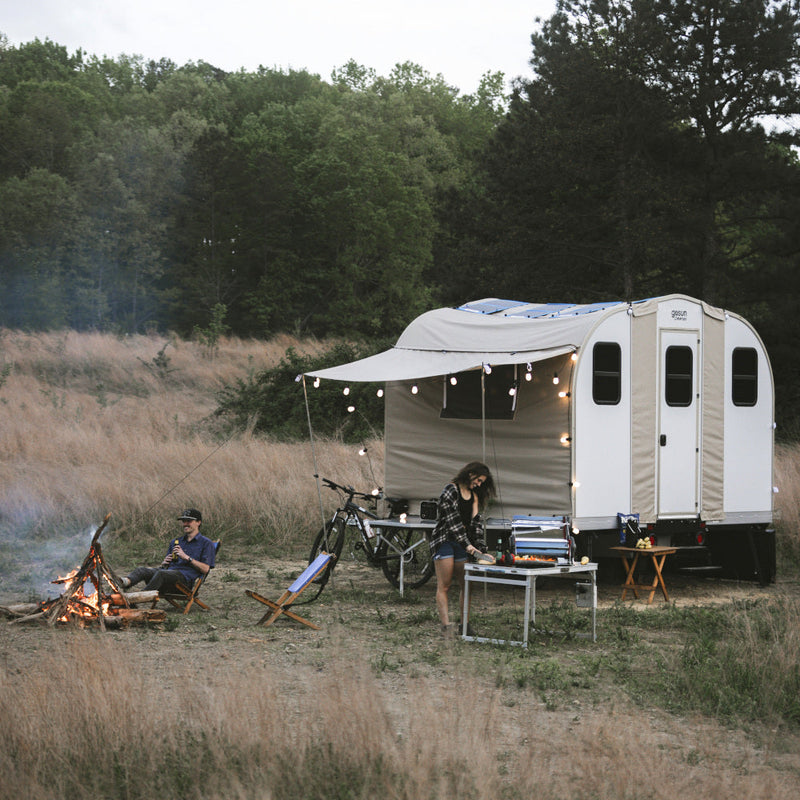
Quick & Easy Setup
One person can pop-up or down in less than 10 minutes
Off Grid Ready
Complete solar setup brings comfort and reliability anywhere
Aerodynamic & Lightweight
Sleek, sealed outer shell allows for easy towing and stowing
Built to Last
Made without wood, or canvas, so there is no rust, mold, or rot
Wake up with nature
A one of a kind off-grid cabin on wheels, completely integrated with GoSun's breakthrough solar products. Innovative design and super efficient appliances allow you to go much further than traditional campers and RV’s.
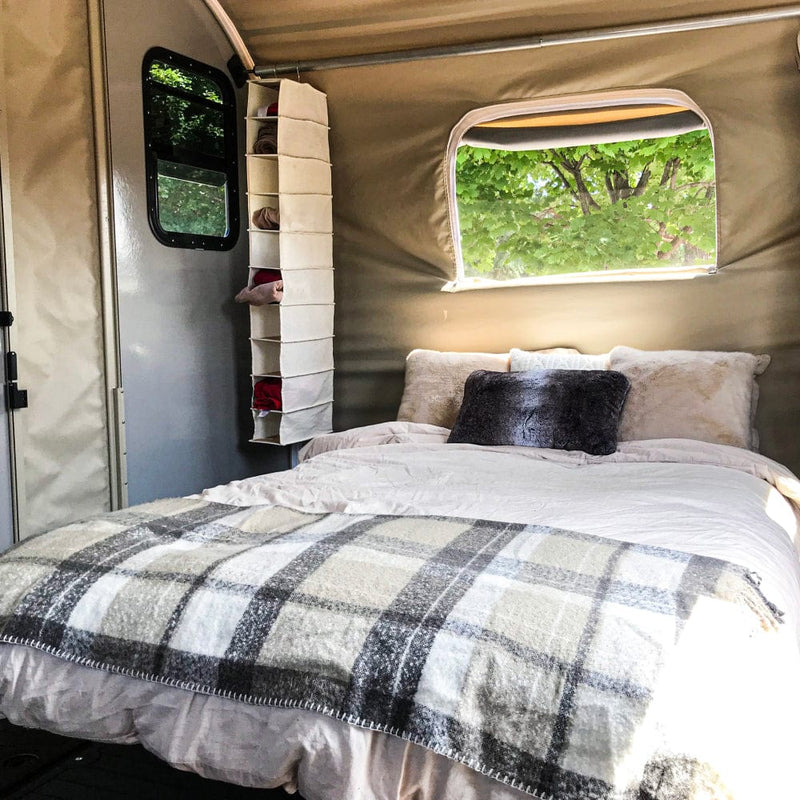
Compact, Lightweight, and Easy to Tow
The all aluminum frame provides durability while weighing less than 1,800 lbs. Superb aerodynamics mean less drag and much better gas mileage.
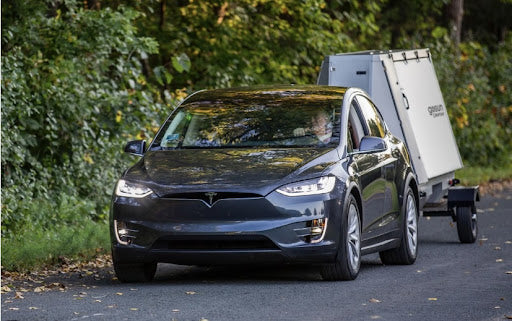
Built to Last, and Last
Lifetime cost of ownership is much lower when you are saving costs on maintenance, fuel, storage, and campground fees. High tech materials remove decay from the equation while the closed camper is sealed from the elements.
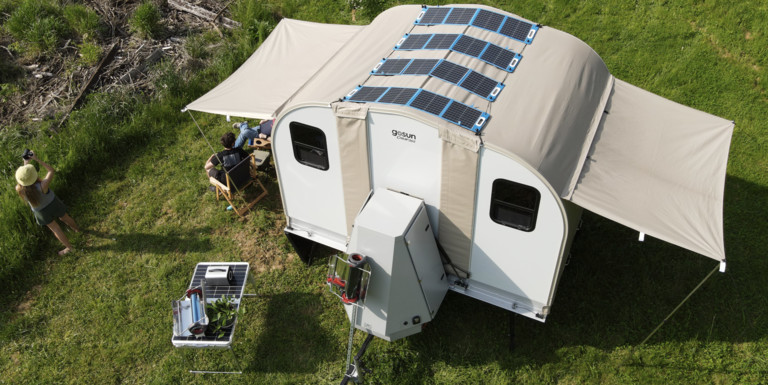
Camp off-grid. Anywhere. Everywhere.
Complete with all the appliances you need to adventure further and more often. It’s time to consider traveling lighter, easier, and with more freedom - all powered by the Sun.
How we compare
There's only one GoSun
GoSun designs for maximun fun and resilience. Camp365 helps elevate your camp experience and provides the freedom of going off-grid. With the best portability possible in an RV, it's a great fit for your daily driver.
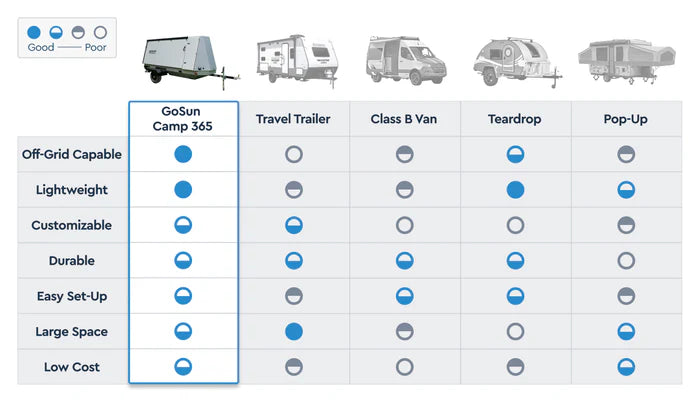
Top Down View
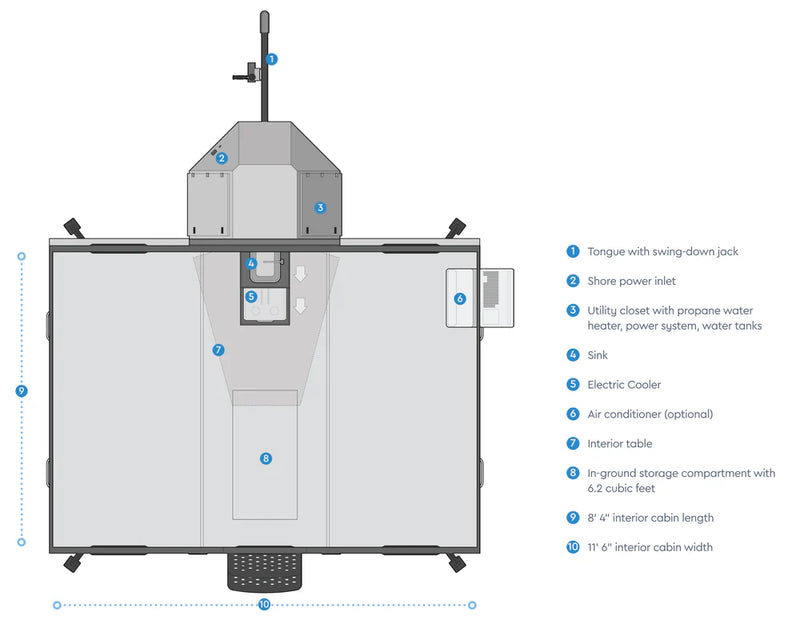
The Camp 365 features 30 cubic feet for storing all of the necessities.
Up to 6 adults can fit in the Camp 365.
Camp365 camper has been engineered with a low center of gravity, aerodynamic design for slipstreaming and remarkable fuel economy and electric battery range with all towing vehicles. Even if you’ve never towed a vehicle before you will find this simple and easy.
Most people can easily do it in less than 10 minutes! It’s “lift-assisted.” If you can push a vacuum cleaner, you can level out your GoSun Camp365 cabin. If you’re a sole traveler you’ll be surprised and delighted to learn that one person can open/close the trailer.
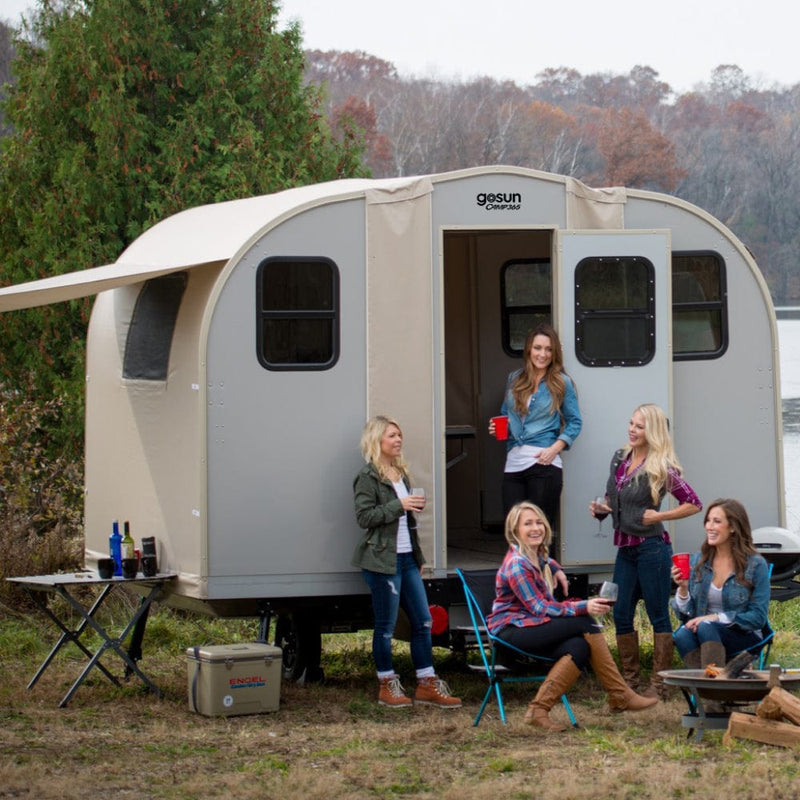
- Choosing a selection results in a full page refresh.
- Opens in a new window.

Solar Travel Trailers: Guide to Choosing the Best

Solar is a relatively new topic.
After all, at the age of three, my father installed four massive solar panels on my childhood home back in the early 80s. Heck, he was quite progressive! While solar panels are not new themselves, using solar panels on travel trailers is – and it’s changing the way we live and travel.
A properly designed solar system is not a simple “one and done” solution. I’ve seen countless manufacturers put one or two solar panels on the roof of their RV and call it “solar-powered.” The unfortunate reality is this could not be further from the truth.
There are so many industry buzzwords floating around that it can be quite challenging to understand what solar means. My goal is to explain what it means to have solar power and what you can expect to gain from a properly designed solar system. After all, how does a solar-powered travel trailer benefit me?
I’ve broken it down into three straightforward concepts to help understand exactly what solar power does and how it benefits the travel trailer owner’s day-to-day life.
The top three considerations for finding the best solar powered travel trailer while traveling off-grid are:
Location and Size of the Solar System
- Battery & Inverter System
- Backup Power Generation

As an architect, when designing a solar-powered brick and mortar home, the location and orientation of the solar panels with relation to the sun are critical to maximizing the capture of energy. In the northern hemisphere, a north-facing wall or roof surface will receive very little if any sun exposure at all when the foundation is affixed to the ground.
While these design features remain true, this is not nearly as important on a solar-powered travel trailer.
Trailers are constantly moving, and the relative position to the sun depends on the exact position of the trailer at any given moment. Thus, solar panels are typically placed flat on the roof to take advantage of the widest range of solar conditions that you may come in contact with while traveling.
If you find solar panels on a wall, I encourage you to silently chuckle inside as the designer clearly cares more about how the solar panels “look” rather than how they function. After all, you can’t see solar panels up on a roof of a solar-powered travel trailer.
Solar panels are only effective when the sun is overhead. Solar panels become significantly less efficient when the sun is low in the sky.
This is called the “angle of incidence.”
The most effective a solar panel will ever be is when the sun is directly above or perpendicular to the solar panel. Even in the sunniest of environments, the early morning and late evening hours will not provide much solar power. For this reason, we typically calculate an average of 5 hours of sun per day. More sun = more power, simple. One area we can control how much power is captured is to increase the exposed area of solar panels. One simple way to accomplish this is to put as many solar panels as possible upon that horizontal roof surface. When the sun is directly overhead, more solar panels = more electricity generated. To put this into perspective, high draw appliances like microwaves, air-conditioners, and hair dryers use about 1,000 watts of power at any given time. If you have a 1,000-watt solar system, you are supplying around enough power to make one of those appliances run. But what if you have a 2,000-watt system? What happens to all that extra power?
That’s where batteries come into play.
If you capture more than you use, the excess is stored in a rechargeable battery system to keep that power to be used at a later time – like, night, for example.
For a truly solar powered off-grid travel trailer , you will need at least 1,000 watts to accomplish the basic tasks required to stay off-grid for short periods of time. If you’re looking to extend that time to weeks, months, even indefinitely, you’re going to need 2 or 3 times more than that.
Based on an energy calculator created by Living Vehicle, about 3,000 watts of power is more than enough to run almost all appliances that are required on a day-to-day basis, indefinitely.
That means you will never need to plug into shore power – as long as the sun is out.
Battery System
Now that we have all those beautiful solar panels on the roof, capturing power whenever the sun is shining, we need a place to put all that energy. Batteries are a topic in and of itself, and we could talk for days about the size, chemistry, efficiency, etc. For our purposes, I’ll make it simple. I recommend as big of a battery system as you can fit, afford, or otherwise get your hands on. Think of your battery system as you would a gas tank on a motor vehicle. The larger the gas tank, the longer you can go – and the fewer stops you need to make between trips to the gas station.
Except, in the case of a solar-powered trailer, that gas station is directly above you at all times when the sun is out. It’s a beautiful thing.
The reason I recommend a large battery system is because the sun does not always shine. I have traveled days, even weeks at a time when I did not see the sun. Not one watt of power entered my energy system from the solar panels. So, I had to rely on the energy stored when the sun was out. The more energy I had, the longer I could go before recharging. Batteries, or energy packs, are measured in how many watts they may store over a period of time. This is measured in kilowatt-hours. In simple terms, if that 1,000-watt array of solar panels is exposed to the sun for one hour, it will store 1,000-watt-hours, or one kilowatt-hour (kWh) of energy. Use this power as you would! But when it’s gone, it’s gone – you must recharge.
Of course, there are times when the sun just doesn’t come out – winter, for example. I’ve traveled up in the pacific northwest and didn’t see the sun for weeks at a time. There’s only so much energy conservation I was able to do before I simply ran out of power while traveling. This is where backup power generation comes into play.

Backup Power Generation
Having a backup power supply at the ready is nothing new in the recreational vehicle industry. It’s so common that many luxury RV’s , travel trailers, and campers have a primary source of power – a generator.
There are all different types of motor-driven electric power generators, but they all do the same thing – make electricity.
One issue I have with this concept is that manufacturers have relied so heavily on these generators that they have now become the primary source of power when away from shore power. This is a flawed approach, in my opinion.
Generators are an excellent piece of equipment, supplying high amounts of electricity at the push of a button – but there are downsides to generators too. They are noisy, smelly, and often can’t be used where you’re traveling.
Many national parks only allow using generators for one or two hours a day. That’s not a great spot to be in if a generator is your primary source of power.
When you combine a solar-powered travel trailer with a generator, the primary source of power becomes the sun. When the sun is out, power is freely flowing (and yes, that was a pun). There’s nothing better than free, clean, and silent power. Of course, the sun does not always shine, and it’s a beautiful thing to have planned for that moment. Backup power generators at the ready, capable machines ready to supply power at a moment’s notice. Now there are other types of backup power generators besides the common gas- or diesel-powered units, and they take all shapes, sizes, and kinds. One of my favorites is leveraging the engine of the tow vehicle. After all – the trailer does not have an engine itself and requires a tow vehicle to move. The installation of a high-voltage alternator in the tow vehicle may quickly and efficiently recharge an entire trailer energy system in a matter of hours.
It’s a great way to take advantage of what’s already there.
In the end, solar systems are an excellent addition to solar-powered travel trailers. Properly designed, they allow you to harness the seemingly free and unlimited resource of the sun’s power and go farther than ever before possible. When you are hundreds or even thousands of miles away from the nearest gas station, solar power is available. With enough solar panels, a large enough battery pack, and backup power generation when the sun doesn’t shine, that solar travel trailer can go farther than ever before possible. Now that’s freedom.
- Electric Travel Trailers Guide
- Luxury Travel Trailers Guide
- Off-Grid Travel Trailers Guide
- Living Vehicle Vs. Other Trailers
.jpg)
Luxury Fifth Wheels vs Travel Trailers: Know the Differences
Explore the disparities between luxury fifth wheels and travel trailers. Learn the key distinctions between both.

The Top 10 Electric RV Features to Look For
Learn the top 10 electric RV features to look for. Get the most of your travel experience with these features.

Top 8 Features to Look for in 5th Wheel RVs
Learn the must-have features of 5th-wheel RVs. Uncover the top 8 essentials to look for before making your purchase.
Lighter in weight and secured with a hitch to the frame of your tow vehicle.
Full-sized campers, requiring the “5th wheel” U-shaped hitch to tow.
Can be a travel trailer or fifth wheel. Designed with a rear garage and opening for your “toys.”
- Heartland Difference & Innovations
- Factory Tours
- RV Lifestyle
The promise of adventure drives every RV journey. Nobody knows this better than us.
- Owner's Manual
- MyHeartlandRV App
- Owners Club & Forum
- FAQ's and RV Glossary
- How to Videos
- Towing Guide
- Apparel Store
Heartland Owners Club & Forum
The Heartland Owners Club is made up of RVers from all walks of life, all on different paths on their RV journey. The club holds regular rallies and events across North America and allows you to tap into a vast amount of information curated by experienced RVers.
- FIND A DEALER
Powered by the Sun
Travel is a time for more exploration. More fun. More memories– but adding and using solar energy to power your RV is even better. Our new solar-powered RV packages, Sol – Powered by the Sun, make it easier than ever to harness solar power for your next trip. With three solar-powered RV systems to choose from, you can have a solar package that supplements your typical energy use, or go for a higher tier that powers your RV when you camp off-grid.
Energy Savings
Cut your energy costs by keeping batteries charged with free solar power.
Using freely available solar power can keep your batteries charged while lowering your energy costs. And the initial investment in solar panels, batteries, an inverter, etc., will more than pay for itself in the gas and electric it saves you over the coming years.
Low Maintenance
Once your solar package is installed, they require very little upkeep and work for years. Most of the labor of upgrading to solar power happens right upfront. Once you install your solar panels, batteries, inverter, and wiring, you’re good to go. Solar energy systems are so low maintenance, your biggest concern will be keeping the panels clean to absorb as much light as they can – which a good rain shower will take care of on its own.
Travel Flexibility
Solar expands your camping options by giving you greater freedom to go off-grid. Whether you want to camp in style, get way off the beaten path, or just have the flexibility to go where the wind takes you, solar power is an asset. It can help power all your appliances, while saving energy. It can allow you to camp off-grid for longer, using sun to meet your energy needs. Or it can give you the freedom to not make a plan, knowing you’ll have power wherever you go.
Quiet + Ecofriendly
You’re in the great outdoors to get away from man-made noise – and generators can be loud. But with solar energy, you can have a totally silent way of storing and using energy. Every element of solar power is noise-free, which means you can tune into the natural world in peace.
Reliable Power
Did you know that fewer than 1% of solar panels fail in any given year? That level of unmatched reliability is what makes solar power so popular with campers. There aren’t too many things in this world that you can depend on – but your power source on the road should be one of them.
Introduction to SŌL
Why should i choose solar power.
Campers of all kinds can benefit from the unique qualities of solar energy. It’s particularly good for off-grid camping, allowing you to generate power wherever you park.
How Does Solar Energy Work?
Unlike generator power, your RV doesn’t run directly off of solar energy. Instead, the solar panels convert sunlight into direct current (DC) electricity, which is stored in onboard batteries. That means you’ll have energy banked to use overnight or on bad-weather days.
What are the tiers for Sol - Powered by the Sun?
Every current Heartland RV comes SOL Prepped. That means you can add solar panels, batteries and an inverter on every one of our models.
Campers of all kinds can benefit from the unique qualities of solar energy. It’s particularly good for off-grid camping, allowing you to generate power wherever you park. That means fewer calculations about which appliances to run and for how long when you’re boondocking. Solar power is environmentally friendly and renewable, which not only cuts costs, but helps protect nature for future generations of campers.
Unlike a generator’s loud buzz, solar energy is totally noiseless. And all the work to access solar energy is upfront – once you have solar panels and an inverter installed, the system will work for years with nearly zero upkeep. A good rainstorm every now and then keeps the panels clean from dust and pollen, so your panels capture as much sunlight as possible. Finally, solar energy is flexible. Not only can it expand your camping options, but you can choose configurations that supplement your typical energy use with solar, or use it to replace other forms of energy entirely.
Unlike generator power, your RV doesn’t run directly off of solar energy. Instead, the solar panels convert sunlight into direct current (DC) electricity, which is stored in onboard batteries. That means you’ll have energy banked to use overnight or on bad-weather days.
Then, an inverter installed in the RV converts DC electricity to alternating current (AC), which is the type of electricity used in residential homes. DC electricity powers elements of your RV like slideouts, lights, power awnings and fans. But household appliances typically use AC electricity, which means the inverter allows you to use solar energy to power things like your electrical outlets, microwave, washer and dryer, hair dryer, coffee maker and more.
All units are solar prepped
- All wiring for solar panels, inverter and battery power - panels, inverter and batteries not included
- Dedicated housing for inverter and transfer switch
- 30-amp charge controller
- Up to 8 outlets prepped
- Ability to add up to 2 x 190-watt panels - requires 12 sq. ft. for each panel
SŌL 190 includes:
- 190-watt monocrystalline solar panel with mounting brackets and roof docking port
- 30 amp flush mount solar charge controller
- Up to 8 outlets prepped for solar energy
- Pre-wired inverter fuse kit to connect inverter
SŌL 190 does not include a battery, inverter or transfer switch, you’ll need to purchase them separately. Please contact a battery dealer for more information or to purchase a battery.
SŌL 190 can upgrade to SŌL 380 by adding an additional 190 watt solar panel and an inverter with transfer switch.
SŌL380 includes:
- 1 x 330 watt monocrystalline solar panels with mounting brackets and roof docking port
- 30 amp flush mount solar charge controller
- 2000 watt power inverter (may include a remote control based on location within RV)
- External transfer switch
- Up to 8 outlets connected
- This package is only available on Heartland 5th Wheel Toy Haulers
- Lead Acid batteries are included on some 5th wheel units.
- 2 x 190 watt monocrystalline solar panels with mounting brackets and roof docking port
- 30 amp PWM flush mount solar charge controller
If you need to purchase a battery, please contact a battery dealer for more information or to purchase a battery.
Currently all charge controllers are pre-programmed for Lithium batteries, unless a battery is supplied.
SŌL 380 currently does not have upgrades available.
Have Questions?
View our solar options page to learn more about our offerings and find solar resources.
Contact Us About Solar
If you would like to place an order for solar components, please fill out the contact form and a parts representative will be in contact with you shortly. Please note, we do not sell batteries, please consult with AIMS Power.
- Home Energy & Utilities
Solar Panel Buying Guide for RVs and Travel Trailers: What You Need to Know
Whether you're living that mobile, off-grid lifestyle or just want power for the occasional camping trip, solar panels on your RV can keep you powered up and comfortable.
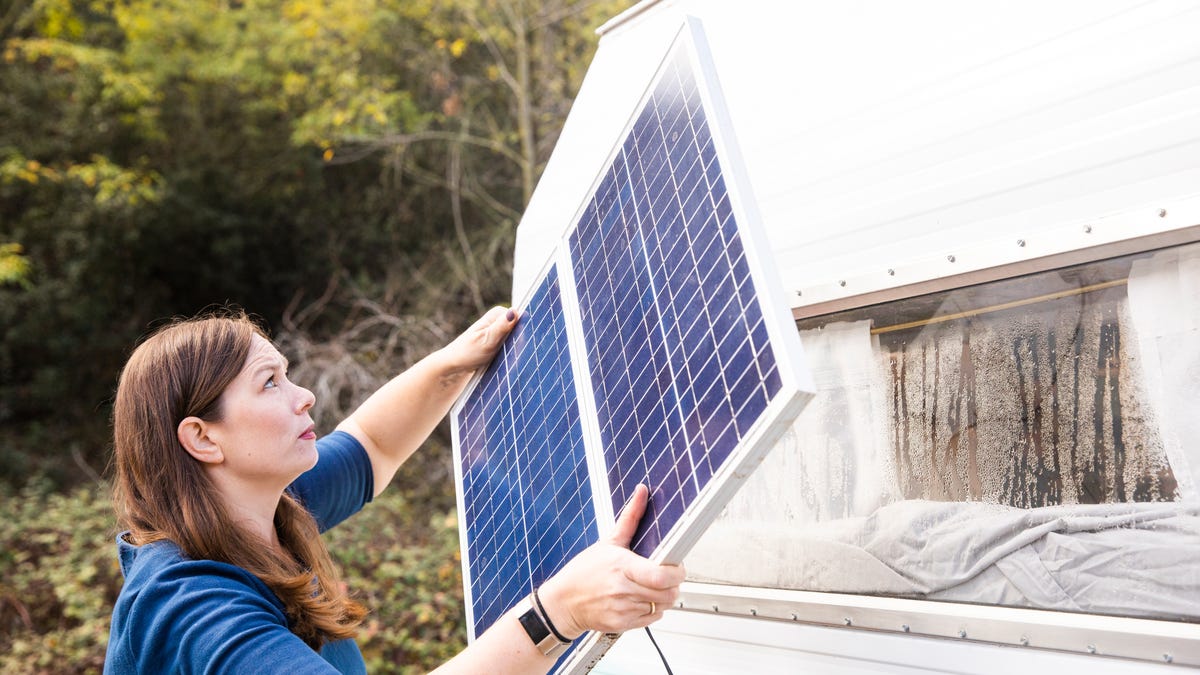
Interested in outfitting your camper with solar panels? Start here.
In recent years, more people seem to be living and working from the road than ever before, whether it's in a large RV, travel trailer or camper van. To maximize the freedom of such a lifestyle, having a reliable source of electricity is imperative, and few sources are better than the massive ball of fire that rises in the east each morning.
Adding a solar energy system to your home office on wheels has become markedly easier and cheaper, but there are still plenty of choices, questions and considerations that aren't always so straightforward. We've put together this quick guide with the help of a pair of seasoned pros to determine if solar is right for your ride.
What are RV solar panels?
RV solar panels work just like residential and commercial solar panels except on a smaller, more transportable scale. Once they're installed on your RV, motor home or camper, solar panels collect sunlight and convert it into usable electricity for your vehicle. In turn, you can use this electricity to power the appliances, lights and sockets in your RV.
Can solar panels save you money?
Interested in understanding the impact solar can have on your home? Enter some basic information below, and we’ll instantly provide a free estimate of your energy savings.
There are a number of reasons to add solar panels to an RV, travel trailer or camper. The most obvious is that traveling around often means spending the night in places where there's no easy access to the electrical grid. The most adventurous among us today manage to live and work full time from the road, making solar all but a requirement.
"We knew we wanted to go solar to save money, be off grid and live the lifestyle we wanted and live more sustainably," Shari Galiardi told CNET via Zoom from an off-grid campground in British Columbia.
Galiardi and her partner, Dave Hutchison, have lived and worked full-time from a restored 1957 camper trailer since 2012 with the help of a 300-watt solar system. They told me that while the lifestyle is certainly different from that of the average person, they don't feel as though they're sacrificing very much.
The couple rarely camp places that have power hook-ups, preferring to be off-grid. Hutchison estimated that once in a year they'll plug into an electric outlet at a campsite.
"Usually, that's because it's all that's available," he said.
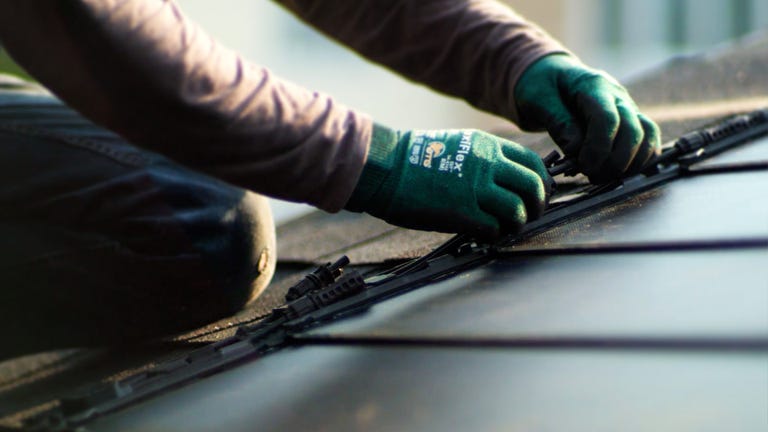
Can RVs use residential solar panels?
It is possible to mount regular rectangular rooftop solar panels on an RV, trailer or van. This author has done so twice. However, it isn't the most aerodynamic arrangement.

Considering Solar Panels?
Galiardi and Hutchison use flexible, lightweight panels that can contour to a vehicle's roof and also add less weight to the top of a trailer. There are a number of products that can work with RVs, including portable panels that can be set up on the ground at your destination.
Read more : Best Portable Power Stations
How many RV solar panels do you need?
Unlike residential and commercial solar systems, which are designed to power an entire home or business, RV solar systems typically deliver a more modest output. This usually isn't an issue, since you don't use as many lights and appliances in your RV as you would in a brick-and-mortar property.
So how many solar panels will you need for an RV? It depends on a few factors, including your energy consumption habits, the efficiency of the panels and the amount of sunshine your home receives each day.
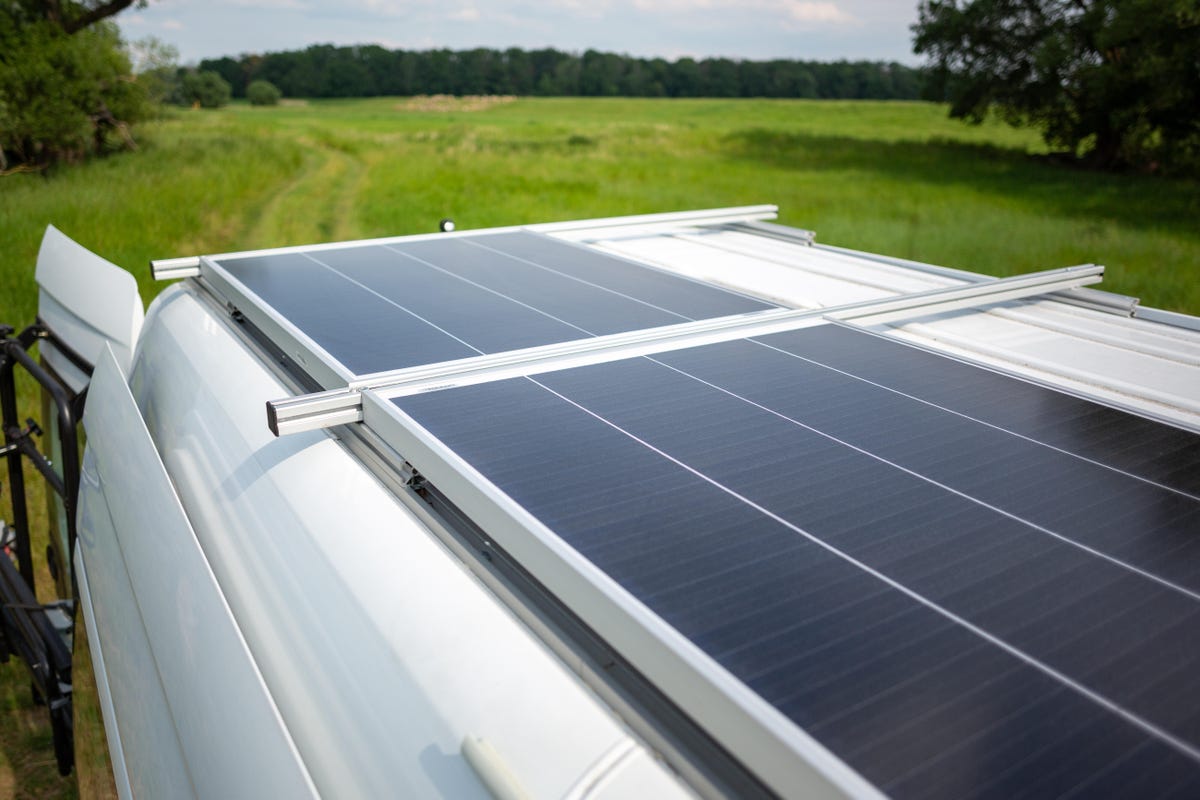
The energy demand of a camper van like this is likely to be met with fewer solar panels than a typical home.
Determining the ideal size and wattage of a mobile solar system works the same way it does in a stationary residential setting. Calculate how much power you'll need during peak usage scenarios and plan your panels accordingly.
If anything, it should be easier to figure out your requirements, since you'll likely have fewer appliances to consider in an RV. However, an important consideration is the unpredictability of the sunlight your RV will receive while traveling. Unlike a house, your RV's location and orientation will always be changing, so you may want to design your system with this in mind.
Installing an RV solar panel system
Initially, Galiardi and Hutchison had a friend with experience in the solar industry help them build a small, rudimentary solar system. After a few years, they upgraded their system and even earned a sponsorship deal with a solar panel company.
There are three main kinds of solar panels for RVs: monocrystalline, polycrystalline and amorphous.
- Monocrystalline panels are the most efficient of the three, so they'll generate the most energy in the least amount of time.
- Polycrystalline panels are slightly less efficient, but they're a durable and reliable option.
- Amorphous panels aren't as efficient as their counterparts, but the thin and bendable construction makes them easy to install and a lighter-weight option.
In addition to solar panels, you'll need several other components to complete your RV solar system, including the following:
- Solar inverter , which converts the solar energy from DC to AC power.
- Charge controller , which protects the storage system from overcharging.
- Solar battery , which stores the generated energy.
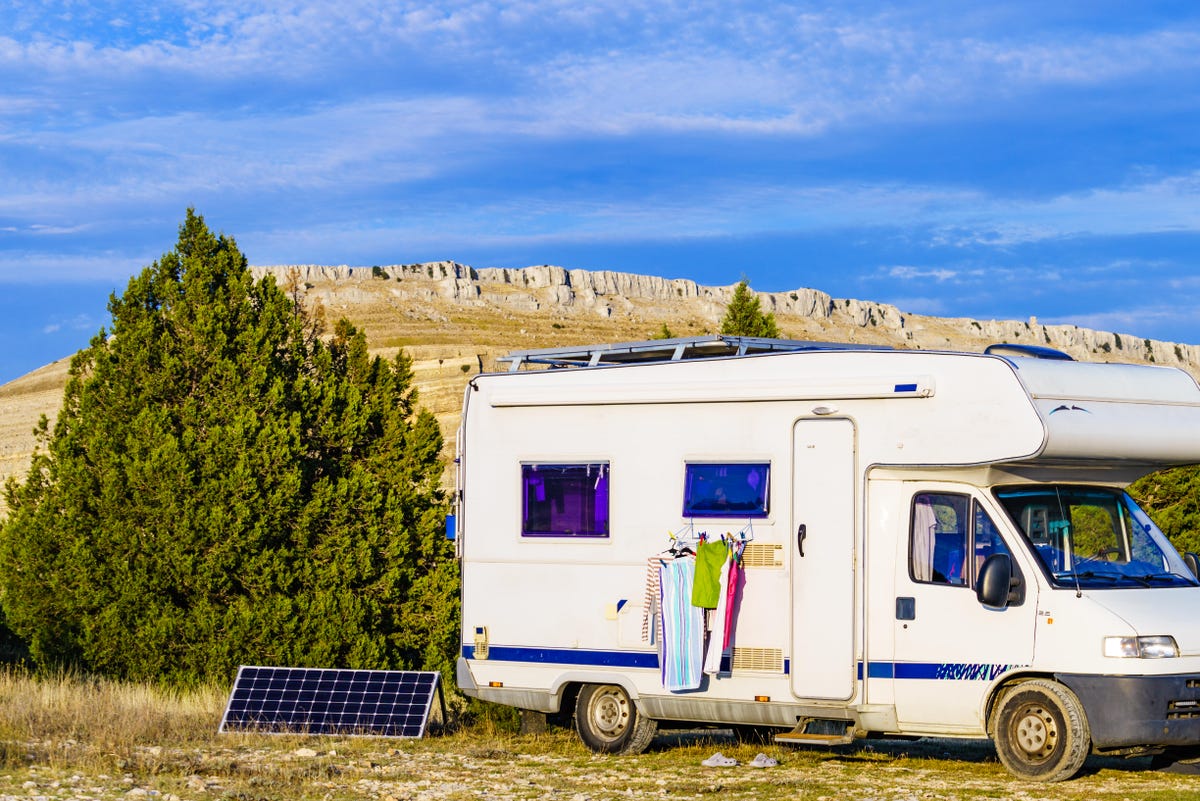
Portable solar panels present another option for RVers.
Because it can be difficult to keep batteries topped up solely by using solar, a backup source of power is also a good idea. Many travelers use some sort of gas or propane generator. Galiardi and Hutchison are equipped to charge up their lithium batteries using their truck while driving.
"Self heating batteries are fantastic if you're camping in any sort of colder climates," Galiardi says.
This is typically more of a need with lithium batteries, which can be more efficient, lower maintenance and longer-lasting than flooded lead-acid batteries, but are also more sensitive to cold.
Finally, a cord to plug into the grid to recharge when it's available is also a must for most.
RV solar panel maintenance
There's little maintenance to worry about with solar panels. If you're traveling in very dusty or windy conditions, you may need to wipe off or clean your panels to ensure they're working at maximum efficiency.
Traveling may also add a bit more wear to a panel's connectors. Standard solar panel connections are quite weatherproof, but it's worth inspecting your system periodically for signs of deterioration, loose connections or rust.
It's not recommended to service these parts on your own without the guidance of an experienced electrician. Remember that a panel can be generating energy any time the sun is up, even when it's cloudy, so always treat any connections as live circuits.
Here Are 23 Ways to Save On Your Electric Bills Right Now
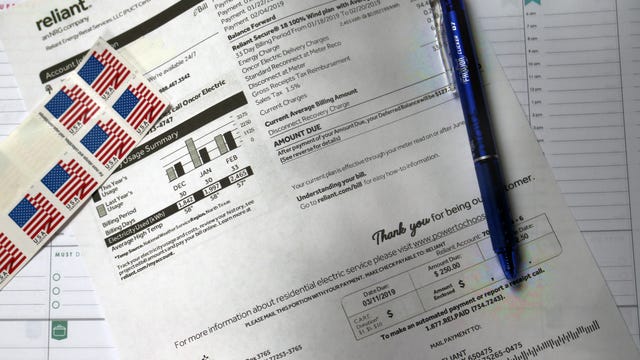
Cost and rebates
The overall cost of your system will depend on factors including the type of panels you choose and how much electricity you need to generate. If you need lots of power, you'll need to buy more equipment, driving up the price.
Galiardi and Hutchison said their 300-watt system with batteries, inverter and other components cost about $3,000, while larger systems for bigger RVs can easily run more than twice as much.
The good news, according to Galiardi, is that incentives, including the 30% federal tax credit for home solar systems, can apply.
"It includes second homes. And RVs and boats and off-grid cabins are in that second home realm," Galiardi said.
Are RV solar panels right for you?
It's difficult to argue with the benefits of solar energy, but RV solar panels might not be right for everyone. If you live in your RV and often take it off-grid (where there are no campground hookups), then solar can be a convenient and eco-friendly alternative to gas-powered generators.
Portable and flexible solar panels better suited to RVs may be more expensive than standard rooftop residential panels, but they're still remarkably cheap compared with past eras.
There's little reason not to boost your freedom by adding a solar system to your rig if you can afford it, though if you use your RV infrequently, it may not be worth the investment.
Hutchison noted that there might be no need for panels if you only ever park your RV at developed campgrounds with provided power.
However, he added it's worthwhile to consider a system with panels and batteries, even "if you plan to spend even one night off-grid between those sites."
- 6 Ways to Go Solar for Cheap
- Best Portable Power Stations
- Best Portable Solar Panels
- Solar Cheat Sheet: Your Complete Guide to Getting Solar Panels at Home
Solar Installer Guides
- Best Solar Panels
- Best Solar Batteries
- Most Efficient Solar Panels
- Best Solar Companies
- Best Solar Shingles
- Best Solar Generators
- Best Solar Inverters
- Tesla Solar Panels Review
- Tesla Solar Roof Review
- Sunrun Solar Panels Review
- GAF Energy Review
- Sunnova Solar Review
- Smartflower Solar Review
- SunPower Review
- Trinity Solar Review
- ADT Solar Review
- Enphase Battery Review
- Tesla Powerwall Review
- Sunpower Sunvault Review
- Generac Pwrcell Review
- Sonnen Battery Review
- LG ESS Home 8 Review
- Panasonic Evervolt Battery Review
- Why Solar Panels Will Likely Keep Getting Cheaper
- How to Make Your Solar Panels Last Longer
- How the Solar Tax Credit Works
- How Much Do Solar Panels Cost?
- This Is How Many Solar Panels You'll Need to Power Your Home
- Solar Power Purchase Agreements Explained: The Pros and Cons
- Free Solar Panels: What's in the Fine Print?
- Avoid Solar Panel Scams: 7 Tips for Getting a Great Deal
- Solar Panels Will Eventually Save You Money. How to Know When the real Savings Begin
- This Is How Long You Can Expect Your Solar Panel Installation to Take
- The Pros and Cons of Solar Panels
Other Energy Saving Guides
- Best Smart Thermostats
- Ecobee Smart Thermostat Premium vs. Ecobee Smart Thermostat Enhanced
- Home Generator Buying Guide
- Heat Pump vs. Furnace
- Anker Portable Power Station
- Ecobee Smart Thermostat Enhanced vs. Nest Thermostat
- Nest Learning Thermostat vs. Nest Thermostat
- Storage Tank Water Heaters vs. Tankless Water Heaters
- Ecobee Smart Thermostat Premium vs. Ecobee Smart
- Moving Off- Grid: My Ultimate Pandemic Project Is About More Than Utility Bills
- How Living With Solar Panels Demystified Electricity for Me
- For Life Off the Grid, Batteries Mean Independence
- The Biggest Pros and Cons of Living Off-Grid Arent What I Expected
- The Hidden (and Not So Hidden) Expenses of Living Off Grid
- My Off-Grid Project: The Secrets I Learned to Save on Solar
Article updated on July 30, 2023 at 5:00 AM PDT
Our Experts

- Finalist for the Nesta Tipping Point prize and a degree in broadcast journalism from the University of Missouri-Columbia.
We thoroughly evaluate each company and product we review and ensure our stories meet our high editorial standards.

Instantly estimate your solar cost and savings. Pick a provider later.
World’s First Fully Solar-Equipped, Fold-Out Camp Trailer
Share this:.
- Click to share on Facebook (Opens in new window)
- Click to email a link to a friend (Opens in new window)

Solar brand GoSun and Camp365 team up to combat crowded parks, soaring gas prices, and ‘unpredictable weather’ with a trailer like no other.
GoSun and Camp365’s new camp trailer aims to mitigate key hassles in modern camping with ease of use and flexibility. Don’t believe us? Check out the adjective list: The companies say they partnered to create the first “aerodynamic, lightweight, expandable, off-grid solar trailer,” which takes less than 10 minutes to set up.
The trailer weighs 1,800 pounds, so nearly any vehicle could tow it, even electric cars.
Though the Camp365 trailer sleeps up to six people, it doesn’t take up much space when folded down for transport. That helps it fit in most parking spaces in garages. It also comes with an emergency power system capable of powering electronics, as well as cooking, refrigeration, and fresh water.
Travel Trailer Problem Solver
The whole shebang adds up to one of several new approaches to compact camping trailers unveiled in recent years .
“Many outdoor enthusiasts want the freedom to take off and go,” GoSun said . “But the problem with conventional trailers is that they are too big and heavy, you need a large truck to pull the units, and you have no place to store/park the trailer when you are not using it.”

The new trailer addresses those problems with a compact design that unfolds to 700 cubic feet of space and a height of 7.5 feet. Its solar grid also powers a hot shower, and the trailer includes a kitchen sink and toilet.
The brands intend the all-in-one design to help campers address the rising cost and popularity of campsites by avoiding them altogether. The GoSun Camp365 empowers campers, its makers say, to park for free and still have everything they need. The trailer even has a leveling system that allows it to function on uneven terrain.
“When you entertain guests, the GoSun Camp365 delivers an instant and comfortable pop-up guest room,” the brands said.
The trailer rings in at $32,500, including a $5,000 deposit.

Sonoran Rovers Uses Exquisite Craftsmanship to Build a Defender Overland Camper
Keen attention to detail and superior craftsmanship make this Land Rover project one of the most enticing vehicle buildouts we've seen. Read more…

Andrew McLemore is a staff writer at AllGear Digital. Andrew has more than 10 years of experience covering a range of beats including government, education, and business, with specializations in criminal justice and investigative journalism. He has worked for newspapers across Texas, including The Austin American-Statesman, The Dallas Morning News, and The Fort Worth Weekly. He also spent several years in PR, working for nonprofit organizations including the Texas Access to Justice Commission and Texas RioGrande Legal Aid.
Andrew brings his writing experience to outdoor gear and adventures throughout the Americas. When he’s not writing, playing gigs, or exploring the outdoors, he’s hanging out with his dog Campana.
Follow Us On
Subscribe Now
Get adventure news and gear reviews in your inbox!
Join Our GearJunkie Newsletter
Gear Top Stories Deals
Your Guide to RV Solar Panels: Components, Installation, and More
Which is more practical for your RV, a generator or solar panels?
David Kuchta, Ph.D. has 10 years of experience in gardening and has read widely in environmental history and the energy transition. An environmental activist since the 1970s, he is also a historian, author, gardener, and educator.
:max_bytes(150000):strip_icc():format(webp)/professional-headandshoulders-b7be2761c16e44438607bf932fc1993c.jpg)
- Wesleyan University, University of California, Berkeley
:max_bytes(150000):strip_icc():format(webp)/ScreenShot2021-04-07at1.57.45PM-bcef177316c94cdf998457c694cce6d5.png)
- University of Tennessee
Voyagerix / Getty Images
- Renewable Energy
- Fossil Fuels
RV Solar Components
Solar vs. generator: which is better, installing solar panels on your rv.
- Frequently Asked Questions
It's increasingly common to see solar panels on the roofs of recreational vehicles (RVs). While solar panels can't replace an internal combustion engine and turn your RV into an all-electric vehicle, they can allow you to run your lights and appliances cleanly rather than relying on a fossil-fueled generator.
Solar panels also give you the freedom to camp off-grid and in places that don't allow generators, rather than having to find a spot in a crowded campground with an available hook-up. And of course, with solar panels, you can reduce your carbon footprint.
Here, we discuss RV solar components and whether they are worth investing in for your next RV trip.
RV solar is not as simple as attaching solar panels to the roof and plugging in appliances. Here are the main components in an RV solar system.
Solar Panels
Panels can be flexible, portable, or rigid. Lightweight flexible panels are better suited when an RV roof is molded rather than flat, while portable panels can be placed anywhere on or off the vehicle, so they can capture sunlight even if the RV is parked in the shade. Rigid panels are much heavier, but they are also more durable and efficient. Panels may generate 150 watts in flexible and portable panels and up to 250 to 300 watts in rigid panels.
Most RVs have two batteries. A 12-volt lead-acid/AGM starting battery is used to start the engine, while a 12-volt RV "house" battery bank is used to run the DC-powered appliances, such as fans, lights, and water systems.
An AC/DC inverter can provide 120-volt power from a "shore power" hookup at an RV campground to power air conditioners, microwaves, and other energy-intensive appliances. In more modern RVs, older lead-acid RV battery banks have been replaced by lithium iron phosphate batteries charged by solar panels and the RV's engine alternator via DC/DC chargers. Together, these provide much more rapid charging and much longer-life battery banks, especially suited for off-grid use.
Some RV owners upgrade to lithium-ion batteries, which are lighter, more efficient, maintenance-free, can hold more energy, and have a longer lifetime. The downside is they cost significantly more.
Solar Charge Controller
A solar charge controller protects your battery by regulating the flow of electricity from solar panels to the battery. The controller matches the voltage output of the solar panels to the voltage capabilities of the battery or batteries.
Many RVs already have inverters that convert DC power from your 12-volt battery into 120-volt AC power used by your lights and other electrical equipment. More expensive inverters can produce more reliable and consistent power needed to run sensitive equipment like electronics or medical equipment.
Transfer Switch
A transfer switch allows you to switch the source of your power from the battery to shore power when parked in a campground, or to turn off a propane source when you are driving.
It's no surprise that solar panels are more environmentally friendly than fossil-fuel generators. Here are some other factors to consider:
- Energy : Solar panels require adequate sun to charge your batteries, while generators require adequate fossil fuels.
- Space : A generator and its fuel take up a significant amount of interior storage space. Solar panels are limited by the amount of roof space.
- Flammability : Fuels for generators (usually diesel, gasoline, or propane) are flammable. Some states prohibit the use of propane generators while driving.
- Maintenance : Generators need regular maintenance and can leave sulfate residues in batteries. With no moving parts, solar panels need little maintenance other than dust and debris removal.
- Power Speed : Generators provide instant power. Solar power is slower.
- Costs : Solar panels usually cost more to install than a generator, but once installed, the sunshine is free and infinitely renewable.
- Noise : Running a generator at night in a crowded campground will not win you any friends. Absolutely quiet solar panels, however, do not generate anything at night.
- Emissions : Generators emit greenhouse gases, carbon monoxide, and particulate matter, while solar panels are emissions-free. The manufacture of solar panels is not carbon-free, but neither is the manufacture of generators or the fossil fuels that run them.
Installing solar panels on an RV is no more complicated than installing them on the roof of a home.
Treehugger Tip
If you are uncomfortable or inexperienced in working with electrical systems, hire a professional, such as a professional RV converting company.
When you're ready to purchase and prepare for installation, remember to:
- Calculate how many panels you will need . Identify the power requirements of your appliances and how many hours per day you use them.
- Consider what equipment your RV already has . A number of RVs for sale on the market already come solar-equipped or solar-ready. For safety and efficiency, be sure that your RV has heavy-gauge wiring adequate to supply the full amount of power from your panels to your batteries.
- Buy everything at once . Each component of your RV solar system needs to be compatible with each other. RV solar panel kits are more expensive than buying each component separately, but their components are already compatible.
Installing an RV solar system consists of upfront costs that can be expensive. But these costs may save you money in electricity and fuel costs, as well as camping fees. Solar panels will also reduce your greenhouse gas emissions. If you want to go completely emissions-free, consider a car-camping road-trip in an electric vehicle.
Depending on the amount of sunshine you get and the amount of energy you use, a single 100-watt solar panel is likely to be able to keep a 12-volt DC battery charged. It is likely you'll want multiple higher-wattage panels and perhaps multiple batteries to give you more power for a longer period of time.
Depends on your usage. The larger upfront cost of solar panels, compared to a generator, pays itself off if you frequently rely on solar power off-grid. However, if you only park your RV in campgrounds with shore power, it's probably not worth your money and effort to invest in solar panels.
If your RV is not solar-ready, you may need more than a minimal 100-watt solar panel kit with mounting brackets and a solar charge controller, which can cost as little as $150. With a lithium-ion battery and multiple panels on your roof, the cost can be a few thousand dollars.
- The 7 Best Solar-Powered Generators of 2024
- The 6 Best Home Battery Storage Systems
- What Is Solar Charge Controller? Do You Need One?
- What Are Flexible Solar Panels?
- Are Portable Solar Panels Worth It? Everything You Need to Know
- Wind Turbines vs. Solar Panels for Home — Which Is Better?
- How Does Solar Battery Storage Work?
- A Guide to Solar Panel Installation
- The 7 Best Portable Solar Panels
- Solar Panels for Your Home: Frequently Asked Questions
- The 7 Best Solar Power Banks
- Is a Solar Carport Worth the Investment? Overview, Benefits, and Drawbacks
- Are “Free Solar Panels” Really Free?
- The 6 Best Solar Lanterns
- The Best Direction for Solar Panels
- The 6 Best E-Bike Conversion Kits of 2024
- skip to Main Content
Go RVing uses cookies on gorving.com in accordance with our privacy policy . By using this site, you consent to the use of cookies. We use cookies for the following purposes: To enable certain functions of the service, to provide analytics, to store your preferences, and to enable advertisements delivery, including behavioral advertising.

- Your Basecamp
- For the Family
- Furry Friends
- All the Amenities
- Working from the Road
- Versatile Vacations
- A Fit for Any Budget
- See All Benefits BENEFITS
- Active Lifestyle
- On the Water
- Winter Sports
- The Great Outdoors
- A Weekend Getaway
- Explore a New City
- Go Glamping
- Foodie Adventures
- Seasonal Camping
- See All Activities ACTIVITIES
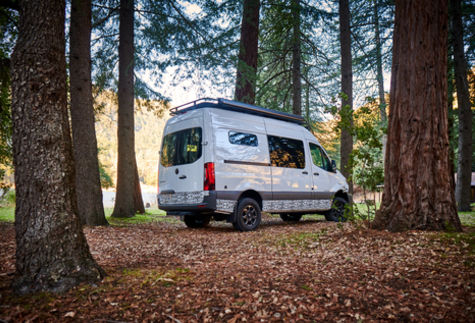
- Travel Trailers
- Expandable Trailers
- 5th Wheel Trailers
- Pop-Up Campers
- Teardrop Trailers
- Sport Utility RVs
- Truck Campers
- Learn About Towables TOW IT
- Class A Motorhomes
- Class B Motorhomes
- Class C Motorhomes
- Learn About Motorized RVs DRIVE IT
OTHER RV MODELS
- Park Model RVs
- Horse Trailers
- Ice Fish Houses
EXPLORE RVs
- Learn More EXPLORE RVs
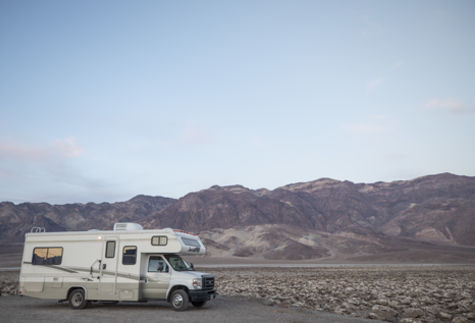
- RV How-to's
Expert Advice
- Recipes for the Road
- On the Road with RVers
- Trip Planning
- Budget Tips
- Meet Our Contributors
- Become a Contributor
- See All EXPLORE

Ryan's Story
Highlining in Moab
Ryan Robinson takes you for a ride in the passenger seat of his RV, off the grid, deep among the dramatic rock formations of the Utah Desert. Robinson and friends chill by the fire, tell stories, and of course, rig a one of a kind highline over the Looking Glass Arch in Moab, UT.
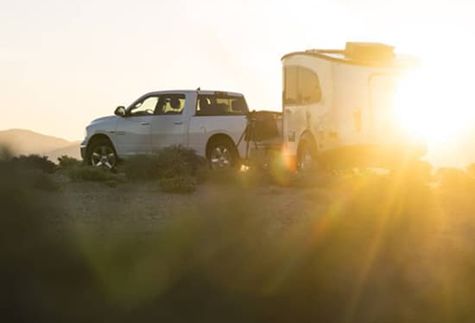
START YOUR JOURNEY
- Buying an RV
- Renting an RV
- Find a Campground
- First-Timers Tool Kit
- RV Shows & Events
- Explore Models & Manufacturers
- Find Services & Parts
- Sign up for RV Information
- Visit our Booth
- Get Started START YOUR JOURNEY
YOUR NEXT ADVENTURE
- Inspiring Trips
- RV Parks & Campgrounds
- National Parks
- Scenic Byways
SIGN UP FOR OUR NEWSLETTER
Send us your email to get helpful tips and useful information from our partners.
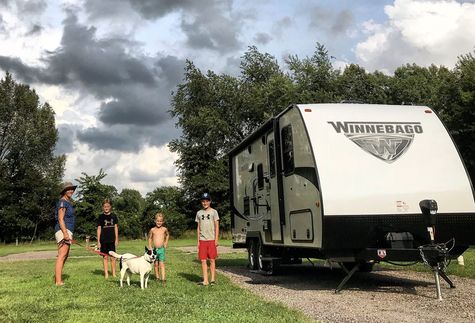
RV Solar Panels: A Beginners Guide To Going Solar
Interested in learning more about RV solar power? Jesse and Lauren Stuart share their tips for using solar panels on your RV.

Share this experience
Do you want to install RV solar panels on your camper or RV and don't know where to start? From RV solar systems to inverters, and understanding what kind of solar panels are best for an RV, there’s a lot to consider when purchasing solar panels for your rig.
So why get RV solar panels installed? RV solar panels are a great way to power your RV when you’re looking to break away from electric hookup sites and try dry camping or boondocking . When you have RV solar panels and a solar system set up in your RV or camper, you'll be able to power all or some of your RV’s electrical needs like lights, appliances, and even your RV air conditioner.
Whatever size RV you have, before you purchase your RV solar panels, there are a few things you need to know.
RV Solar Panel Systems: Which Is Right For Me?
You have two options to consider when choosing solar panels for your RV or camper
1) Portable RV Solar Panel System
A portable RV solar panel system is the easiest to set up and use. These systems typically plug into a dedicated solar plug on your RV and include one or more 100-watt solar panels that can be attached to your roof with Velcro straps. Other portable solar panels come in a suitcase. You connect the panels via a cord and place them in an area around your RV that gets the most sun.
The portable RV solar panel system is a great choice for RVers who don’t need a lot of power. Maybe you want to use your lights, charge your devices (i.e. phones, computers), and top off your trailer batteries. This option can also be the lowest overall cost to entry, but note you will probably pay more per watt for the convenience of portability.
2) Permanent RV Solar Panel System
Installing permanent RV solar panels is more expensive up front, but this option is the most efficient. You'll get the best bang for your buck per solar watt, can maximize any unused roof space for panels, the panels will be constantly collecting sunlight (i.e. while driving), and the panels don't require setup once you’re parked.
Permanent RV solar panel systems are typically installed by an RV dealer or professional companies that specialize in RV solar panel installation. These systems are designed for those who are trying to maximize solar power not just to charge devices, but also to operate appliances like refrigerators, microwaves, coffee makers, and even air conditioners.
RELATED: 8 Tips For Off-Grid RV Adventures
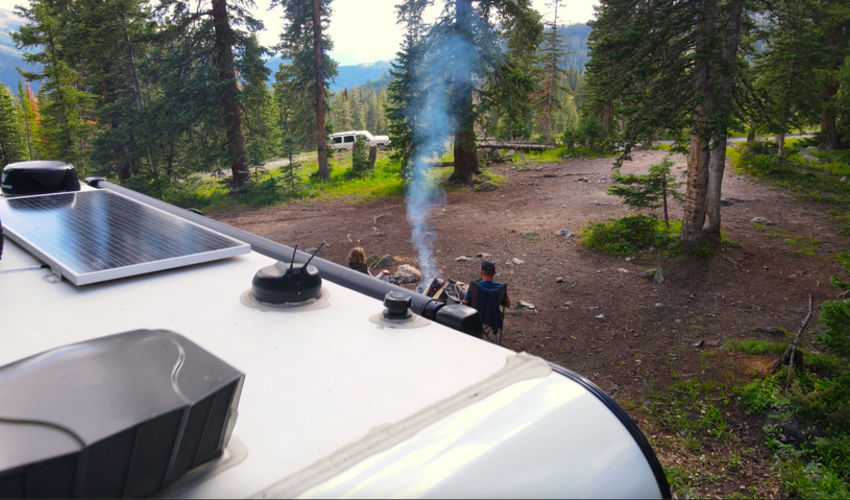
How Many Solar Panels Do I Need To Run My RV?
First, you need to determine your RV's power needs. RV solar panels are rated in watts, and you'll need to know the wattage (or watt hours) of all the devices you want to run on solar power — think your refrigerator, microwave, phones, TV, etc. For anything that uses electricity in your RV, you need to calculate watt use.
Calculating Watt Use
Locate the amps (or watts) on your devices to determine their usage. You need to convert everything to watts, so if a device only has amps, multiply it by the volts to get watts.
Example: A 120-volt rice cooker that draws 3 amps converts to 360 watts (120 x 3).
Once you know the watts per device used, determine how long you use it daily and multiply it by that “use rate” to get its daily watt usage or watt-hours.
Example: Using the above rice cooker for 30 minutes or 0.5 hours consumes 180 watt-hours (360 watts x 0.5).
Calculating How Many Solar Panels You Need
Once you determine your watt use, you can calculate the number of RV solar panels and how many watts of solar you need.
Most people think that a 100-watt solar panel produces 800 to 1,000 watts of power per day (8 to 10 hours of daylight). Unfortunately, that’s not the case. A conservative rule of thumb is that per 100-watt solar panel, you'll collect about 350 watts per day due to things like weather, optimum sun angle/exposure, and panel efficiencies.
Example: You have one phone at 5 watts to charge for an hour, you use a rice cooker that uses 360 watts for 30 minutes and you use a blow dryer that uses 1,500 watts for 6 minutes.
Phone: 5 (watts) x 1 (hour) = 5 watts
Rice cooker: 360 (watts) x 0.5 (hours) = 180 watts
Blow dryer: 1,500 (watts) x 0.1 (hours) = 150 watts
Total: 5 (watts) x 180 (watts) x 150 (watts) = 355 watts per day
Given this example, a 100-watt solar panel would be sufficient enough to generate enough power to charge your battery and run your devices each day. (Consult with the company installing your panels to determine the panel amount you need.)
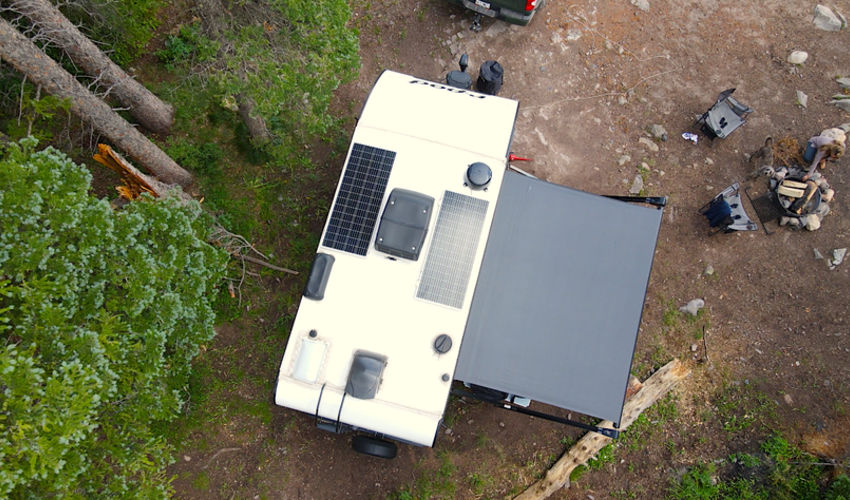
What Else Do I Need For My RV Solar Panels?
You'll need more than just solar panels for your RV. There are a few more pieces to pick up, such as:
- Battery bank
- Charge controller
Battery Bank
Batteries store the electricity produced by the solar panel so that your RV can still be powered when there’s no sunlight available (i.e. at night or during bad weather). Technically, solar panels don’t power devices, the solar panels charge the battery and the batteries are what supply the power.
Most batteries are either 24 volts or 12 volts and rated in amps (or Ah). Ideally, you want a battery that has enough capacity to power all your devices and appliances for a couple of days. That way if you have a day of no or low sunlight, you still have some juice to power your devices and appliances.
RELATED: Boondock Basics: The Only Gear Guide You’ll Ever Need
To find out how much battery you need (amps), calculate your watts and divide by volts.
An inverter charger converts DC power (produced by solar panels) into AC power that can be used by your RV's electrical system. It also can take AC power and convert it to DC power to charge your batteries.
To determine how large of an inverter you need, take the total watts you’ll use at any given time and multiply that number by 1.25.
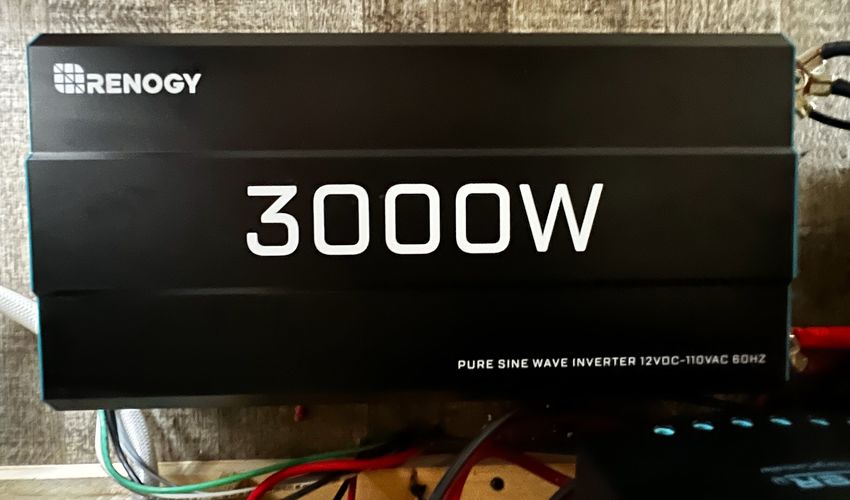
Charge Controller
Lastly, you’ll need a charge controller. The main purpose of a charge controller is to create a one-way street for energy. The charge controller takes the energy generated from your solar panels and channels it to your battery bank.
The charge controller also monitors and stops potential issues like overcharging or discharge, which can ultimately damage your battery.
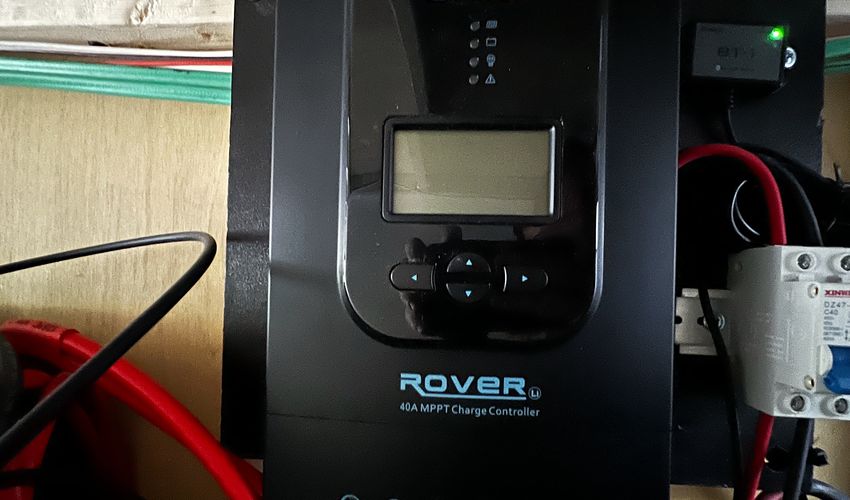
Are RV Solar Panels Worth It?
While the answer might be different for each person, there is time and money involved when deciding to add a solar panel system to your RV or camper.
Installing solar panels on your RV is ideal for those who:
- Are looking to get a little more off-grid when RVing; installing solar panels allows your RV to power up, instead of being connected to campground electric hookups/power.
- Are looking for a more sustainable solution to sourcing energy.
- Prefer the quiet collection of solar power over the hum of a gas-powered generator.
With research, time, and investment you can open up the possibilities of where you can go RVing.
The Wandering Stus
Lauren and Jesse Stuart, a travel blogging couple , along with their dog Huey cruise the country in their travel trailer sharing travel tips, itineraries, and their adventures along the way!
More Related Articles

The Right Stuff For Multigenerational Camping

Go Seasonal Camping in an RV
Outdoor decoration in the forest
8 Tips for Getting the Most Out of an RV Show
Jayco Class C at an RV show

Get More News & Inspiration!
Submit your email to get helpful tips and inspiration from Go RVing as well as information from our dealer partners on making your RV dream a reality.
* Indicates the field is required.

My RV is Solar Ready – What Do I Need? A Simple Guide For The DIYer
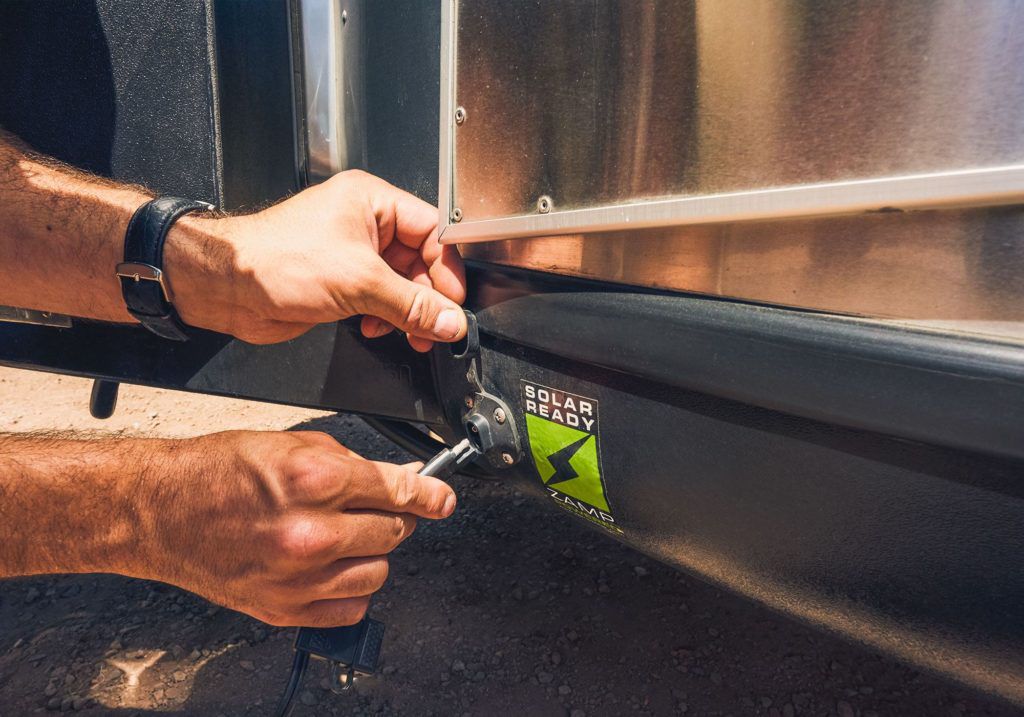
Solar power is becoming increasingly popular among RV enthusiasts, as it offers an environmentally friendly and cost-effective source of energy while on the road. If your RV is already solar-ready, you might be wondering what steps you need to take to make the most of this sustainable energy source. In this article, we will discuss the necessary components and practical considerations for harnessing solar power in your recreational vehicle.
To begin with, you’ll need to have a basic understanding of the solar power system and the essential components involved. A typical solar power setup for an RV will consist of solar panels, a charge controller, a battery bank, and an inverter. These components work together to collect, store, and convert solar energy into usable electricity for your RV’s appliances and electronics.
Some SRRV’s can harness a rooftop system or a portable system. To learn more about these types view this post: What is a Solar Ready RV?
But before you dive into buying solar for your solar ready RV, it’s time to evaluate your energy requirements. Assessing your daily power consumption will help you determine the appropriate solar panel system, battery capacity, and inverter specifications to meet your specific needs. Keep in mind that these components will vary based on factors such as your RV’s size, the number of appliances you use, and the desired duration of off-grid camping. It will also help you understand the cost associated with solar-RVing and if it makes sense for you. By understanding your usage you’ll be able to estimate your system size. Read: Solar Sizing: Three Ways to Estimate Electrical Usage for an idea on how much power you might use.
Additional SRRV Resources:
- Is RV Solar Worth It? A Friendly Guide to Weighing the Pros and Cons
- Portable Solar Panels for Your RV: Weighing the Pros and Cons


Understanding Solar Ready RVs
What is a solar ready rv.
A solar ready RV is a recreational vehicle that has been pre-wired for solar panels by the manufacturer. This means that the RV comes equipped with the necessary wiring and connections to support a solar power system. This feature makes it easier for RV owners to install solar panels themselves or have them professionally installed, as the essential infrastructure has already been put in place by the builders.
Popular RV Manufacturers Providing Solar Ready Options
Many RV manufacturers have recognized the growing demand for solar power and have started offering solar ready options. Here are some popular RV manufacturers providing solar ready RVs:
- Forest River : This manufacturer has a variety of RV lines that come pre-wired for solar, making it more convenient for owners to add solar panels and accessories.
- Airstream : Known for their iconic aluminum travel trailers, Airstream now offers solar ready options for some of their models, which allows for easy solar system integration.
- Jayco : Another reputable RV manufacturer, Jayco has also started offering solar ready RVs in their lineup. Their solar-ready package includes pre-installed wiring and rooftop connectors, simplifying the solar panel installation process.
Components of a Solar Power System
Solar panels.
Solar panels convert sunlight into electricity, enabling your RV to harness solar energy. Panels come in various sizes and wattages, depending on your power needs and roof space. Mounting solar panels on the roof is optimal as it ensures maximum exposure to sunlight.
More About:
- RV Rooftop Solar Systems : A Guide for Efficient and Sustainable Travel
- Portable Solar Systems : The Ultimate Portable Power Solution for Off-Grid Living
Charge Controller
A charge controller regulates the voltage and current coming from the solar panels, ensuring your batteries don’t overcharge or discharge excessively. Two types of charge controllers are commonly used: Pulse Width Modulation (PWM) and Maximum Power Point Tracking (MPPT). MPPT charge controllers are usually more efficient but also more expensive than PWM controllers.
Read up on solar controllers:
- Introduction to Charge Controllers for RV Solar Systems
Battery Bank
The battery bank stores the electricity generated by the solar panels, allowing you to use the power when your rig is not in direct sunlight. Selecting the right size and type of battery helps make your solar RVing experience all that much better. Deep-cycle batteries, such as lead-acid or lithium-ion, are typically used for RV solar systems due to their durability and higher capacity. Sizing a battery too small can also render you without power when you need it most. Learn more about batteries with out Battery Basics Series . We go over how to size them, how to test them, how to wire them, how to care for them and more.
An inverter converts the direct current (DC) produced by the solar panels and stored in the battery bank into alternating current (AC), which is required to power most electrical devices. Think of AC power as household power. Devices that plug in at home need AC to run. There are two types of inverters: modified sine wave and pure sine wave. A pure sine wave inverter is considered superior as it provides cleaner power, but is also more expensive than a modified sine wave inverter.
An inverter is a device that helps power your RV’s electrical system using your batteries. To connect it, you’ll need to wire it directly to your batteries and then to your RV’s electrical system. This can be tricky and requires a good understanding of AC and DC electrical.
Alternatively, some inverters come with a plug that you can just connect to your battery and plug your devices into. It’s much easier! But, if you want to power your RV’s outlets with your batteries, you’ll need to do some wiring.
If you’re not comfortable with electrical work, it’s best to call in a professional. Electricity can be dangerous, so it’s better to be safe than sorry.
Preparing Your Solar Ready RV for Solar
If you own a solar-ready RV or camper, you’re already ahead in the game for setting up an off-grid energy source. Solar-ready vehicles are usually pre-wired for solar panels, making it easier and more cost-effective to install a solar system for your mobile abode. In this section, we will discuss the necessary steps and equipment needed for preparing your solar-ready RV for harnessing solar power.
First and foremost, you should consult your RV’s manual to understand the specific configurations and details of your vehicle’s solar wiring. Manuals typically provide information on existing wiring, proprietary plug types, and other necessary components. This information will help you choose the right solar equipment to fit your RV’s pre-wired system. But also, some RV manufactures don’t do the best job at showing you the configurations. If this happens, it’s likely a good idea to consult the solar manufacture to get additional details.
Three brands of SRRV suppliers we know well are:
- Zamp Solar : The pioneers to RV solar and Solar Ready RVs
- GoPower Solar : Zamp and GoPower are now owned by Dometic. GoPower uses Solar on the Side for their SRRV setups.
- Renogy : These guys kick out a ton of solar kits and generally adapt to what’s going on in the industry with quick Chinese manufacturing.
Your solar installation will require a solar charge controller to manage electrical current between solar panels and battery banks. Most portable systems have an integrated solar charge controller, but double check. You will also need solar panels, either in the form of portable solar panels or a roof-mounted system. Portable panels, like a solar suitcase or a Renogy solar suitcase, offer flexibility, while roof-mounted panels provide a more permanent solution. Additionally, some solar-ready RVs might be equipped with a plug-and-play port, such as a Zamp or Go Power! port, which simplifies the installation process.
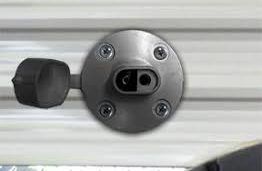
SIDE NOTE: When connecting your solar system to the RV, check the polarity, even manufactures make mistakes. This can be done using a voltmeter, which should indicate the positive lead (red wire) and the negative lead. If the polarity needs to be reversed, it’s as simple as reversing the wires on the battery, or getting an adapter.
An important aspect of setting up your solar system is determining the available energy you’ll need for your RV. This can be measured in amp hours (Ah) or watt hours (Wh). Your solar equipment, including the solar charge controller and panels, should be capable of providing the required amp hours to adequately power your motorhome. We’re a fan of just converting everything over to watt hours as there is a push to go from smaller voltage (12-volt panels) solar panels to larger voltage ones (24 or 48-volts). Most MPPT charge controllers to best with higher voltage and automatically convert it to charge a 12-volt battery bank.
Selecting the Right Solar Panels
When choosing solar panels for a solar-ready RV, consider the RV’s roof size and configuration. The roof space will determine the maximum size and number of panels that can be mounted. But you might not need to cover the entire surface for light use.
High-quality panels from a good manufacture will have a more extended lifespan and better efficiency. Look for panels with a reputable brand name and good customer reviews. We are not a fan of most of the flexible panels on the market. They look like a good idea but lose their efficiency in just a few years and can burn the top of your RV. If you were to look at any flexible panel we urge you to consider only CIGS technology flexible panels .
Another thing to keep in mind is the pre-wired setup of the RV. Most solar-ready rigs come with plug-and-play systems that make installing panels a breeze. Look for solar panels that can easily connect to the existing wiring of your RV, which will save time and effort during installation.

Installation and Wiring Considerations
When it comes to setting up a solar-ready RV, there are some important wiring and installation aspects to consider. First and foremost, it’s important to make sure the wiring is done correctly. Double-check that the polarity of the wiring matches the portable solar panels you will be using. Incorrect polarity can lead to a lack of power flow and can potentially damage the solar panels.
To connect the solar wiring to your RV’s pre-wire, identify the positive lead (usually red) and the negative lead (usually black). When making modifications, always connect the positive lead to the positive terminal and the negative lead to the negative terminal. Note that some solar-ready RVs may also have red and black wires pre-installed. Using a voltmeter will help to verify the correct polarity before making the connections.
Pay attention to the gauge of the wiring. Thicker wiring provides lower resistance and will be more efficient when it comes to transferring energy from the portable solar panels to your RV’s battery. The gauge of the pre-wiring installed in a solar-ready RV should be sufficient, but if it isn’t, consider upgrading the wiring before connecting your solar panels.
Portable solar panels are a user-friendly option for harnessing solar energy. They usually come with easy-to-fit mounting brackets, making it simple for anyone to install them on an RV without the need for professional assistance. Be sure to secure the panels properly when they are in use and during travel.
Lastly, it’s important to keep in mind that a solar-ready RV comes with pre-wiring, which is a great starting point for adding solar power to your rig. However, it doesn’t necessarily guarantee compatibility with all solar panels available in the market. It’s essential to research and find a solar panel setup that is a perfect match for your particular RV’s pre-wiring configuration.
Common Issues and Troubleshooting
When setting up a solar-ready RV, there can be a few common issues that may arise. In this section, we will discuss some of these problems and how to troubleshoot them.
One common issue is related to polarity . Incorrect wiring can result in reverse polarity , which means that the positive and negative wires were connected the wrong way. To check if this has occurred, use a voltmeter to measure the voltage on the terminals. If the measured voltage is negative, reverse the connections to fix the polarity. Remember that the red wire typically represents the positive connection.
Another potential problem involves modifications made to the RV’s electrical system. Some owners may have made changes to the wiring, which can cause complications for solar-ready setups. Before installing the solar panels, make sure to inspect the electrical system and fix or update any incorrect wiring.
Sometimes, the installed solar panels might not be producing power as expected. In such cases, bypassing the faulty panel(s) temporarily by using jumper cables can help restore power to the remaining panels. However, it is essential to identify the problem and permanently fix the non-functioning panel(s) to avoid lasting issues.
Dealing with issues related to wiring can also be quite common. Loose connections or damaged wires can result in the loss of power or decreased efficiency. Inspect the wiring and connections periodically to ensure they are secure and in good condition. Replace any damaged sections promptly to maintain optimal performance.
More Resources
This is a simple look at Solar Ready RVs and the solar solutions you can use. Solar is constantly changing and so are the manufactures. If your RV has a feature that we haven’t covered emails us. We’d be happy to shine some light on it. k
Related Posts
Are rv solar panels worth it, how to use a hydrometer battery tester.
- United States - English
- United Kingdom - English
- Canada - English
- Australia - English
- Other Europe - English
- Germany - Deutsch

RV Solar Panels: A Beginner's Guide To Power Your Journey
From off-grid adventures to mobile living, RV solar panels deliver power and comfort wherever your journey takes you—letting you roam freely with the sun as your energy source!
In the world of recreational vehicles (RVs), solar panels are revolutionizing how enthusiasts explore the great outdoors. RV solar panels harness the power of the sun to provide renewable energy, offering independence from traditional power sources. Whether you're cruising through national parks or camping off-grid, these panels ensure a sustainable and eco-friendly way to charge batteries and run appliances. As interest in sustainable living grows, RV solar panels have become essential for adventurers seeking energy efficiency and cost savings. This article explores what RV solar panels are, how they function, and crucial components like solar kits , empowering travelers to embrace a greener journey without sacrificing comfort or convenience.
What Are RV Solar Panels
RV solar panels are photovoltaic modules designed specifically for recreational vehicles (RVs) to harness sunlight and convert it into electricity. These panels are composed of solar cells that absorb sunlight, initiating a process where photons from the sun's rays create an electrical current. This electricity is then used to charge batteries within the RV, powering various appliances and devices.
The primary advantage of RV solar panels lies in their ability to provide sustainable and off-grid power solutions. They reduce dependency on traditional fuel-powered generators and shore power hookups, offering freedom and flexibility during travels. This independence is particularly valuable for adventurers exploring remote locations or practicing eco-friendly lifestyles.
Solar panels for RVs come in various sizes and configurations to suit different energy needs and vehicle setups. Flexible solar panels can be mounted on curved surfaces, while rigid panels are often installed on the roof of the RV for optimal sunlight exposure. Advances in solar technology have also made panels more efficient and durable, capable of withstanding diverse weather conditions encountered on the road.
How Do RV Solar Panels Work
RV solar panels work by capturing sunlight through photovoltaic cells, converting solar energy into electricity that can power appliances and charge batteries onboard. These panels are typically mounted on the roof of the RV to maximize exposure to sunlight while traveling or parked. Check out our guide to learn more details about how do solar panels work .

When sunlight strikes the solar panels, the photons (light particles) create an electrical current within the semiconductor materials of the panels. This direct current (DC) is then sent to a charge controller, which regulates the charging process to protect the batteries from overcharging.
From the charge controller, the DC electricity is either stored in batteries for later use or converted into alternating current (AC) through an inverter to power AC appliances. RV solar systems can be customized based on energy needs, with options for additional panels or batteries to increase power capacity.
Overall, RV solar panels provide a clean, renewable energy source that enhances independence and sustainability while enjoying life on the road.
How Many Solar Panels Do I Need For RV
Determining the number of solar panels needed for your RV depends on several factors, including your energy consumption, travel habits, and the efficiency of the solar panels themselves.
Calculating How Much Energy You Use:
To determine how many solar panels your RV needs, start by calculating your daily energy consumption. Consider all appliances and devices you regularly use, such as lights, fans, refrigerator, and electronics. Each device should list its power consumption in watts (W) or kilowatt-hours (kWh) per day. Multiply the wattage by the number of hours each device is typically used to get its daily energy consumption in watt-hours (Wh). Add together the total energy consumption of all devices to find your daily energy usage.
For example, if your LED lights total 50 watts and run for 4 hours a day, they consume 200 watt-hours (Wh) daily. Your refrigerator might use 100 watts and run for 24 hours, consuming 2400 Wh daily.
Calculating How Many Solar Panels You Need:
Once you know your daily energy consumption in watt-hours (Wh), you can estimate the number of solar panels required. Solar panels are rated in watts (W) of power they generate under standard conditions. Divide your daily energy usage by the wattage output of a single solar panel to get an estimate of how many panels you'll need.
Consider factors like panel efficiency and sunlight availability. Higher efficiency panels produce more power per square foot and are beneficial in limited space scenarios. Additionally, assess your typical camping locations: more sunlight exposure means fewer panels may be needed. For personalized advice, use Renogy’s superior solar power calculators and diy your own solar panel based on your specific RV setup and energy needs.
What Components Do I Need For My RV Solar System
Building an effective RV solar system involves several key components included in an RV solar kit to efficiently harness solar energy:
- Solar Panels
These panels capture sunlight and convert it into electricity. Choose between flexible panels, which are lightweight and easy to install on curved surfaces, or rigid panels for maximum efficiency and durability on RV roofs.

Charge Controller
Charge controller is essential for managing the solar power flow to your batteries, preventing overcharging and optimizing battery lifespan. Select a controller, such as PWM (Pulse Width Modulation) or MPPT (Maximum Power Point Tracking), that matches your panel voltage and battery type for optimal performance.

Deep-cycle batteries store solar energy for use during periods of low sunlight or at night. Options like AGM (Absorbent Glass Mat) or lithium-ion batteries offer different capacities and longevity, catering to varying energy needs and space constraints in your RV.

Converts DC (direct current) electricity from your batteries into AC (alternating current) power, essential for running standard household appliances and electronics in your RV. Choose an inverter size based on your peak power requirements to ensure compatibility with your devices.

Are RV Solar Panels Worth It
Investing in RV solar panels can significantly enhance your travel experience and financial savings. Solar panels for RVs offer independence from traditional power sources, allowing you to camp off-grid without relying on noisy generators or costly hookups. They provide a sustainable energy solution, reducing your carbon footprint while exploring nature.
Financially, RV solar panels can lead to long-term savings by reducing reliance on campground fees and fuel for generators. Over time, the initial investment in solar panels pays off through lower utility costs and increased flexibility in choosing camping locations.
Moreover, solar panels for RVs increase the resale value of your vehicle, appealing to eco-conscious buyers and those seeking self-sufficient travel options. They also offer peace of mind during emergencies by ensuring you have access to power wherever you roam.
Renogy RV Solar Kits: The Ultimate Solution for Sustainable Travel

Renogy's RV solutions offer a comprehensive array of benefits designed to enhance the experience of RV enthusiasts. By harnessing efficient solar power through high-performance panels, Renogy enables RV owners to enjoy reliable electricity generation even in remote locations, reducing dependence on traditional power sources like generators. The key benefits include:
- Efficient Solar Power : Renogy's RV solutions utilize high-efficiency solar panels to maximize energy generation, ideal for off-grid living.
- Easy Installation : DIY-friendly kits with pre-drilled holes and mounting hardware simplify setup for users of all experience levels.
- Durable Construction : Panels are designed to withstand harsh outdoor conditions, ensuring longevity and reliability.
- Integrated Charge Controller : Includes a compatible charge controller to manage and protect battery health effectively.
- Environmental Benefits : Reduces carbon footprint by harnessing renewable solar energy, providing quiet and sustainable power for RVs.
RV solar panels provide a sustainable and efficient way to power your adventures on the road. By harnessing solar energy, they offer a reliable electricity source, reducing reliance on traditional fuels and enhancing environmental friendliness. Whether boondocking or seeking to minimize generator use, RV solar panels are a practical investment, saving costs on fuel and maintenance. They operate silently and emit no pollutants, improving the camping experience. With advancing technology, these panels are increasingly efficient and affordable, making them ideal for eco-conscious travelers aiming for energy independence. Embracing RV solar panels supports sustainable travel and ensures a greener journey for years ahead.
FAQs about RV Solar Panels
How to maintain rv solar panels.
Clean solar panels monthly with a soft cloth and mild soap, ensuring no abrasive materials are used. Regularly inspect for damage and secure connections. Monitor power output with a multimeter or charge controller. Remove snow gently in winter and ensure panels don't overheat in summer. Clear any shading obstructions and check for wear and tear on wiring and connectors.
How to install a RV solar panel system?
- Calculate power needs and select appropriate components: solar panels, charge controller, inverter, batteries, and wiring. Mount panels securely on the roof.
- Route cables to the charge controller and connect to batteries.
- Install the inverter near batteries to convert DC to AC power.
- Test the system to ensure functionality and regularly monitor performance using the charge controller's display.
What will a 200 watt solar panel run in a RV?
A 200-watt solar panel generates 800-1,200 watt-hours daily. It can power LED lights, charge phones, tablets, and laptops, and run low-power fans. It can also support small appliances like a TV for a few hours, depending on overall power consumption and sunlight availability. Energy management is crucial to maximize the efficiency of your solar setup.
Be the first to receive our latest news and exclusive deals!
- Off Grid Solar Kits
- Charge Controllers
- IoT Monitoring
- Deep Cycle Batteries
- Battery Chargers
- Accessories & Wiring
- Renogy Gear
- Troubleshooting
- Shipping/Warranty/Return
- Service Center
- Learning Center
- Success Stories
- Renogy Power Plus
- Special Discount
- Renogy Discord Group
- Become a Dealer

- Accessibility |
- Privacy Policy |
- 4G App Privacy Policy |
- Do Not Sell My Personal Information
Create an account with us and you'll be able to:
- Join Renogy Power Plus and earn Rays
- Get exclusive rewards
- Track new orders
- Access your order history
- Save multiple shipping addresses
Create Account
The 8 Best RV Solar Panels Bring Sustainable Power Wherever You Roam
Power up, no matter where the road takes you.

Gear-obsessed editors choose every product we review. We may earn commission if you buy from a link. Why Trust Us?
But solar panels can be finicky. They aren’t always designed to endure the rigors of the great outdoors. And frankly, some of them simply don’t work as well as they should. Unlike the large, heavy solar panels you might install on the roof of your home, RVers need panels that are either compact enough to fit on a vehicle, or portable enough to stow inside.
A great RV solar panel, whether foldable or fixed on the roof, needs to deliver effective energy production and feature a rugged design that can handle dust and rain. If you’re packing up and hitting the road this summer, we recommend pairing your solar generator with a set of the best RV solar panels.
The Best RV Solar Panels
- Best Overall: Renogy 200W 12-Volt Solar RV Kit
- Best Value: Eco-Worthy 100W Solar Panel
- Best Mounted: Go Power! Overlander 190W Solar Kit for RVs
- Best Lightweight: Renogy Flexible Monocrystalline RV Solar Panel
- Best Premium Portable: Bluetti PV350 Solar Panel
The Expert: I’ve used portable solar panels about as extensively as is humanly possible. I relied on them for five years to power my remote work setup through some 40,000 miles of road-tripping all across North America. That work included reviewing solar panels, portable power stations and other relevant gear for leading publications like Popular Mechanics , Popular Science , The Daily Beast and Thrillist , among others.
What to Consider in a Set of RV Solar Panels
Solar panel materials are most frequently made from using silicon crystal, which captures solar energy. These panels come in one of two types: Monocrystalline silicon panels are made with a single panel of crystal, while polycrystalline panels are constructed from multiple crystal fragments. Monocrystalline panels are more efficient because it’s easier for electricity to move through an unbroken crystal. Given that, all of our recommendations are monocrystalline panels.
They can also largely be divided by whether they have a rigid or flexible structure. Rigid panels are a great option for flat-topped RVs, but if your rig has a curved or uneven rooftop, you may want the surface-hugging malleability of a flexible option. Both types are available with similar levels of weather resistance, though rigid panels often take a slight edge when it comes to efficiency of energy production.
Panel Placement–Portable or Mounted?
Before you buy your panels, consider where and how you plan to set them up. You want them to face the sun as directly as possible, for as long as possible. How you position your panels will vary quite a bit, depending on whether you use mounted or portable panels.
With an RV, you have the option to mount your panels directly on your vehicle. A rigid, mountable panel will be more durable than a portable set, water- and windproof to brave the elements, but they require some elbow grease to install. You may also find yourself unable to park in an ideal spot to catch the sun, limiting your capture capacity for the day.
They tend to sit face-up on the roof and aren’t adjustable, so you’ll have a narrow window for maximum efficiency. On the other hand, your rooftop panels will capture energy while you drive, so they’ll draw power for a larger portion of the day.
Portable solar panels are more flexible, literally and figuratively. They fold up for compact storage, and are designed to be easy to set up and tear down. They often have integrated kickstands and handles to help you optimize your placement, no matter where you’ve posted up for the night.
That said, you need to be careful to put them away when the weather turns gray: They are scratch-resistant and can handle a light shower, but they’re typically not meant to stay outside around the clock. And unlike rooftop panels, which are bolted in place, you may not feel safe leaving your portable, easily stolen panels out while away from your campsite, meaning you can only generate power while you’re there.
Wattage and Efficiency
A solar panel's wattage specification indicates the amount of power it can produce in one hour. Most RVs and campers can get enough juice to power their appliances and a few electronic devices for a full day from a 100- to 500-watt solar panel setup. A slim 100-watt panel will provide enough juice to power a small fridge, a toaster and a coffee maker.
We imagine, though, that most RVers have more gear than that: If you have an electric stove or a large fridge, we recommend using panels that can bring in at least 400 watts. If you have electronics that need regular charging, like a smartphone or laptop , you’ll need to collect extra power for that as well.
Whatever your daily power consumption is, aim for having a system that will produce at least two-to-three times that if you expect to use electricity around the clock for multiple days on end. Every person’s exact power needs will vary. If you aren’t sure what you need, we recommend starting small and upgrading when and if you need to. You can always buy multiple panels, rather than upgrading to a more efficient model.
One thing to keep in mind: Wattage and other specs provided by manufacturers, including those cited in this guide, describe how the panel will work in optimal conditions—a bright, sunny day without a cloud in the sky. More often than not, you will pull less energy than advertised. To get a better sense of what you can actually expect on an average day, check the efficiency rate, which estimates the panel’s capacity to convert sunlight into usable electricity. The best solar panels operate at 23 percent or higher.
If you go with foldable panels, make sure you can pick them up and pack them up comfortably, because you will be moving them around a lot. Generally speaking, the higher the wattage rating, the heavier the panels. So, while it might seem convenient to rely on a single 400-watt unit, you may be better off setting up two or more panels than setting up and adjusting something that weighs as much as 40 pounds.
How We Selected The Best RV Solar Panels
We picked the best RV solar panels based on years of experience testing and recommending solar gear, including generators and panels. We also researched panel specs and performance, including data and recommendations from specialty outlets like Treehugger and SolarReviews .
In making our selections, we considered many scenarios for RV owners and power setups to present a range of options that work for as many people as possible. Having spent years and many miles on the road working remotely, I've learned firsthand about the benefits and pitfalls of different solar setups. Lastly, we checked consumer reviews for all of these picks to make sure we didn’t accidentally select a panel that looked perfect on paper, but was actually a lemon. These are the best RV solar panels to keep you powered up on the road.
Renogy 200W 12-Volt Solar RV Kit

This kit has everything you need for easy installation on your RV or camper. It’s made specifically for first-time solar panel users, with a straightforward, user-friendly design. For smaller van conversions, you’re probably better off with a portable power station, but this is exactly the kit you need for mid-sized vehicles like Sprinter vans or camper trailers and medium-sized RVs where you want the convenience of power going directly to your rig’s battery.
The two 100-watt solar panels are rigid but relatively lightweight at 18 pounds–and the kit comes with everything you need to mount them. The included charge controller has LED indicators that allow you to monitor charging, which will help you avoid overcharging or, worse, overloading your system. They also alert you to input changes due to weather conditions like rain, clouds, or nightfall.
The aluminum frame panels are UV- and corrosion-resistant to withstand high winds, rain, snow, and blazing heat, so they’ll take just about whatever the elements throw at you. For anyone looking to install their first RV solar panels on their own, this kit is an excellent pick.
Eco-Worthy 100W 12V Solar Panel

There’s nothing fancy about these panels from Eco-Worthy, but that’s kind of the point. They’re exactly what you need if you’re looking to set up solar panels on your RV for as little as possible. They’re the perfect size for mounting via the pre-drilled mounting holes, and you should be able to fit three to four of them on most RV rooftops. They come with integrated 35-inch connectors that run into a waterproof junction box, and the whole panel is waterproofed with sealed and tempered glass.
They’re surprisingly durable for such low-cost panels, too. Once you’ve got them on your RV roof, however, they should last for years.
Go Power! Overlander 190W Solar Kit for RVs
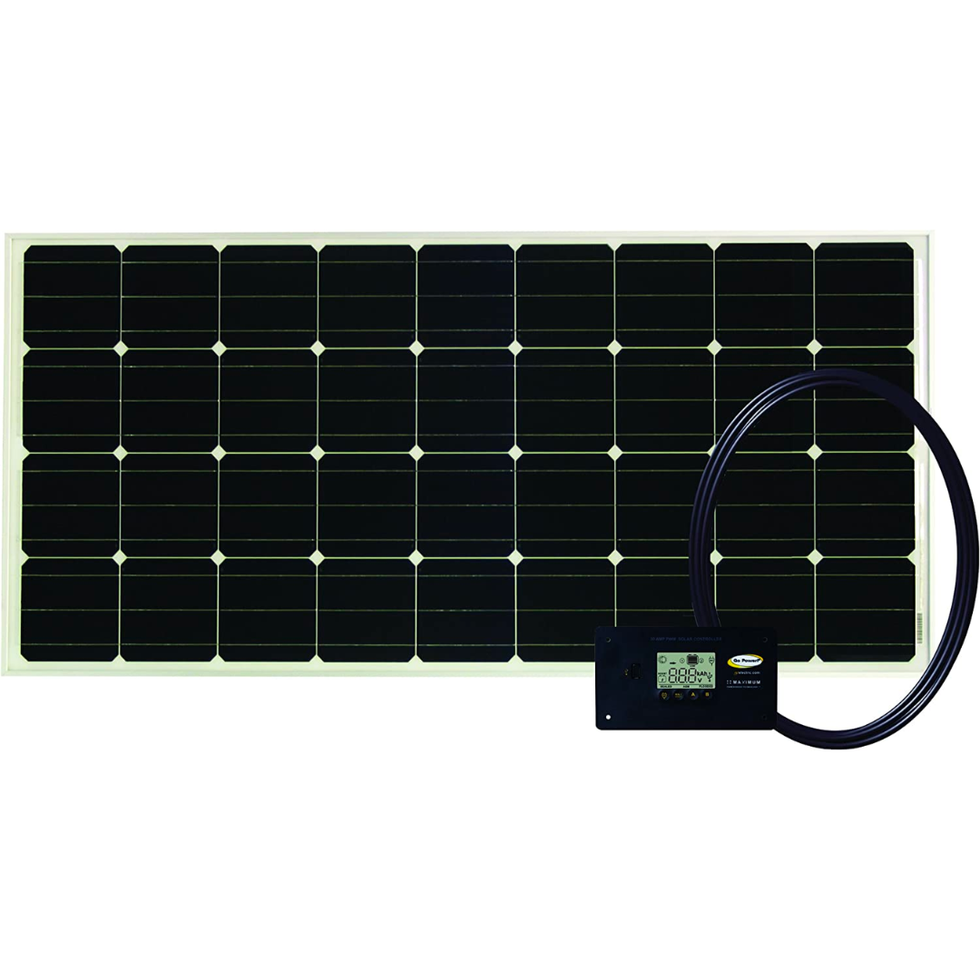
This extremely large 12-volt panel draws up to 190 Watts of power to keep any battery charged on long trips, camping, or on the road. It’s a bit heavy–26 pounds–but its anodized aluminum frame and durable tempered glass panels hold up well against rough weather. Customers report easy installation and that the controller maintains power in their RVs even in less-than-ideal conditions like partly cloudy skies and rain.
If you need more power, the company sells an expansion kit that doubles the output. It’s designed for seamless connectivity between your existing solar power system and the panels you want to add for more power. If you need a lot of juice, this is probably the best mounted panel for the job.
Renogy 100W 12V Flexible RV Solar Panel
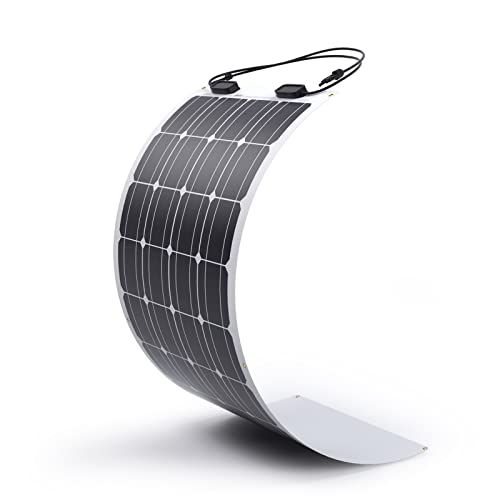
This bendable RV solar panel is great for uneven surfaces like Airstreams and vans, or propped up facing the sun at your campsite. It weighs just 4 pounds and can withstand high winds, rain, and snow.
The mounting uses silicone adhesive for permanent installation without any drilling. It can flex up to 248 degrees without any micro-cracks forming, which is handy for hitting the right angle after mid-day.
Customers like the slim profile of these panels and say the output is great for such lightweight panels. These are best suited for small camper set-ups or as expansions to larger RV solar energy systems, as just one or two of these aren’t enough for a large RV with a lot of appliances.
Bluetti PV350 Solar Panel

Bluetti makes some of the best solar gear in the industry, and the PV350 solar panel is an upscale buy that’s worth the investment. It absorbs up to 350 watts per hour, which is huge for a folding panel. At the same time, it’s remarkably compact, folding down to a compact 35.6- by 24.1-inches for easy storage.
There’s a downside, of course–it weighs 30 pounds–which may make it tough to set up. You can’t beat that size-to-wattage ratio, though.
It’s also designed for efficiency. The cells are wired in parallel, rather than in a daisy-chained configuration like you find in most cheaper panels. This allows it to continue collecting power when mostly shaded. (Many panels will stop operating if they aren’t getting very good coverage.)
The PV350 is also well-built. Nick took one on a trip through the deserts of Utah and Nevada, where it saw no shortage of hard treatment from dust, wind and my own rough handling, but emerged without any major damage. That said, it isn’t fully waterproof: You can leave it out through a light drizzle, but avoid charging on rainy days.
Goal Zero Nomad 100

Goal Zero is known for making tough, outdoor-friendly solar gear for camping. Case in point, the Nomad 100 is perfect for pretty much any camping scenario, whether you’re charging up your RV or a portable power station. Weatherproof and built like a rock, it’s designed with tie-down loops around the frame. These are great for both staking it into the ground or affixing it to your RV rooftop to keep it in place when the wind kicks up.
The Nomad 100 folds down to a comparatively small 20- by 15- by 2-inches, it’s easy to pack and move around. It draws 100 watts, which is good for its size, but you may need a few of them to fully charge up an RV.
To that end, you can daisy chain multiple Nomads without a splitter. That said, its 8mm plug is not universally compatible with all systems and power stations: Many support it, but you may need an adapter if yours has a different port.
Jackery Explorer 2000 Plus Solar Generator Bundle

You see Jackery gear everywhere in the RV/van life scene these days because the brand offers such an expansive variety of dependable solar products. After using many Jackery generators, I found the 2000 Plus brings the perfect balance between physical size and capacity: Its 2000-watt-hour capacity is plenty for most campers, but it isn’t so large that you can’t bring it out when you need it.
Weighing a hefty 96 pounds, it isn’t exactly light, but compensates for the heft with integrated wheels and a telescoping handle so you only need to lift it to get it on and off your vehicle. Plus, it has a 25A plug, so it's designed specifically to bring on an RV.
This kit pairs the 2000 Plus with two of Jackery’s 200W SolarSaga panels , which are among the best you can find. They’re very durable—I can’t tell you how hard I’ve worked them over the years. Plus, they fold down to an easy-to-carry package, and are reliable in most sunlight conditions.
And, if you need even more juice at some point, you can expand the 2000 Plus’ capacity with up to five of the brand’s 2000 Plus battery packs , which can store as much as 12,000 watt-hours of power. That’s more than you’ll ever need on an RV, but it’s always nice to have the option.
EcoFlow 220W Bifacial Foldable Solar Panel

Bifacial panels, which can absorb solar energy using both their front and back face, aren’t as common among portable and RV panels as they are for home setups, but they definitely offer benefits while camping. By capturing solar energy from the light that bounces onto the back of the panel, they can capture more energy and be more efficient when it isn’t placed perfectly.
According to EcoFlow, the second face of their 220W Bifacial Foldable Solar Panel gathers 5- to 25-percent more energy than a single-sided panel. Personally. I’d say 25 percent is a stretch, but 15 seems in line with my experience and that’s not nothing: Every bit of juice counts when you’re on the road. I found it especially useful for off-season camping, when the days are shorter and you get a narrower window for gathering sunlight.
I also loved this panel’s tent-like stand design, which makes it easier to set up and place than other folding panels. It’s lightweight–just 20 pounds–but it’s also pretty big and can be tough to lug around.
Q+A With Our Experts

What kind of tools do I need to install a solar panel on my RV?
Much of the work can be done with basic tools you likely already have like a cordless drill , screwdrivers , and wrenches . I’d also recommend keeping a pair of wire cutters and strippers handy, as well as a hydraulic crimper, a MC4 connector/crimper tool, and a digital multimeter . As with any project involving electricity, it’s always a good idea to use dielectric tools that won’t conduct electricity.
Will mounting a solar panel on my RV change how I drive?
It’s unlikely. Typically your panels are more or less flush against the roof, which shouldn’t noticeably alter the aerodynamics of your RV.
Any advice on how to park my RV for great solar panel placement?
Try to park with the front to the east and the rear to the west. This will provide your roof with the maximum amount of sun throughout the day. As an added bonus, if you’ve got a typical left-sided fridge it will keep it somewhat shaded, reducing its power demand. When parked in direct sun, keep your window blinds closed to keep the interior cooler, further reducing the strain on your fridge.
Can I use my solar panel to jump-start my RV?
The short answer is no. The long answer is that the energy collected from a solar panel needs to be converted to a voltage and amperage required by whatever you want to use or charge. Without a charge controller to regulate power flow, and monitor battery charge levels, the current your solar panel outputs won’t be compatible with your RV’s battery.
Nick Hilden is a writer, globetrotter, and jack-of-many-talents who has written gear reviews for the likes of Runner’s World , Popular Science , Men’s Health , Thrillist , the Daily Beast , the Los Angeles Times , Greatist , and the Manual , and his lifestyle, culture, and tech writing has also appeared in Scientific American , Afar , Salon , Vice , Healthline , and many others. Before entering journalism some 15 years ago, he worked as a bartender, brewery manager, sound engineer, recording and touring musician, cook, teacher, and in a variety of other trades. These days, he lives all over the world, performs music sporadically, and spends a lot of time thinking how to best improve his Honda Element conversion.
Danny Perez is a Commerce Editor for Popular Mechanics with a focus on men's style, gear, and home goods. Recently, he was coordinator of partnership content at another product journalism outlet. Prior to that, he was a buyer for an independent men's shop in Houston, Texas, where he learned all about what makes great products great. He enjoys thrifting for 90s Broadway tees and vintage pajama sets. His spare time is occupied by watching movies and running to impress strangers on Strava.

.css-cuqpxl:before{padding-right:0.3125rem;content:'//';display:inline;} The Perfect Road Trip .css-xtujxj:before{padding-left:0.3125rem;content:'//';display:inline;}

10 Great Gadgets For Your Next Road Trip

What It's Like to Drive Across the Top of Alaska

The No-GPS Road Trip

10 of America's Must-See UFO Destinations
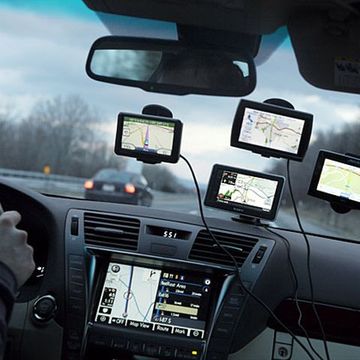
The Best GPS Units For Your Next Hike or Road Trip
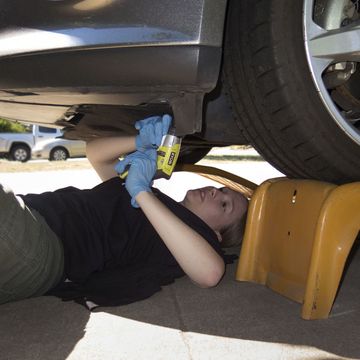
How to Prepare Your Car for a Road Trip in One Day
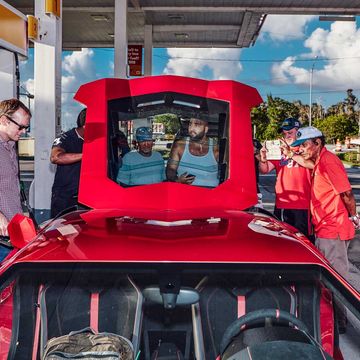
I Took a Road Trip in a Supercar

The Best Hotels Near Zion National Park

22 Great Grill Accessories for Better Barbecues
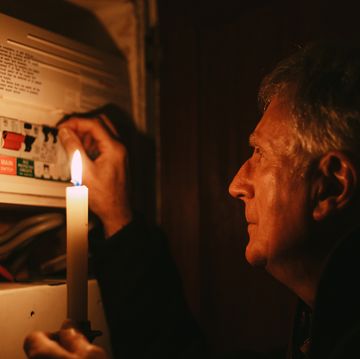
Surviving the Inevitable Summer Power Outage
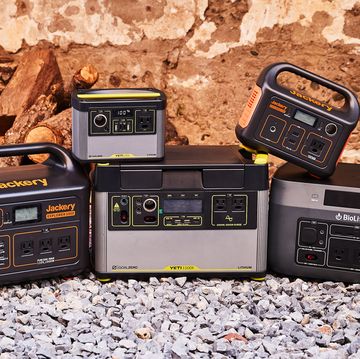
The 9 Best Solar-Powered Generators

7 Best Solar Panels for RV: A Complete Beginner’s Guide
Written by : Nikola Gemeš | Last Updated: February 7, 2024

Renogy 175 Watt 12 Volt Flexible Monocrystalline Solar Panel
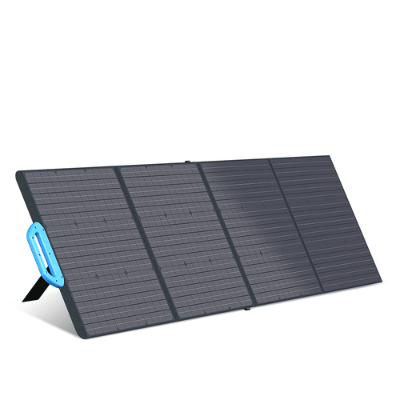
BLUETTI PV200 200W Solar
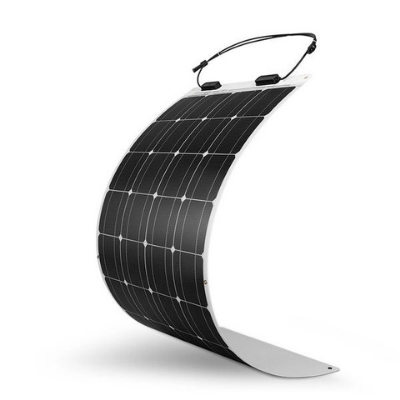
Renogy 100 Watt 12 Volt Flexible Monocrystalline Solar Panel

Jackery SolarSaga 100W Solar Panel
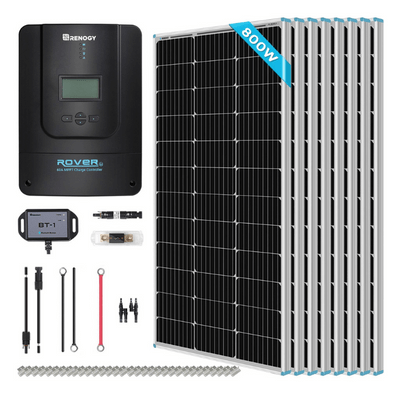
Renogy 800W 12V/24V Monocrystalline Solar Premium Kit
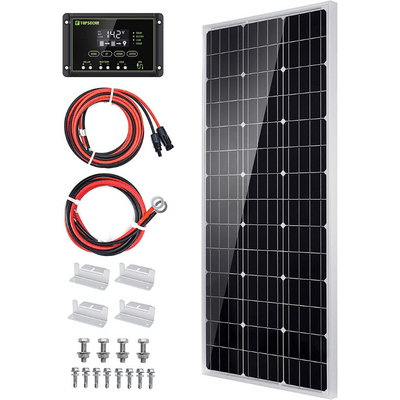
Topsolar Solar Panel Kit 100 Watt 12 Volt Monocrystalline Off Grid System
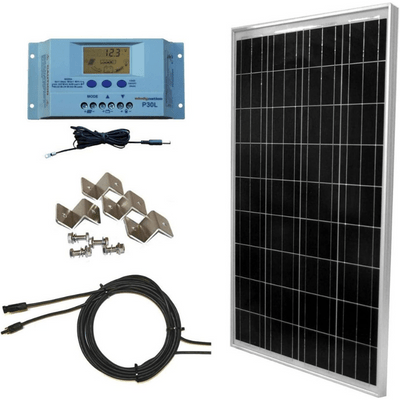
WindyNation 100 Watt Solar Panel Off-Grid RV Boat Kit
A gimmick or free electricity on the road? We present you with the best solar panels for RV and answer the ultimate question: Are they worth it at all?

When I first saw solar panels slapped on an RV I immediately thought of one of my all-time childhood movies “Race the Sun." It’s about teenagers who build their solar car to race across Australia.
Now, as a camping and RVing enthusiast, I realize that solar panels can’t power the RV but can make my trip much more convenient and sustainable.
But what sort of problems will solar panels solve in your RV?
Coupled with a capable solar battery, I use them to power the appliances and lighting in my RV. This allows me to camp away from crowded campsites and become fully independent of the grid.
What is more, it allows me to camp sustainably and offset the carbon emissions of my RV by using a renewable source of electricity.
The 7 Best Solar Panels for an RV or Camper Van (Reviewed by An Electrical Engineer)
1. renogy 175 watt 12 volt flexible monocrystalline solar panel (best overall).
Wattage: 175 watts | Panel Type: Monocrystalline | Water Resistance: IP67 | Weight: 6.2 lbs
What’s thin as a coin and bends up to 248 degrees? It’s my favorite solar panel for RV on this list.
The Renogy 175 Watt 12 Volt Monocrystalline Solar Panel has everything I expect from a top-shelf solar panel for RV use.
It weighs only 6.2 lbs so I confidently fixed six of these to my RV roof.
What is more, they are extremely flexible, so they’ll adapt to any trailer style. That’s a big consideration for me.
Scroll down to the Flexible vs. Rigid Solar Panels section to read my opinion, but in short, if you have the budget — go for flex.

The Renogy 175W has great solar efficiency thanks to transparent dots on the surface that capture the sun's rays even when coming at an angle.
In my use, even on a hazy day on Washington state shore, two of these panels provided well over 200 watts.
- Extremely flexible
- Ultra lightweight
- Resistant to high winds
- IP68 water and dust resistant
- Anti-scratch surface
- Easy to install
- Mounting eyelets too small
- Connection leads could be longer
Why Do I Like It?
I glued four of these panels to my RV roof while the remaining two are movable — I use mounting eyelets to rig them on the trailer side that receives the most sunlight.
2. BLUETTI PV200 200W Solar (Runner up)
Wattage: 200 watts | Panel Type: Monocrystalline | Water Resistance: IP65 | Weight: 16.1 lbs
Following excellent solar generators like the AC200P and the beastly EP500 , Bluetti strikes back with a formidable portable solar panel kit that can make a perfect RV solar panel system.
On a bright su nny day, the Bluetti PV200 200W Solar charges my AC200P solar generator in about 5 hours.
If you’re not big on DIY and mounting stuff, you’d be happy to hear that you can get these up and running in less than 30 seconds.
Unfold, connect, and prop it up.
Now, this can be a deal-breaker to some — there are no mounting eyelets or any other way to fix this panel permanently to your RV roof.

I guess you could glue it with silicone or use EternaBond tape , but since there’s no rim, you’ll have to cover some of the solar cells as well.
So why is this solar panel on the list at all?
Because not every camper needs a mini solar power plant on the roof. Most users only need to charge a few gadgets like a laptop, camera, phone, and drone.
These people use portable solar generators and pair them with portable solar panels, which they prop up on a sunny spot, while their RV stays in the shade.
- High-efficiency panel
- IP65 water and dust resistant
- Super easy to install
- No mounting eyelets
- Portable use only
Not all places are accessible by RV nor they should be. I can take these solar panels down to the beach and keep the party going.
3. Renogy 100 Watt 12 Volt Flexible Monocrystalline Solar Panel (Best Lightweight)
Wattage: 100 watts | Panel Type: Monocrystalline | Water Resistance: IP67 | Weight: 4.2 lbs
This solar panel for RV is just 0.08 inches thick which is 90% thinner than any rigid solar panel in the 100-watt range.
The best way to fix this to your RV roof is to use silicone adhesive or EternaBond tape.
Like on the 175W version, there are six eyelets but they are too small for mounting screws.
So you best use them with rigging cords for non-mobile applications.
If you want lightweight and reliable RV solar panels that will power your basic devices, you won’t find a better-priced option.

- Easy to install
- 100 watts might not be enough for some users
These solar panels are just 48 x 21 inches which gives me plenty of options to combine and mount them, either along or across the roof axis.
4. Jackery SolarSaga 100W Solar Panel (Most Versatile)
Wattage: 100 watts | Panel Type: Monocrystalline | Water Resistance: IP65 | Weight: 9.1 lbs
There’s this thing about Jackery products that make them similar to Apple gadgets:
They are reliable, compatible only with other Jackery products, and have an army of loyal customers.
The Jackery Solar Saga 100W Solar Panel is beautifully designed, just like every Jackery product. It folds in half and has two comfortable carrying handles in case I need to deploy them away from my RV.
Keep in mind that the Solar Saga is a 100% portable solar panel, just like the Renogy PV200.
This makes it perfect for boondockers who prefer to keep their vehicle in shade and need to power only a few essential gadgets.

I’ve used two Solar Saga 100W solar panels with my Jackery Explorer 1000 and after 8 hours of charging I could run a mini fridge for 17 hours.
Unlike the Renogy PV200, this solar panel for RV comes with four mounting eyelets so you can fix it to your RV roof or side.
Unfortunately, these panels are only compatible with Jackery power stations.
- Super easy to install
- USB ports for direct device charging
- Works only with Jackery solar generators
- Only 4 solar panels can be connected
The Solar Saga 100W comes with USB-A and USB-C cables. In a pinch, I can charge my phone and laptop directly from the panel.
5. Renogy 800W 12V/24V Monocrystalline Solar Premium Kit (Best Premium)
Wattage: 800 watts | Panel Type: Monocrystalline | Water Resistance: IP32 | Weight: 112.8 lbs
Renogy made an offer I could hardly refuse.
They packed 8 rigid-frame 100-watt monocrystalline panels with the Ro ver 60A charge controller and a Bluetooth module.
With this kit on your RV roof, you’ll be able to harvest about 3.5-4 kWh of sunlight a day. The panels have a heat-dissipating back sheet that ensures smooth output performance without hotspots.
I was happy to discover that every panel comes with pre-drilled holes in the back frame and Z-brackets for mounting solar panels on the RV roof. When you mount it on the roof, this panel doesn’t go anywhere.

But it was the charge controller that sweetened the deal. If you have a large RV and want every convenience of a mobile home, the Rover 60A allows you to slap another 8 solar panels and boost your system to 1.600 watts!
Using the Renogy DC Home App I can always check what’s going on there, as the controller sends power data directly to my phone via Bluetooth.
This way I can always tell how much power is produced, how much I use, and even if there’s something wrong with the system. Pro-level baby!
- 8 x 100W panels
- Solar charge controller
- Bluetooth module
- Automatically detects system voltages
- Compatible with all kinds of batteries
- Rigid-frame panels
Apart from making my RV virtually independent from the grid, these solar panels for RV make a great home outage solution. When the power goes out, just move to your RV and continue whatever you were doing.
6. Topsolar Solar Panel Kit 100 Watt 12 Volt Monocrystalline Off Grid System (Best on A Budget)
Wattage: 100 watts | Panel Type: Monocrystalline | Water Resistance: IP65 | Weight: 15.8 lbs
The price of solar gear is dropping, and now you can get decent RV solar panels for less than $150.
When I saw the price range of the Topsolar Solar Panel Kit I was suspicious at first. Especially since you get all the cables, Z-brackets, and — listen to this — a 20A charge controller.
The heart of this system is a rigid-frame monocrystalline solar panel with a waterproof IP65-rated junction box.
It means your wiring is completely protected from dust particles and low-pressure water jets.

Still, as with all IP65-rated panels here, you don’t want to leave the junction box or connectors in the rain.
Remember: The panels are weatherproof but the rest of the equipment are not.
So why isn’t this solar panel for RV on the top of the list?
First, I wasn’t aware till I tried it that the charge controller it comes with works only with lead acid batteries. Also, the wiring connectors look and feel flimsy, so I don’t know when I’ll need to replace them.
And, the screws that hold in the charge controller wires are so tiny and so tight that I can hardly unscrew them without stripping them.
All in all, with a few tweaks this could be a solid and inexpensive RV solar panel for someone getting into the world of solar power.
- Very sturdy panel
- Fast charging
- Inexpensive
- Cheap wiring hardware
- Works only with lead acid batteries
- Menu button labeled “Mune”
With a more versatile controller and new wiring, the Topsolar 100W solar panel can be an inexpensive building brick for a full-size RV solar system.
7. WindyNation 100 Watt Solar Panel Off-Grid RV Boat Kit (Budget Alternative)
Wattage: 100 watts | Panel Type: Polycrystalline | Water Resistance: N/A| Weight: 19 lbs
The problem with these low-cost RV solar panels is that they often run out of stock. So if you can’t find a good deal on a Topsolar 100W panel, the next best choice in this category is the WindyNation 100 Watt Solar Panel .
This solar panel is even cheaper and comes with a better 30A charge controller, so you can add more solar panels in the future.
The P30L charge controller that is in the box can handle up to 4 x 100W solar panels in a 12V system and up to 8 x 100W panels in a 24V system.

On the downside, when my panel arrived, it came without any connectors and mounting hardware.
I’ve emailed customer service and they sent the missing stuff with no questions asked.
Still, I had to buy at least two fuse holders and fuses (automotive ATC-type will do) and the 30-amp gauge wires to connect the P30L to my battery bank.
- 30A charge controller included
- No water and dust resistance
- No fuse holders included
If you want to stick a couple of solar panels on your RV roof that will survive whatever weather throws at them and still have enough money for the next 3 road trips, these are the panels for you. Just keep that electric gear tucked inside.

7 Best Solar Generators For RV: Reviews & Buyer’s Guide
What Are RV Solar Panels?
RV solar panels are similar to home solar panels. But instead of powering your home, they use the power of the sun to charge your RV battery.
When your RV is on the road or parked in a sunny spot, the solar panels on the roof absorb energy from the sun.
Then you can use the RV battery to power lights and small appliances in your camper.
If you add more batteries that the solar panels can charge, you have more electricity available when camping.
Do You Need To Use RV-Specific Solar Panels?
Whatever vendors want you to believe, there is no such thing as solar panels that are strictly for RV use. Many companies market their products as RV solar panels but only because those panels are suitable for RV use.
These include both portable solar panels which have multiple ways of permanent or semi-permanent attaching to your RV roof as well as flexible solar panels that you can fix to curved surfaces. Flexible solar panels are a bigger investment but provide a higher ROI with high-efficiency rates.
I also want to say that solar panels are not a magic pill.
Not so Free Energy
This “free” and clean power sounds much better than the fuel generator.
But when I say free I mean the sunshine. The hardware can be quite expensive. Sure, prices of solar equipment have gotten a bit more reasonable in recent years, but if you want quality, you still need to pay a hefty sum.
You need a couple of pairs of 100-watt panels and deep-cycle solar batteries to store power and charge the controller that keeps them from overcharging. Then there’s the inverter that turns the DC power into AC power that most appliances use.
When you add those up, you can be looking at a $1,500+ investment up front.
Also, collecting solar power is much more complicated than hooking up to shore power at a campsite. You need to know how much power you'll need on a daily basis and size your system accordingly.
No Shade Where I’m Going
It also means you’ll have to park in full sunshine for most of the day. In other words, you can forget about parking your RV in a nicely shaded campsite where you can throw a barbie and pass a few cold ones.
Don’t get me wrong, solar power is great and worth the investment, especially if you like to boondock on public land away from the grid.
It’s just that for the most part, if you want the maximum power, you need to:
- Open your wallet
- Leave your rig in the blistering hot sun
Are Solar Panels Worth It? Opinions of An Electrical Engineer
How Much Energy Do You Need for an RV?
First, you need to know how much energy you use in your RV in a day. There are two ways to do this. The first one is easier and the second one is free.
1. Use a battery meter
The easiest way to tell your daily consumption is to install a battery meter like this Renogy 500A Battery Monitor . Before installing solar panels, go camping without hookup charging along the way and the monitor will give you the amount of energy you use with ±1% accuracy.
2. Calculate your energy use
This way is 100% but requires a bit of math and planning. In short, you need to find out what each appliance or device in your RV consumes and multiply that by the number of hours you expect to use it.
For example, you have one TV that consumes 100 watts. You guess that you’ll watch TV for about 2 hours per day. So 100W x 2h = 200Wh a day.
You can do the same for every electrical device you want to power while you’re boondocking and you’ll get a rough estimate of the total watt-hours you need. Add a 20% for safety and from there you can estimate how many panels you need.
If you plan to cook outside and only use electricity for things like lighting, TV, and charging your phone or laptop, two or three 100W solar panels and a 1,200Wh battery will do.
However, if you want to power your fridge or AC you’ll need more panels and batteries.
How Many Solar Panels Do I Need For My RV?
Now when you’ve measured or calculated the amount of energy you need daily, there is one more thing to consider:
How much energy do solar panels provide to your battery?
You need to achieve a balance here.
Install too many solar panels without enough battery storage and you're wasting both money and energy that can’t be stored nor used.
On the other hand, slap one solar panel and a row of batteries, and you won't be able to charge them all while the sun's up.
Let’s now calculate energy generation and storage needs.
For example, a high-end 100W solar panel will generate an average of 350Wh per day. Keep in mind that this varies by location and time of year.
You also need to know how many batteries you need to store the power that your RV solar panels generate. One 100Ah 12V battery has about 1,200Wh storage capacity.
I say it again: Your solar panels for RV will only give you the listed number of watts under perfect conditions.
Perfect conditions = direct sun shining directly at the panel
On a rainy day, you’ll be lucky to get 100 watt-hours from your 100W solar panels. The same goes for parking in the shade.
It’s also challenging to estimate the amount of energy you’ll use in a day because days are different. One day you might be outside from dawn to dusk, enjoying nature, hiking, canoeing, and whatnot. The next day might be rainy and you’ll stay inside your RV working on your laptop or watching TV for hours in the evening.
So whatever you do, estimate high.
How Much Do RV Solar Panels Cost?
How much your RV solar panel system will cost depends on what you expect from your solar system. Setting up your RV with solar power is not a cheap project.
On the bright side, there are great solar panels for RV that are available at any price point.
Weekend RVers — Solar System Around $1,000
If you mainly use your RV over the weekend, you most certainly don’t need a solar system that can power a house.
In that case, I recommend buying a solar system that will allow you to use the sun to charge phones, turn on the lights, and power a few outlets.
If you’re not confident about using your RV's original wiring, you can pair your solar panels with a solar generator that already has multiple outlets for both 110V and 12V power.
Solar generators already have a battery and inverter inside, so you only need to plug in the appropriate solar panels for RV.
Here are a few good combos:
Combo 1: The Bluetti Combo
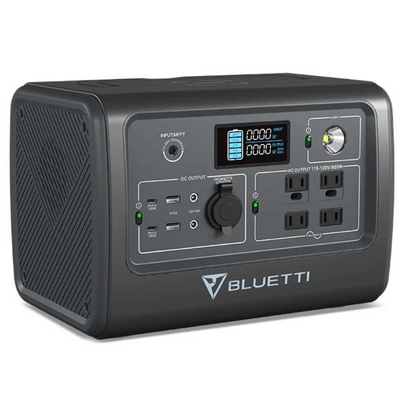
Combo 2: The Jackery Combo

Combo 3: The Renogy Combo

Cost Of Solar Panels: A Walkthrough Guide
Hardcore RVers
If you like to spend several weeks traveling in your RV, I recommend you build a more capable RV solar system.
Higher-end components are better built which leads to fewer maintenance issues. Manufacturers often offer RV solar panel kits that contain everything you need to build a full-fledged solar system for your RV.
For example, the Renogy 800W 12V/24V Monocrystalline Solar Premium Kit costs $1,399.99 and includes eight 100-watt solar panels and a Rover 60A MPPT Charge Controller.
But then you also need an inverter like this Renogy 1000W 12V Pure Sine Wave Inverter for $254.99.
And you need a deep cycle discharge battery. If you want to make the most out of those 3.4 or 4 hours that the sun is directly above, you’ll need at least a 2,000Wh battery. For example, this Renogy 12V 200Ah Lithium Iron Phosphate Battery costs $1,129.
How to Install Solar Panels on Your RV
Now let’s take a look at how to set up RV solar panels in the simplest possible way.
For starters, a solar system for RV has a few basic components:
- Solar panels for RV
- Charge controller
- Solar battery
- Battery monitor with a shunt
- Fuses and breakers
And that’s it.
But how do you hook up solar panels to RV batteries?
You can’t charge the RV battery with solar panels directly. First, you need to hook solar panels to a charge controller and put a battery monitor in between the controller and the RV battery.
It might sound complicated but it isn’t.
Let’s begin with the RV solar panel installation.
Step 1: How to Mount Solar Panels on Your RV Roof
Depending on the kit you bought, you’ll either have to use Z-brackets or screws or silicone adhesive.
If you’re going with screws, mount the brackets and set your panel where you want it, and mark the holes for drilling.
Now, this part is super important. You’ll be drilling through your RV roof so you don’t want any water to leak inside.
I used a Dicor Roof Sealant . Just apply some sealant over the markings so that when the screw goes in it pulls into that membrane and makes a watertight seal.
If you're gluing the panels or using the tape make sure the adhesive makes a complete seal around the edges as you don’t want any moisture or dust to accumulate under your flexible solar panels.
Step 2: How to Connect the Panels
If the wires you got in the solar panel kit are too short, you can use an extra IP65-rated junction box.
From there, lead the wires into a circuit breaker . I prefer circuit breakers to fuses because I can disconnect the panels from the rest of the system with a flick of a switch.
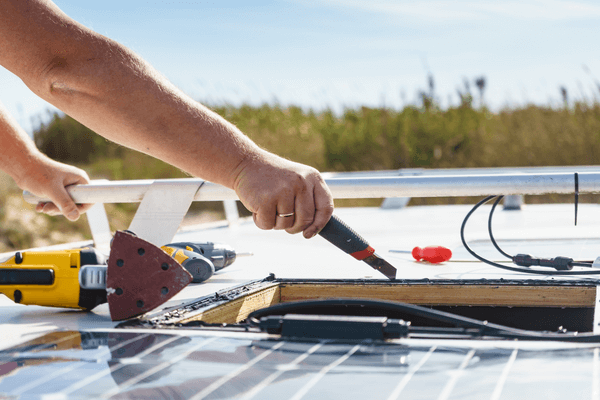
Step 3: How to Connect the Battery
Now, remember, you don’t want to hook your panels to the charge controller until you’ve hooked up the battery.
Connecting the battery is quite simple. You’ll need a fuse in between there, so from the positive side of the charge controller go to the fuse and form there to the positive side of the battery.
And on the negative side, first, lead a wire from the battery monitor shunt to the charge controller and then from the battery monitor to the negative side of the battery.
Once you hook up the charge controller to the battery, it’s going to power up the display. From there you can finish hooking up the solar panels to the charge controller and turn on that little breaker.
And that’s pretty much it. Now you can see what’s coming from solar panels into your battery.
Rigid vs. Flexible Solar Panels: Which One Is Best for RVs?
Both rigid and flexible solar panels have the same job but they are built for different applications.
Rigid Solar Panels
Usually have a metal frame and are encased in sturdy glass. This makes them much heavier, but also much more durable.
In the past, rigid solar panels were considered more efficient than their flexible counterparts. However in recent years, technology has advanced, so now they’re an equal match.
However, two things haven’t changed:
- The rigid solar panels will take up less square footage than flexible panels.
- Rigid solar panels are usually less expensive .
Finally, rigid solar panels have a less tendency to overheat. Flexible panels sit directly on the RV roof so there’s nowhere for the heat to escape. Rigid solar panels have raised mounts that allow airflow all around them.
On the downside, the mounts produce more drag on the road, which translates to more fuel spent.
So to sum up:
- More durable
- More efficient (in general)
- Less expensive
- Better cooling
Flexible Solar Panels
Flexible solar panels are much thinner and built like laminate materials so they are bendable to an extent. This makes them perfect for curved or streamlined surfaces like boat hulls, RV roofs, etc.
Since they are glued or screwed down to the RV roof they don't create any drag while on the road.
Flexible panels also weigh much less, which makes them perfect for RV and marine use. No one wants to put more weight than they already haul around.
These perks combined make flexible solar panels for RV much easier to install on your rig. In some cases, you won’t need any tools but a tube of silicone adhesive or EternaBond tape.
Flexible solar panels are also more portable. Removing and storing rigid solar panels is much harder. I’ve never heard of anyone in my RV community doing that.
On the other hand, you can easily remove flexible panels from your RV roof to slide them into any bay for storage.
So what do we have so far?
- Lightweight
- Fits any surface
- Easier to mount
- More portable
- More expensive
- More tendency to overheat
Verdict: Rigid vs. Flexible Solar Panels
If you ask me, solar panels for RV have to be either flexible or portable. Rigid solar panels are not just 70% heavier, but also require more complicated mounts, not to mention the additional drag on the road.
Can you run an RV on solar power?
Yes, you can run an RV on solar power. If you need to power just basic RV systems, you can start with solar systems and a battery bank. However, if you want to power the appliances you’d use in your home, you need an inverter to allow you to use a 110-volt system.
What is the hardest part of boondocking in your RV?
The hardest part about boondocking in my RV is water conservation and power conservation. Solar panels can help with the latter.
Can you run an RV air conditioner with solar power?
Yes, you can run RV air conditioners with solar power. But keep in mind that Ac units suck up a lot of power so you’ll need lots of solar panels and a large battery bank.
How many solar panels do I need to run 50 amps in my RV?
You need two 100-watt solar panels to run 50 amps a day in your RV.
Can off-grid solar systems work 24 hours every day?
Yes, off-grid solar systems are designed to work day and night 24/7.
Which is better for the money: RV solar panels or generators?
A generator is always cheaper upfront, but then you have to stop to refuel it, plus you get constant noise and the smell of diesel. RV solar panels are more expensive upfront, but once you clear the bill they keep giving as the power source is 100% free. In addition, you’ll rarely have to do anything about them, while the generators need regular maintenance.
Are RV Solar Panels Worth It?
RV solar panels are definitely worth the investment.
Some of you will choose an inexpensive RV solar “starter pack” with a simple charge controller and a lead acid battery.
Enough for charging a few devices between shore hookups.
Or you may want full independence from the grid and splurge on 8x100W flexible solar panels + pure sine inverter and LiFePO4 battery with 3,500+ discharge cycles.
Others will go for maximum flexibility and rig up portable solar panels for RV and use a solar generator unit that is both an inverter and a battery in one.
Let’s be honest — in any case, the upfront price is higher than what you’d pay for the fuel generator.
But once you’re past the price point, everything is pure gain — both for you and the environment.
So, let me ask you this:
What price are you willing to pay to ditch the nasty exhaust fumes and harness the clean and free energy of the sun?
My Recommended Solar Panel for RV
Out of all the solar panels on this list the Renogy 175 Watt 12 Volt Monocrystalline Solar Panel takes the cake for sure. Its feather-light 6.2 lbs allows for easy installation atop any RV, without sacrificing durability or power.
What sets it apart? The innovative transparent dots on its surface that efficiently capture sunlight from various angles, ensuring superior performance even under the diffuse light on a cloudy day. This panel not only meets but exceeds expectations with its remarkable flexibility, adapting seamlessly to any RV design. For those contemplating the leap between flexible and rigid solar panels, the Renogy 175W is a testament to how flexibility can significantly enhance your RV's energy solution without compromising on efficiency.
Ready to revolutionize your RV travels? Invest in the Renogy 175W today.
I Recommend
The RENOGY 175 WATT 12 VOLT MONOCRYSTALLINE SOLAR PANEL
Nikola Gemeš
Nikola, an electrical engineer, simplifies intricate sustainability subjects for his audience. A staunch environmental conservationist, he embodies his beliefs daily through recycling and cultivating his own food.
Quick Links
Green Living Guides
Inspiring Green News
- Green Directory
- Green Store
Electronics Recycling
Category: Green Blog , Product Review , Renewable Energy , Solar Power
Leave a Reply Cancel reply
Your email address will not be published. Required fields are marked *

GreenCitizen is an environmental conservation company providing you with information, services, and products to help you live a sustainable life.
Join Our Newsletter
- Most Popular
- Sustainable Living
- Renewable Energy
- Business & Polices
- Environment
- Product Review
Services (United States)
For businesses.
- Business Pickups
- Data Destruction
- Build Wide Pickups
- Product Destruction
- Electronics Recycling Drop-off
- Mail-in Recycling
- Hard Disk Destruction
- How to Recycle ?
Useful Links
- Customer Reviews
- Our Customers
- In The News
- LEED Reporting
- E-waste Crisis
- Data Security
- Global Dumping
- Harmful Effects
- Styrofoam Recycling
- Polyurethane Foam Recycling
- Why Data Security ?
Copyright © 2024 · All Rights Reserved · GreenCitizen
Privacy Policy | Affiliate Disclosure
- Charge Controllers
- Lithium Batteries
- RV Solar Kits
As times have changed for Outside Supply, LLC , so must its business. So with these changes this webpage may contain affiliate links. If you use these links to buy something we may earn a commission. Thanks.
My Travel Trailer Is Prewired for Solar Now What

MY TRAVEL TRAILER IS PREWIRED FOR SOLAR, NOW WHAT?
PRE WIRE FOR SOLAR RVS MAY REQUIRE A DIFFERENT BASE SOLAR KIT AS THE WIRING DONE AT THE FACTORY IS NOT ALWAYS OPTIMIZED FOR THE RETAIL KITS.
Air Airstream travel trailers were some of the first RVs to include prewired for solar. There are many sizes of panels that will work with the prewired RVs. Our Go Power solar kits are designed to pair with the prewired solar wiring on these travel trailers. These prewired solar trailers can come in a couple of different configurations. The cable entry plate is sometimes at one end of the trailer or motorhome and after additional equipment is installed, the ideal solar panel location is across the entire roof.
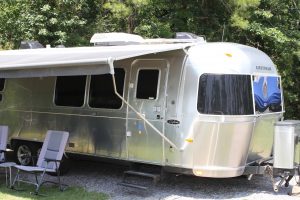
SOLAR TIP: look at manuals for your RV and see what the manufacturer would have installed if you had purchsed the RV with panels
ARTICLE UPDATES
Updated for the new 190 Watt Prewired Solar Kits : Updated in July 2020*
Updated: 05/20/2019 Many of the travel trailers from brands like Forest River, Airstream, and Jayco are coming prewired for RV Solar. This implementation is called the Wired for Solar program.
Updated 06/20/2020 Some travel trailers are coming prewired with installed 10 Amp Go Power PWM Controllers. These will handle the Prewired Overlander Kit
CABLE ENTRY PLATE MAKES WIRING EASY FOR RV ROOF SOLAR
Many of these travel trailers are using the Go Power cable entry plate on the RV roof. These cable entry plates make hooking up a Go Power solar kit a breeze. All that is left is mounting the panels, fusing the wire and installing the charge controller. Most of the hard work of running cables has already been completed by the factory.
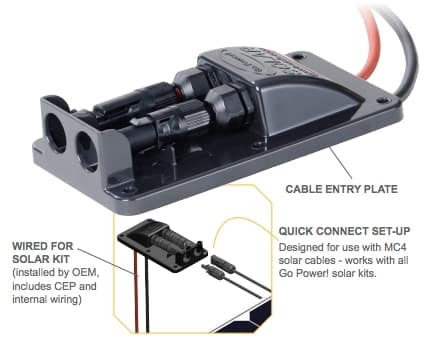
This can save as many as 5 hours off a standard install of solar panels on your travel trailer, fifth wheel, camper or motorhome. Not all of the prewired RVs use these cable entry plates, but instead, use 2 MC-4 wires terminating through the roof.
** CHARGE CONTROLLER PREWIRED FOR SOLAR STICKER ALERT ** Many of the prewired RVs have a sticker that looks like a charge controller. It is usually help in locating placement for the controller and locating the solar cables coming in from the roof.
The newer option is for some Trailers to come prewired with the circuit completed from the cable entry plate through a charge controller and completed at the battery. This is more rare of an install an often uses an SQ designated charge controller.
The charge controller below is the Go Power PWM 30 model that is designed for the prewired solar kits. The Prewired For Solar sticker will most likely resemble this device and sometimes is even a template.
SOLAR CHARGE CONTROLLER
** GP-PWM-30-UL-BT **
The Go Power PWM 30 Bluetooth Lithium controller can handle solar arrays up to 570 watts. Primarily for RV use, It is designed for flush panel mounting, but there is an optional knockout box available for surface mounting. To protect and properly charger your house battery bank, the controller has several different battery charging profiles including Sealed, AGM, Flooded, and Lithium. It can charge two battery banks and is our most common RV charge controller. It is UL listed and now has Bluetooth connectivity. There is also a USB port on the front of the charge controller.
Need the controller, you can order here
Prewired for solar knowledge base.
A selection of articles discussing the best way to locate the components of a Prewired RV solar system.
Tips on finding prewired RV solar wires
Finding lost prewired solar wires.
It is very frustrating to find cables that are in an RV that was prewired at the factory, but the locating stickers were removed.
A few tips are look for pictures of your RV on the internet as they often have these stickers still installed in videos and diagrams. Another is to use a tool to search for the cables. These scopes can really help with lots of projects like this and aare a great tool to have around.
Real world issues with finding prewired solar wires
A selection of Prewired RV Solar Kits
WHICH PANELS ARE RIGHT FOR YOUR TRAVEL TRAILER?
There are 2 main types of panels that we have to match the Go Power prewire setups. These panels are rigid solar panels and flex solar panels. The flex panels can curve to match shapes on Airstreams while rigid panels have better warranties and are usually are a little less expensive.
Depending on which travel trailer make and model you have will determine which type of panel is best for your needs.
Go Power setups for travel trailers that include both inverters and solar
There are 2 main kits available from Go Power
There is also a podcast we did about how much solar you might need for your RV.
A few extra items that are often need for travel trailer solar installation.
There are always extra items that mey need to be purchased for installing solar on your travel trailer. Dicor is a common brand people use on their RV roofs when installing. Follow the manufacturers suggestions and instructions to get a proper compatible installation. Make sure your roof on the travel trailer is compatible with whatever type of sealant you choose. Remember that water is your enemy and does not do your trailer any favors.
You will often use more sealant than you think and it is always good to have a little extra around to reseal roof yearly.
Also make sure to follow manfactuirers instructions for installing panels on your camping trailer. Read manual a couple times before attempting install.
Additional reads

Go Power 1500 Watt Pure Sine Wave Inverter
Go Power 1500 Watt Pure Sine Wave Inverter has a GFCI outlet A strong performer for larger loads that demand a clean, pure source of AC power, the Go Power! GP-ISW1500 can run appliances, and sensitive electronic equipment like TVs, stereos, computers and more. The GP-ISW1500 is a good choice for powering appliances, electronic equipment like TVs, stereos, computers, or as a source of emergency backup power. This product is included in the WEEKENDER ISW]Charging System.
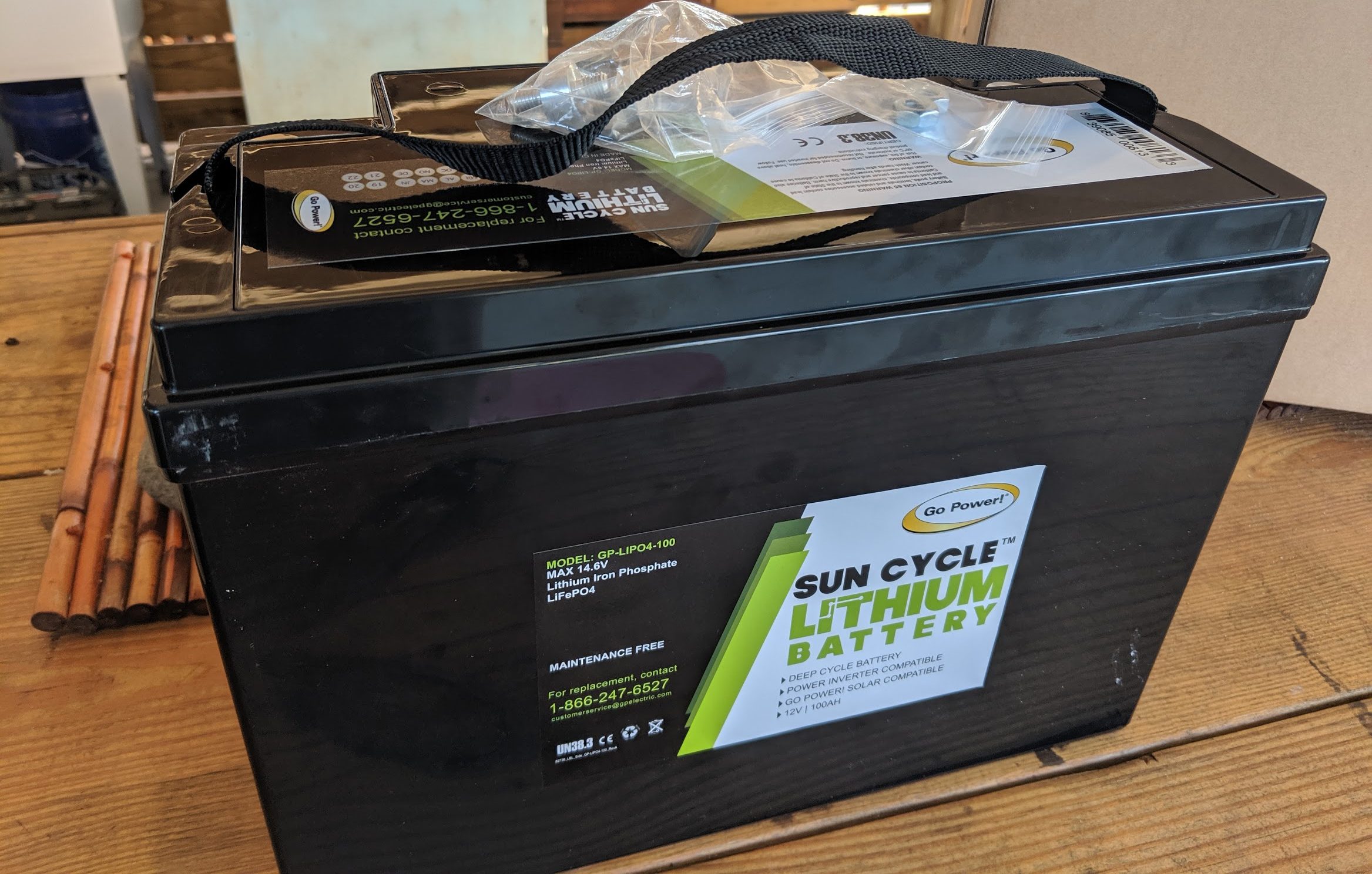
Restarting a Locked Lithium Battery
Power Up Your Adventure: Resurrecting a Dead Lithium Battery in Your RV Understanding the Lithium Battery Lockdown Resetting a locked lithium battery in an RV when it has completely died and the battery management system (BMS) is off can be a complex task, but with careful handling, it is achievable. The BMS performs the crucial role of monitoring the battery’s performance, facilitating operation, and working for the overall safety of the battery.

Travel Trailer Solar Panel Kits 2
Travel Trailer Solar Panel Kits can keep your RV powered even when off grid. Do you have what you need? There are a lot of travel trailers taken off the main road every year. How do these users have the power needed to camp for days on end? They use travel trailer solar panel kits to create a reliable off-grid charging system even when grid or generator power is not available.
Updated 2 weeks ago
5 best RV solar panels and buyer’s guide
Written by Catherine Lane
Find out what solar panels cost in your area
There are few things quite like going out into the Great Outdoors to escape it all. But nothing snaps you back to reality quite like having a noisy gas generator going in the background.
To make your RV camping experience the quiet getaway, you’re looking for, you may want to consider getting RV solar panels. Not only do they keep the noise level down, they keep your pollution down, too!
However, finding the right RV solar panels can be tough. That’s why we’ve broken down what you should look for when buying them.
Here are our top picks:
Editorial note: This is an unbiased review: we have no financial ties with any of the companies mentioned, nor do we earn money from affiliate advertising. The content of this blog is based on research and information available at the time of writing.
What are RV solar panels and how do they work?

Image courtesy of RV Master Techs
RVs have batteries within them that are able to power lights and small appliances, but they won’t last very long. If you want to be able to use things like your microwave and TV, then you’re going to need an external power source. That’s where RV solar panels come in .
RV solar panels work like a regular home solar system - the solar panels convert sunlight into electricity. Except instead of the solar panels powering your home, they charge your RV batteries.
You can also get additional batteries that the solar panels can charge, so you have even more electricity available to you when you’re camping.
An RV solar panel system consists of 4 main components:
Solar panels to convert sunlight into electricity
A charge controller to prevent your battery from overcharging
An inverter to convert the DC solar electricity into usable AC power
A battery to store the electricity
Reviewed: 5 best RV solar panels
We picked our 5 top solar panel kits for RVs and motorhomes to help you narrow down your search.
1. Renogy 400 Watt 12 Volt Solar Premium Kit: Best overall
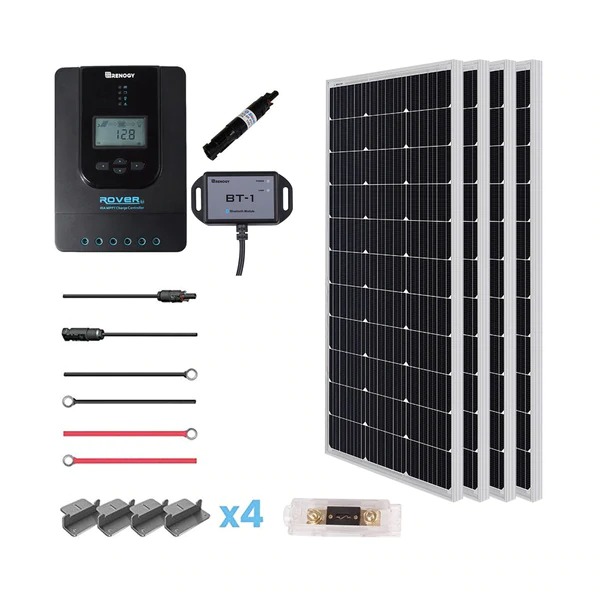
Image courtesy of Renogy
Renogy’s 400-watt solar kit gets our pick for the best overall RV solar kit. It comes with four 100-watt monocrystalline solar panels, which have a 25-year production warranty and an efficiency rating of 21%.
The kit also includes a 40 Amp MPPT solar charge controller, four Z-Brackets for mounting, and Renogy’s Bluetooth module, which lets you monitor and manage the system from your smartphone.
2. WindyNation 100 Watt Solar Panel Off-Grid Kit: Runner-up
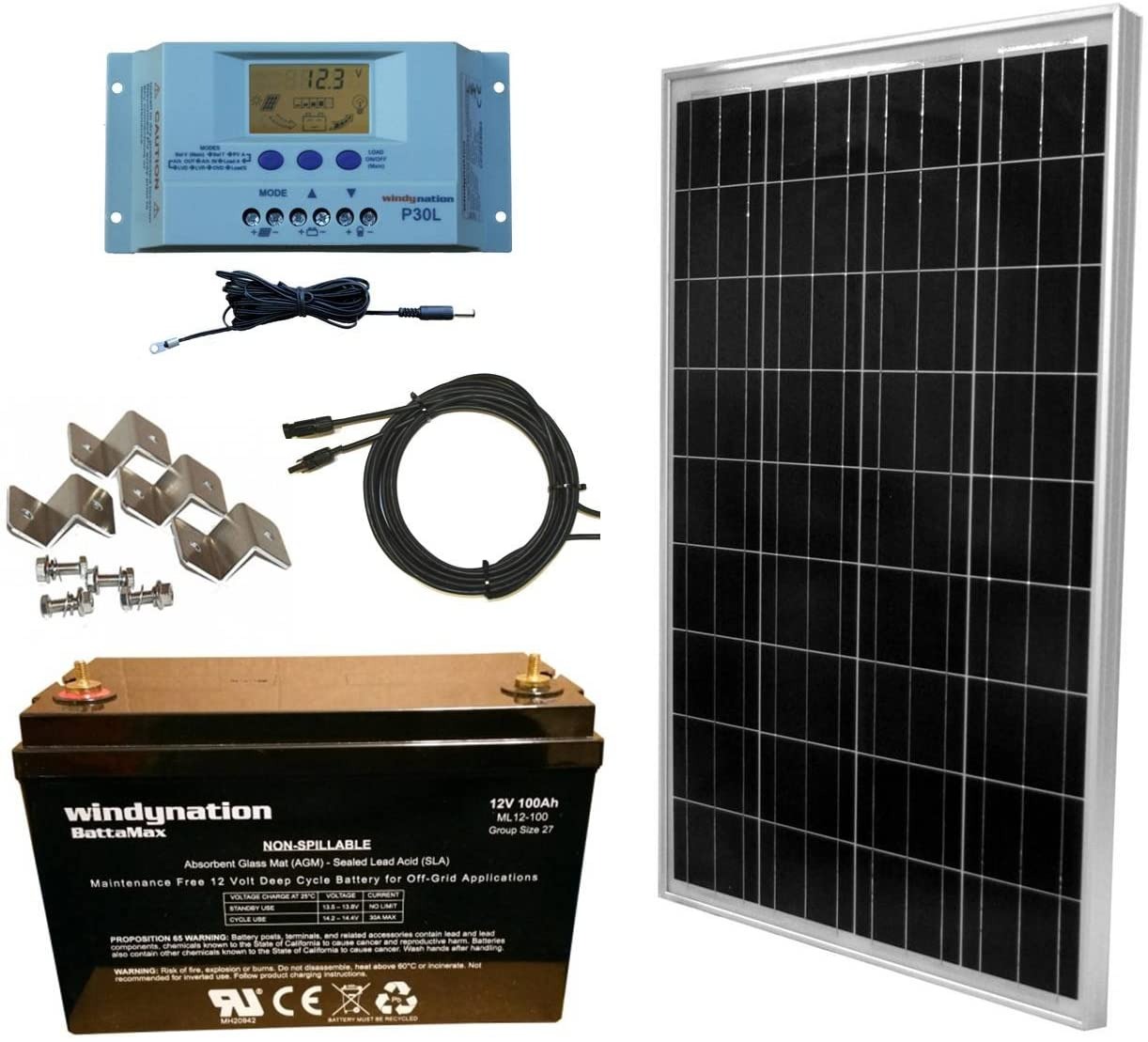
Image courtesy of Amazon
WindyNation offers a 100 watt, 12 Volt solar panel kit that is great for boondockers who don’t use a lot of power. The kit includes one panel with a power output of 100 watts, a 20 amp PWM charge controller, four Z-brackets for mounting, cabling, and solar connectors. It also includes a 100 Amp-hour absorbed glass matt (AGM) lead-acid battery.
According to WindyNation, this panel will produce 350 watt-hours (Wh) of electricity per day. That isn’t a lot, but the charge controller included is able to handle up to four 100 watt solar panels , so you can expand the system in the future. This kit’s great online reviews and included equipment are what make it our best overall runner up RV solar kit.
3. Go Power! 130 Watt Portable Solar Kit: Best portable RV solar setup

Go Power!’s 130-watt portable solar kit is great for RVers who don’t want to install a roof-mounted solar system. The foldable, 130-watt panel is easy to store and to deploy with its adjustable legs and carrying case. The kit also comes with a 10 Amp PWM charge controller, cabling, and battery clamps for recharging. The panel has a 25-year warranty.
Go Power! gets our pick for best portable RV solar kit because it is lightweight, foldable, and comes with a storage case. Plus, it can be paired with an existing rooftop system or just as supplemental power. What more could you want from a portable solar panel?
4. HQST 100 Watt Polycrystalline Solar Panel Kit
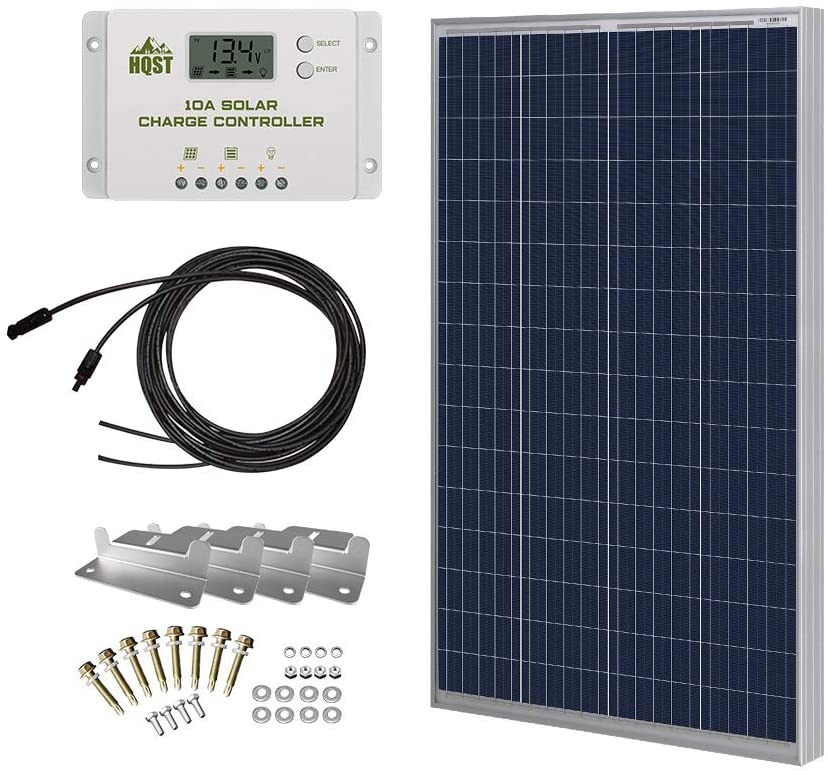
The HQST 100 Watt polycrystalline solar panel kit is a great RV solar starter kit. It includes one 100 watt panel, a PWM charge controller, connector cables, and Z-brackets for mounting. You can purchase the kit with either a 10A or 20A charge controller, but the 20A charger will bump up the price a little bit.
5. Renogy 100 Watt 12 Volt Flexible Solar Panel and Charge Controller
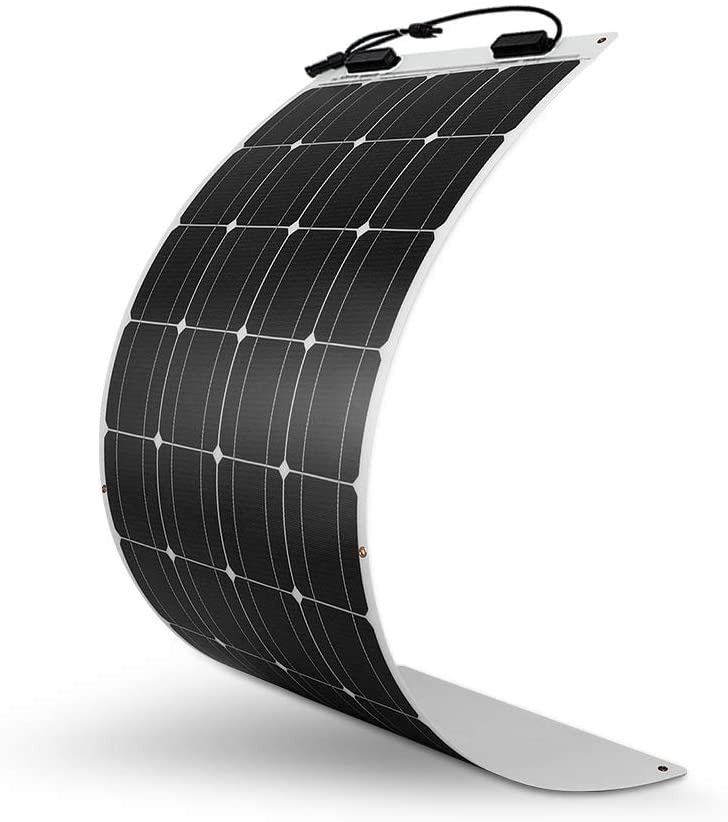
Renogy not only makes great rigid solar panels, they make flexible solar panels that are great for RV owners, too. This kit includes one 100-watt flexible monocrystalline solar panel and a 30A charge controller. The panel can be installed using silicone structural adhesive on the backside of the panel.
This is our pick for best flexible solar panel because Renogy is a reputable brand, so they can likely help you if there are problems or warranty issues. It also has outstanding reviews on Amazon.
Do you really need RV solar panels?
While RV solar panels are great, they aren’t necessary. In fact, most RV campers probably don’t need solar panels - if you spend most of your time camping on campgrounds with power hookups, then RV solar panels probably aren’t right for you.
But, for all of the boondockers out there, RV solar panels are a great, cost-effective investment. Boondocking is when you camp off-grid, outside the amenities of campgrounds, including electricity. In this case, RV solar panels can come in handy. They allow you to keep your batteries charged, and you can charge additional batteries for backup power, as well.
Also, because the solar panels slowly charge your batteries, they can end up prolonging your RV battery life. Plus, unlike conventional generators that you may use to help power your RV, you don’t have to worry about buying propane for every trip. Once you invest in RV solar panels, there are almost no additional operating costs unless equipment needs to be replaced.
Learn more : Pros and cons of solar generators
How much do RV solar panels cost?
How much you spend on solar panels for your RV depends on what you need from your solar system. If you use a lot of electricity, you’ll need to purchase more equipment, which will raise the overall price of your RV solar system.
You can find RV solar panel kits for as little as $100 or upwards of $1,000. It really depends on your energy needs. When you’re just starting out, you can get an RV solar panel starter kit between $200 and $500.
Kits in this range will usually include a charge controller, solar cables, and one or two solar panels, which is a great jumping-off point when you’re first getting into solar. But, you’ll probably still need a generator to supplement your usage. Once you gauge how the solar panels are working for you, you may need to buy more panels.
What to consider when buying RV solar panels
There are a few key things to keep in mind when looking to buy solar panels for your RVs.
Your power consumption
In order to find what solar panels are going to work best for your RV, you need to figure out how much power you consume when you’re camping . Based on that, you’ll be able to determine how many solar panels and any additional batteries you might need.
Most RV campers use about 20 kilowatt hours (kWh) of electricity a day. The more appliances you have, the higher your electricity usage will be, and thus the more solar panels you will need.
In most cases, however, two or three solar panels will usually produce enough energy to run most of your small appliances. If you want to run large appliances like a refrigerator or an air conditioner, you’ll need a generator or additional panels and batteries.
You might not know exactly how much power your RV uses, and that’s okay. You can always purchase a basic RV solar kit and do a test run to see how it meets your needs. Then, you can expand the system to include more panels or batteries if need be.
System setup
When you get solar panels for your RV, you can use them one of two ways:
Manually set up portable solar panels
Mount the panels on your roof
For most boondockers, manual setup is relatively easy. You simply lay out your solar panels, connect them to your battery, and face them towards the sun. Then, simply move the panels in the direction of the sun every couple of hours to increase solar production. Keep in mind, however, it is something you have to set up and put away each time you go to a site.
Roof-mounted RV solar panels are also an option if you don’t want to set up portable solar panels. However, you won’t be able to park your RV in the shade, as the roof will need to be exposed to sunlight. You also won’t be able to turn the panels towards the sun to get a little extra juice. Roof-mounted systems could be slightly more expensive, but their convenience can be beneficial to full-time boondockers.
Type of solar panels
There are three main types of solar panels : Monocrystalline, polycrystalline, and amorphous panels. Monocrystalline are the most efficient and the most expensive. If you are limited on space, then monocrystalline panels are definitely the panels for you. Polycrystalline panels are slightly less efficient than monocrystalline panels, so they are a little bit cheaper.
Amorphous solar panels are flexible, thin-film solar panels. Although they are the cheapest option, they are the least efficient. This means you would need more of them to produce even close to what the mono or polycrystalline panels produce. Plus, they must be installed directly onto your RV’s roof using glue, which can cause damage and make them difficult to remove.
Learn more : Types of solar panels: which one is the best choice?
In our opinion, going with a monocrystalline or polycrystalline panel is the best choice for switching your RV to solar power . However, if you have an RV with a curved roof, like an Airstream, then flexible amorphous solar panels might be the best way for you to have a roof-mounted solar system.
If you are using solar panels with your RV, you’ll probably want to get some additional battery banks to store your solar energy. Most RVers choose 12v batteries. You can get lead acid batteries or lithium-ion batteries for your RV, but each comes with its own set of pros and cons.
Lead acid batteries are the most commonly used batteries for RV campers. They’re cheap and durable, which is what makes them so popular. However, they usually need to be replaced after five years, and depending on the type of lead acid battery you choose, it might require regular maintenance.
Lithium-ion batteries are substantially more expensive than lead acid. However, they last much longer, store more energy, and are more efficient. For people who are boondocking full-time, lithium-ion batteries are worth the extra money.
But, if you are only using the batteries for a few trips a year, you can get away with a couple of lead-acid batteries.
Keep your camping trip clean with RV solar panels
As you can tell, there is a lot you need to consider before buying RV solar panels. With limited space and limited power output, it can be difficult to figure out exactly what you need from an RV solar system.
If you’re a frequent boondocker, it’s worth it to at least pair your generator with a set of solar panels. The RV solar panel kits we listed are sure to be a great starting point for transitioning to solar energy.
But why stop at your RV? You can save on energy costs and help the environment by powering your whole home with a residential solar panel system. Our solar panel calculator can tell you how much solar can save you on your specific home! I am running a few minutes late; my previous meeting is running over.
Key takeaways
You can keep your lights on even when you’re off the grid by installing RV solar panels.
RV solar panel systems are made up of solar panels, a charge controller, a battery, and an inverter.
If you normally camp at designated campgrounds, RV solar panels might not be for you. But if you are boondocking off-grid, solar panels can really help improve your trip.
RV solar panels vary in cost, but most starter kits cost between $200 and $500.
When buying RV solar panels you need to consider your power consumption, your system setup, the type of solar panels, and the type of batteries you want to use.
Catherine is the Written Content Manager at SolarReviews, where she has been at the forefront of researching and reporting on the solar industry for five years. She leads a dynamic team in producing informative and engaging content on residential solar to help homeowners make informed decisions about investing in solar panels. Catherine’s expertise has garnered attention from leading industry publications, with her work being featured in Sola...
Related articles

Solar Powered RV: How To Run Your Camper Off Solar
O ne of the greatest things about RV travel is the ability to go off-grid and totally immerse yourself in nature. The thing is, you will eventually run out of battery power doing so. Many people turn to generators to solve this problem, but generators are noisy and are not even allowed in some areas. You certainly don’t want to be running one 24/7, either.
For this reason, we much prefer the idea of creating a solar powered RV for your boondocking adventures.
The only problem? Many people are intimidated by the idea of putting solar power on RV campers. This is understandable; putting solar power in RV trailers and motorhomes can be a huge, expensive, and technical process. Fortunately, there are ways to make solar powered RVs more accessible to the average joe.
In this article, we will teach you how to run your RV off solar, breaking the process down and simplifying things so you can tackle the project with confidence.
Note: This is a very simplified version of an RV solar power system. There are many things you can do differently to make the system work best for you, but this will get you started.
THIS ARTICLE MAY CONTAIN COMPENSATED LINKS. PLEASE READ OUR DISCLAIMER FOR MORE INFO. THIS POST WAS WRITTEN BY JILL GREISING-MURSCHEL , A FAMILY TRAVEL AND RV LIVING EXPERT.
Don’t have time to read a bunch of RV travel posts and reviews? Here are some of our top picks for RV living:
Our Favorite RV Resources:
- Ultimate RV Living eBook
- Harvest Hosts : (save 15% off your first year and stay overnight at one of the many farms, breweries, and wineries across the country)
- Romely Insurance – (sign up for full timer’s RV insurance and save big)
- Rent An RV With Outdoorsy – (the Airbnb of RVs)
- CampScanner – (Snag reservations at sold-out campgrounds!)
- RV Sheets – (Camping World Queen Short sheets made just for RV mattresses)
- Best Sewer Hose – (popular sewer hose for RVs)
- Best RV Vacuum – (small but mighty vacuum)
- Berkey Water Filters – (the travel Berkey is used by so many RV owners to get clean drinking water)
How to Run Your RV Off Solar: What You Need
First, let’s talk about the RV solar supplies needed to get your off-grid electrical system up and running. Gather these items and you’ll be ready to jump into your solar project.
Solar Panels
First, you will want to grab some solar panels. Many people put a lot of thought into figuring out how many panels to buy based on their electricity usage. Our advice? Skip the complicated math for now and simply get 2–4 panels, depending on what your budget can handle. It’s easy to add more panels down the line.
We recommend this kit from Renogy , as it is incredibly easy to install and get wired into your system.
Charge Controller
Another must-have piece of RV solar equipment is your solar charge controller. Without a charge controller, you can’t really connect your panels to your battery safely. The panels linked above come with a controller, but these components can be bought separately from one another if you prefer.
We recommend an MPPT charge controller over a PWM option because it will be a bit more efficient. However, either one will be fine as long as you get one that can handle the amperage put out by your solar panels.
You’ll also need a bank of batteries in order to store the solar power your panels pull in. This may leave you wondering which is the best battery for RV solar.
In our opinion, the best battery for a camper is definitely a LiFePO4 (lithium-ion phosphate) battery. Fortunately, these are becoming more and more affordable as time goes on, and in our experience, even off-brand lithium battery options such as these work just fine.
We like lithium batteries because they are 100% maintenance-free, relatively lightweight, and can be discharged completely without issues. They are also far safer to store in enclosed spaces where there’s little ventilation.
That said, if you need to cut costs somewhere, traditional flooded batteries should work fine, assuming you have the weight capacity and the ability to stay on top of battery maintenance, as well as a safely ventilated place to store them.
We also recommend investing in an inverter. As long as you connect your battery bank to your RV, you can use your solar power via your RV’s DC electrical system, which includes your fridge, lights, and vent fans. However, without an inverter, you will not be able to use anything on the AC side of things—meaning the air conditioner, microwave, and power outlets.
There are a couple of options here: You can choose to purchase a large inverter charger (see next paragraph) to take the place of your existing RV converter and wire the new inverter into your RV’s breaker box, or you can choose a smaller portable inverter that you will need to plug things into directly. There are also inverters that do not charge the batteries but can be hardwired into the RV’s system.
We personally chose to install this inverter charger from Sungold , and it is very convenient when it works correctly, as it automatically switches between inverter mode and charger mode when we connect/disconnect shore power. Unfortunately, the inverter broke after only a month of use, meaning we couldn’t use the inverter or charge our batteries for a couple of months while we fought the warranty folks to fix our issue. Because of this, we kind of regretted this choice and don’t necessarily recommend this product.
On top of the troubles we had with our inverter charge, installing such an inverter is a bit more advanced. Therefore, for this article, we will be focusing on using a more basic inverter such as this one .
No matter what inverter you buy, make sure it is a pure sine wave inverter rather than a modified sine wave version. (If you buy a small inverter from, say, AutoZone, chances are it will be modified sine wave and of no use for this application.) You will also need to make sure your batteries can provide enough power to get the inverter running. Three 100 amp hour batteries are just enough to run our 3000-watt inverter.
Related post: 34 RV Must Haves
Breakers and Wires
You will also need some breakers and wires.
These include:
- Battery cables — Bigger is better, so we went with 4/0 gauge wiring for our bank of three 100-amp-hour batteries.
- DC circuit breaker — This goes between the solar panels and the charge controller. Choose the amperage accordingly. If you’re installing the two 100-amp-hour panel kit linked above, this 25-amp breaker will work.
- Manual reset inline fuse/circuit breaker — This goes between the charge controller and the battery. Choose amperage accordingly. If you’re installing the two 100 amp hour panel kit linked above, this 40 amp breaker will work.
- Wiring from the solar panel kit — You might need to add additional 10-gauge wire depending on the length of the runs.
Creating Your Solar Powered RV Setup
Now that you have all of the things you need, the next thing to do is actually install your solar power for RV living. We’ve tried to keep everything simple and provided easy-to-follow instructions below.
Related Post: Pros and Cons of RV Living Full Time
Create Your Battery Bank
The first thing you will need to do is get your battery bank hooked up and ready to go. If possible, choose a place that is near the location of your factory-installed battery in order to make it easy to tie the new bank into the RV’s DC system. Connect the batteries together in parallel using the battery cables mentioned above.
This video will help you do that:
From there, you will just need to connect the battery bank to the RV’s electrical system using the same cables that were used to hook up the old batteries, using the positive post on one end of the bank and the negative post on the opposite end. If this is not possible due to the location of the battery bank, you will need connect the bank to the RV’s fuse panel, which is a bit more complicated.
How to Mount Solar Panels to RV Roof
The next thing you’ll need to do to install solar power for an RV is learn how to mount solar panels to RV roof.
Start by figuring out where you will mount the panels. Clean the area well. Attach the brackets included in the panel kit to the panels using the included screws. Place the panels on the roof—ideally with the brackets resting on top of frame studs—and create pilot holes using a drill. Move the one panel out of the way, put RV roof sealant in each pilot hole, replace the panel, screw the panel onto the roof, and cover the screw and the bottom of the bracket in sealant. You can completely coat the top of the bracket with sealant as well if you want more peace of mind.
Repeat this process with all other panels you install, then give the sealant a day or two to fully cure.
Connecting the Panels to the Charge Controller
Using the included cables, plug the panels into one another using the instructions in the video below. We recommend connecting them in parallel rather than series.
Next, run your solar panel cables into the RV to the place where your charge controller will be mounted (Preferably near the battery bank). Many people will drill a hole in the roof, but we just ran the cable through a gap in our slide seal, using cord covers to keep everything tidy and in place. You could also go through an existing hole in the roof.
Connect wires to the DC breaker, add a wire of the same size to each side of the breaker output, and connect these wires to the charge controller using the instructions included in the kit. Be sure you screw them down tight, but be careful not to overtighten as this can irreparably damage the inserts.
Linking the Charge Controller to the Batteries
Run a 10-gauge wire from the positive output of the charge controller to the inline fuse/breaker and then to the battery bank, connecting the positive to the same positive terminal/post you used to connect to the DC system. Do the same on the negative side but without the breaker in the middle.
Once this is done, your solar panels should be charging your batteries and you will officially have an RV with solar power. If you wish to be able to monitor your battery charge level, we recommend a battery monitor. We have this one from Renogy and it has served us well.
Adding an Inverter to the Mix
The last step in creating your solar powered camper? Your inverter. As mentioned above, an inverter is not entirely necessary, but it sure does make your solar RV power system more usable, and the GIANDEL product linked above is incredibly easy to hook up and use.
All you have to do is connect the cables from the positive side of the inverter to the main positive post on your battery bank and do the same with the negative.
From there, you can choose to plug anything you need to use directly into the inverter, or you can plug the entire RV into the inverter using a 20-amp adapter. Plugging the RV in will allow you to use your outlets and possibly your microwave (depending on the inverter chosen and your microwave’s wattage). If you have a soft starter installed on your RV air conditioner, you may also be able to use that (though it will drain your battery bank very quickly). Keep in mind, you won’t be able to run everything in the RV at once.
If you prefer an inverter charger, you will need to learn how to hardwire it in. Many RVers seem to like the Victron inverter charger .
There you have it, everything you need to know to create a very basic solar powered RV setup. If you’ve been dreaming of having RV solar, why not order the supplies you need and get started right away? You won’t regret it!
The post Solar Powered RV: How To Run Your Camper Off Solar appeared first on Let's Travel Family .
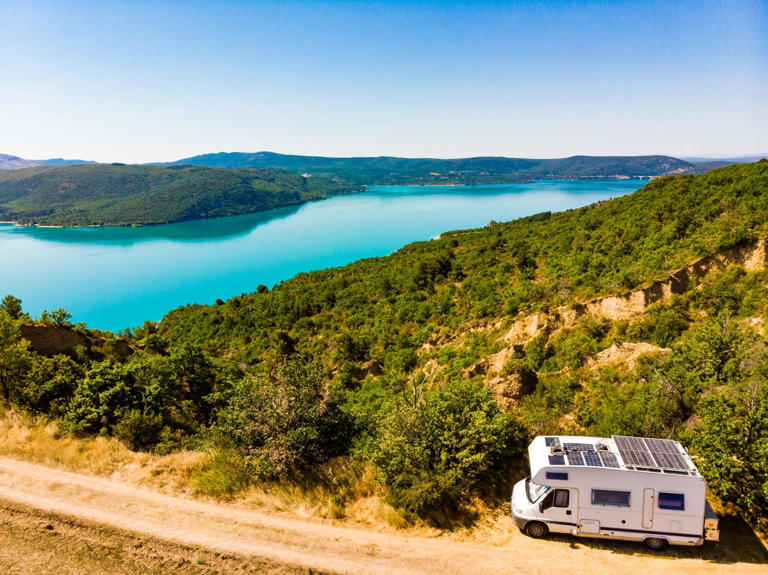
635th Anti-Aircraft Missile Regiment
635-й зенитно-ракетный полк
Military Unit: 86646
Activated 1953 in Stepanshchino, Moscow Oblast - initially as the 1945th Anti-Aircraft Artillery Regiment for Special Use and from 1955 as the 635th Anti-Aircraft Missile Regiment for Special Use.
1953 to 1984 equipped with 60 S-25 (SA-1) launchers:
- Launch area: 55 15 43N, 38 32 13E (US designation: Moscow SAM site E14-1)
- Support area: 55 16 50N, 38 32 28E
- Guidance area: 55 16 31N, 38 30 38E
1984 converted to the S-300PT (SA-10) with three independent battalions:
- 1st independent Anti-Aircraft Missile Battalion (Bessonovo, Moscow Oblast) - 55 09 34N, 38 22 26E
- 2nd independent Anti-Aircraft Missile Battalion and HQ (Stepanshchino, Moscow Oblast) - 55 15 31N, 38 32 23E
- 3rd independent Anti-Aircraft Missile Battalion (Shcherbovo, Moscow Oblast) - 55 22 32N, 38 43 33E
Disbanded 1.5.98.
Subordination:
- 1st Special Air Defence Corps , 1953 - 1.6.88
- 86th Air Defence Division , 1.6.88 - 1.10.94
- 86th Air Defence Brigade , 1.10.94 - 1.10.95
- 86th Air Defence Division , 1.10.95 - 1.5.98

IMAGES
VIDEO
COMMENTS
See all Brand New Dutchmen-Aerolite 2320BHSLs. Shop all Pre-Owned Dutchmen Aerolites (may or may not be solar-ready or equipped). Northwood Snow River 234RBS . Northwood RV claims to provide both comfort and luxury with their 2017 Snow River 234RBS trailer. Under its appealing design, these units boast block foam insulation which is vacuum-bonded to ensure campers can enjoy their Travel ...
The O-V-R lineup offers three models, ranging from a toy hauler to the smaller, 5,200-pound Expedition travel trailer. When purchased with inTech's off-grid package, this rig comes with 400 watts of solar power, a 200-amp hour lithium battery, and a 2,000-watt inverter charger.
Travel Trailers with Built-in Solar Power Escapod TOPO2. Solar power: 140 watts; Exterior length: 12 feet, 3 inches; Unladen vehicle weight: 2,000 lbs. Hitch weight: 200 lbs. ... Several Winnebago trailers now come equipped with built-in solar panels, including the HIKE 100 H1316SB. The 200-watt solar panel delivers reliable power, with an ...
Off-Grid Solar Trailer All in Price $33,950 | Deposit $500 The ultimate solar powered off-grid camper for adventurers seeking the roads less traveled. The GoSun Camp365 is fully equipped with essential appliances for cooking, refrigerating, showering, climate control and sleeping at remote locations or campsites.
Impossibly versatile, exceptionally designed, SolarFlex is shattering customers' expectations of factory solar power. SolarFlex™ eliminates the guesswork, delivering affordable, high-quality RV solar energy systems. For 2024, Keystone has updated each package with upgraded components and added a solar prep option (SolarFlex Ready) for entry ...
Here is what to look for when choosing the best solar powered travel trailers. CyberTrailer Features. Models. Travel Trailers. HD24. From $299,995. HD30. From $399,995. Fifth Wheel Trailers. GT32. From $349,995. GT38. From $449,995 ... Generators are an excellent piece of equipment, supplying high amounts of electricity at the push of a button ...
Our new solar-powered RV packages, Sol - Powered by the Sun, make it easier than ever to harness solar power for your next trip. With three solar-powered RV systems to choose from, you can have a solar package that supplements your typical energy use, or go for a higher tier that powers your RV when you camp off-grid. Energy Savings Learn More.
RV solar panels work just like residential and commercial solar panels except on a smaller, more transportable scale. Once they're installed on your RV, motor home or camper, solar panels collect ...
The new trailer addresses those problems with a compact design that unfolds to 700 cubic feet of space and a height of 7.5 feet. Its solar grid also powers a hot shower, and the trailer includes a ...
Lightweight flexible panels are better suited when an RV roof is molded rather than flat, while portable panels can be placed anywhere on or off the vehicle, so they can capture sunlight even if ...
Honorable Mention: ACOPower 800-Watt OffGrid Solar Power Kit. Best for Large RVs: Zamp Solar 1020-Watt Deluxe Roof Mount Kit. Most Versatile: Kisae 1800-Watt Solar RV Battery Kit. Best Budget ...
Rice cooker: 360 (watts) x 0.5 (hours) = 180 watts. Blow dryer: 1,500 (watts) x 0.1 (hours) = 150 watts. Total: 5 (watts) x 180 (watts) x 150 (watts) = 355 watts per day. Given this example, a 100-watt solar panel would be sufficient enough to generate enough power to charge your battery and run your devices each day.
A typical solar power setup for an RV will consist of solar panels, a charge controller, a battery bank, and an inverter. These components work together to collect, store, and convert solar energy into usable electricity for your RV's appliances and electronics. Some SRRV's can harness a rooftop system or a portable system.
What Are RV Solar Panels. RV solar panels are photovoltaic modules designed specifically for recreational vehicles (RVs) to harness sunlight and convert it into electricity. These panels are composed of solar cells that absorb sunlight, initiating a process where photons from the sun's rays create an electrical current.
I tow a 27-foot travel trailer with a long-bed Toyota Tundra. The trailer is equipped with two deep-cycle batteries with a usable reserve of 100 amp hours. The trailer basically serves as a base camp as my wife and I go out exploring our surroundings during the day via ATV and dual sport motorcycle with our RVing friends.
The Best RV Solar Panels. Best Overall: Renogy 200W 12-Volt Solar RV Kit. Best Value: Eco-Worthy 100W Solar Panel. Best Mounted: Go Power! Overlander 190W Solar Kit for RVs. Best Lightweight ...
Following excellent solar generators like the AC200P and the beastly EP500, Bluetti strikes back with a formidable portable solar panel kit that can make a perfect RV solar panel system.. On a bright su nny day, the Bluetti PV200 200W Solar charges my AC200P solar generator in about 5 hours.. If you're not big on DIY and mounting stuff, you'd be happy to hear that you can get these up and ...
Updated: 05/20/2019 Many of the travel trailers from brands like Forest River, Airstream, and Jayco are coming prewired for RV Solar. This implementation is called the Wired for Solar program. Updated 06/20/2020 Some travel trailers are coming prewired with installed 10 Amp Go Power PWM Controllers. These will handle the Prewired Overlander Kit.
WindyNation 400 watt + 30 amp charge controller + 1500 watt inverter + AGM battery + cables. This is a big, complete, 12-volt RV solar power kit that includes everything you need to get up and running. WindyNation has a long track record in the off-grid energy world, and this kit comes with four 100-watt photovoltaic panels.
Renogy 400 Watt 12 Volt Solar Premium Kit: Best overall. Image courtesy of Renogy. Buy Now: $819.99. Renogy's 400-watt solar kit gets our pick for the best overall RV solar kit. It comes with four 100-watt monocrystalline solar panels, which have a 25-year production warranty and an efficiency rating of 21%.
O ne of the greatest things about RV travel is the ability to go off-grid and totally immerse yourself in nature. The thing is, you will eventually run out of battery power doing so. Many people ...
map to travel: Medvedkovo. Wikipedia. Photo: Antares 610, CC BY 3.0. Notable Places in the Area. Babushkinskaya. Metro station Photo: Aborisov, Public domain. Babushkinskaya is a Moscow Metro station in the Babushkinsky District, North-Eastern Administrative Okrug, Moscow. Sviblovo.
Elektrostal is a city in Moscow Oblast, Russia, located 58 kilometers east of Moscow. Elektrostal has about 158,000 residents. Mapcarta, the open map.
635th Anti-Aircraft Missile Regiment. 635-й зенитно-ракетный полк. Military Unit: 86646. Activated 1953 in Stepanshchino, Moscow Oblast - initially as the 1945th Anti-Aircraft Artillery Regiment for Special Use and from 1955 as the 635th Anti-Aircraft Missile Regiment for Special Use. 1953 to 1984 equipped with 60 S-25 (SA-1 ...
Search 10 Elektrostal' solar panel installation companies to find the best solar panel installation company for your project. See the top reviewed local solar panel installation companies in Elektrostal', Moscow Oblast, Russia on Houzz.